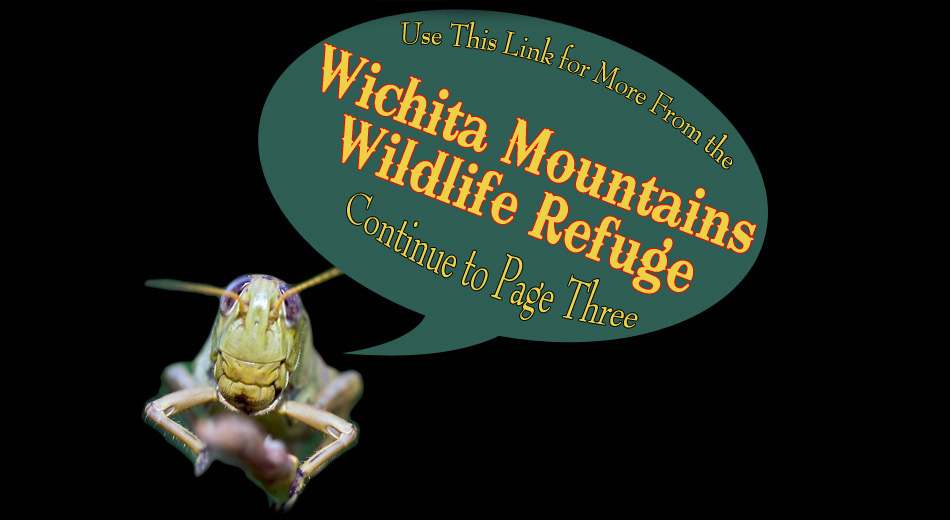
|

|

|

|
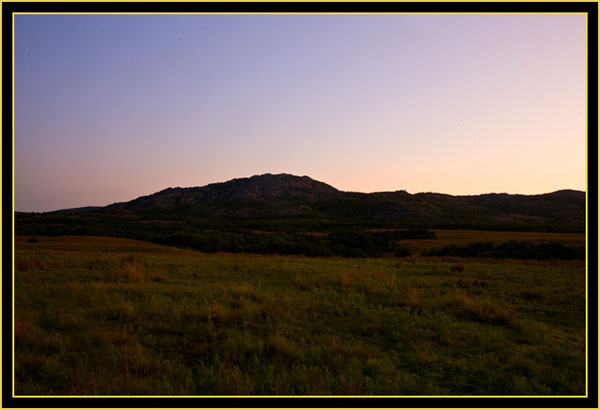
|
Rob had driven us by a location named Boulder Gate when we were in the area yesterday and asked what I thought about this spot to view the sunrise on Saturday. I didn’t know where the sun would come up exactly as I looked around but like every place else in the
refuge, it appeared scenic with wonderful possibilities so I agreed this would be the spot…
Pre-sunrise View in the RefugeCanon EOS Mark III 1Ds on tripod, 1/5 second at 40mm; EF24~105 f/4L at f/13, ISO 800 |
We located in a parking area off the main road. It was almost like a dead-end because there was a gate blocking passage beyond where we parked. This was good because little or no traffic would be coming by from either direction, not that much was expected this
early in the day. Once the sun got up for a time it would be a completely different story. Rob dropped the tailgate and I organized what I thought would be required to capture the moment, setting up the tripods and double-checking the cameras.
Roadway at Boulder GateCanon EOS Mark III 1Ds on tripod, 1/4 second at 35mm; EF24~105 f/4L at f/22, ISO 800 |
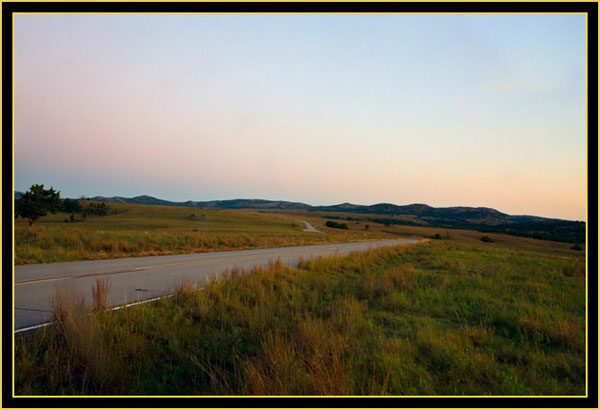
|
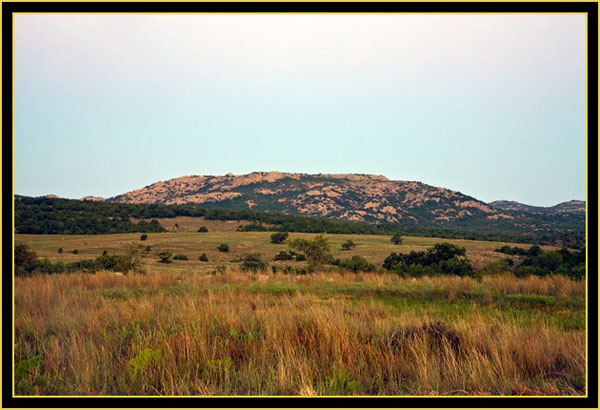
|
When doing non-bird photography I often shoot with a Canon TC-80N3 Remote Timer Controller – a rather ambiguous name for an electronic cable release. Cable releases to trigger the shutter or lock it open as desired have been around forever and although the function is much the same now things
are a bit different with the advent of the digital age.
This device has the ability to control exposures for durations of fractions of a second to hours including functions like time lapse photography, or it can be used simply to trigger the shutter. I use it to accommodate longer exposures in dim light and generally lock
the ballhead down for camera rigidity. This can aid in preventing mirror slap issues and movement from manually pressing the shutter control. This isn’t the case with my use of the 600mm lens on the Wimberley head because technique is critical when shooting
at longer focal lengths – it’s not always as easy as it looks to obtain razor sharp images. I’m certain people are successful locking down a system like this for hands free operation and using a cable release but this in not my preference…
Dawn on the PrairieCanon EOS Mark III 1Ds on tripod, 0.03 second at 85mm; EF24~105 f/4L at f/16, ISO 800 |
We had cloud cover low on the eastern horizon and I indicated to Rob this morning had great potential for color. The refuge was coming alive and Rob was continually scanning for animals moving around in the early light. We were soon to be rewarded with all kinds of
activity. I kept taking exposures as the light was changing dramatically – I thought to myself that it just doesn’t get any better than this… The sun wasn’t even above the distant mountains yet…
Rather than attempt to provide a written description of our exceptional morning’s experience I’ll do so visually below with a sampling of the exposures taken during this Oklahoma sunrise…
Rob on the Visual Hunt...Canon EOS Mark III 1Ds on tripod, 0.06 second at 82mm; EF24~105 f/4L at f/16, ISO 800 |
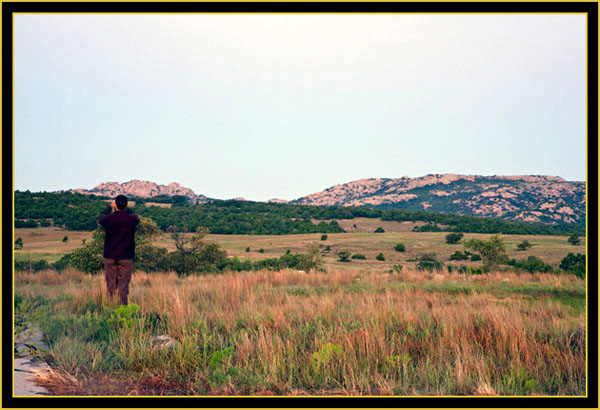
|
From Astronomical Twilight...
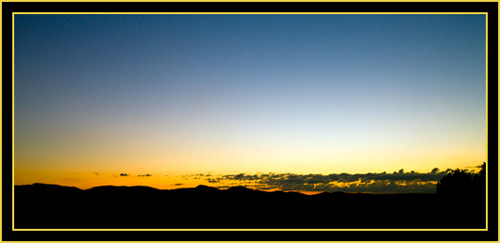
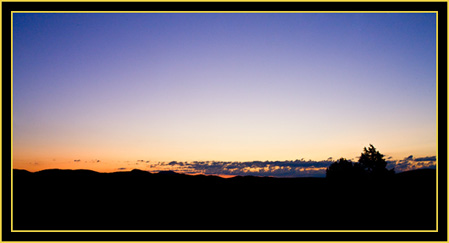
|
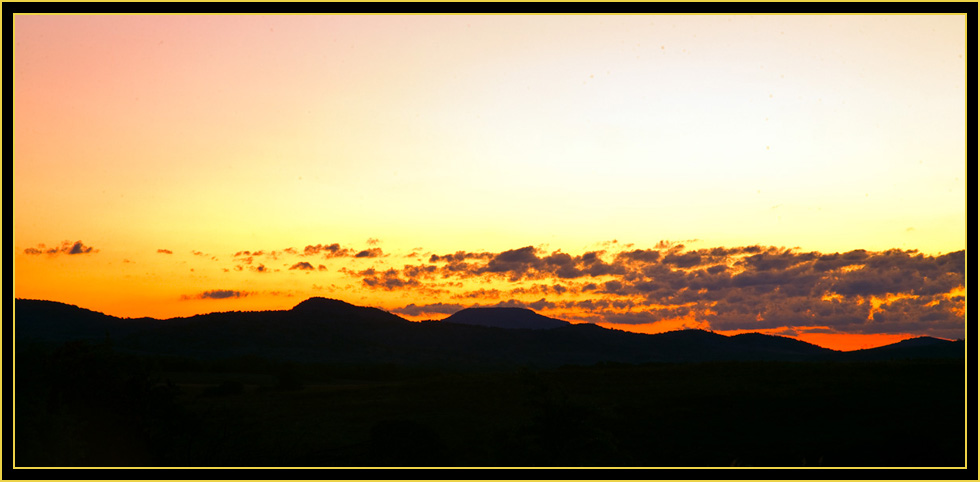
|
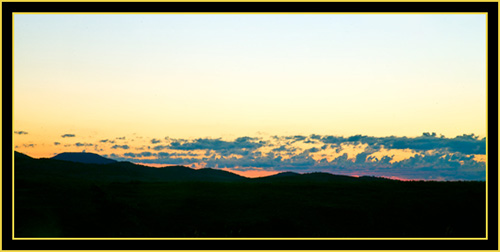
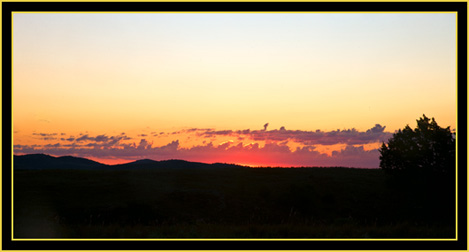
|
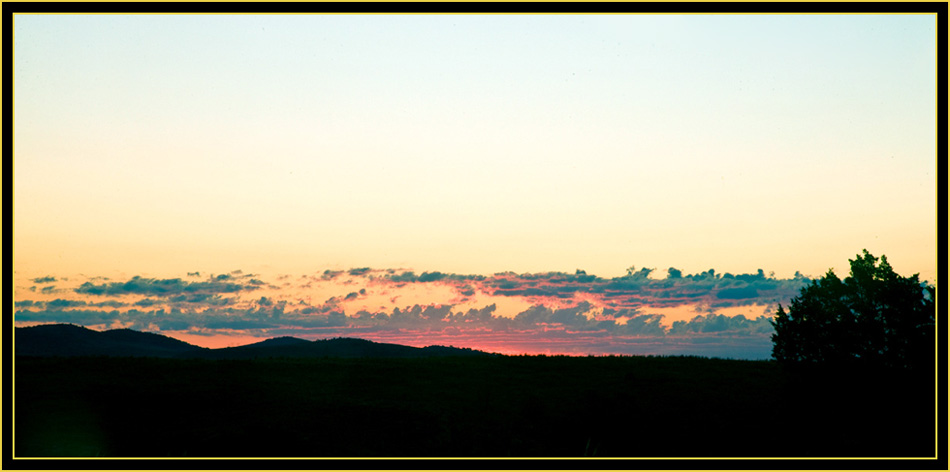
|
To Sunrise in the Wichita Mountains Wildlife Refuge...
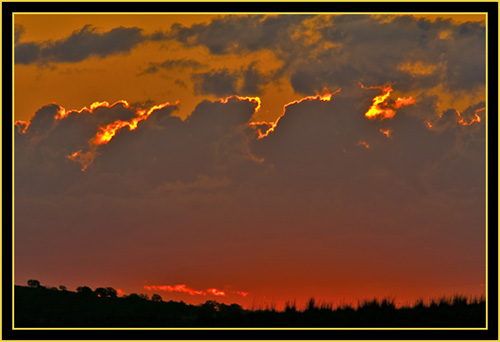
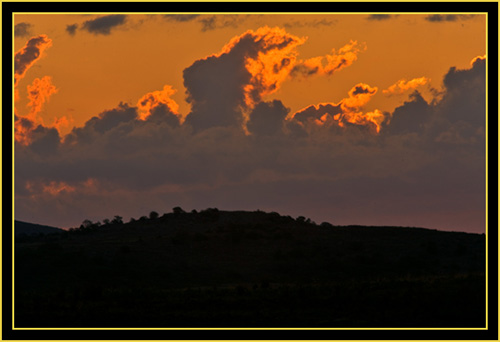
|
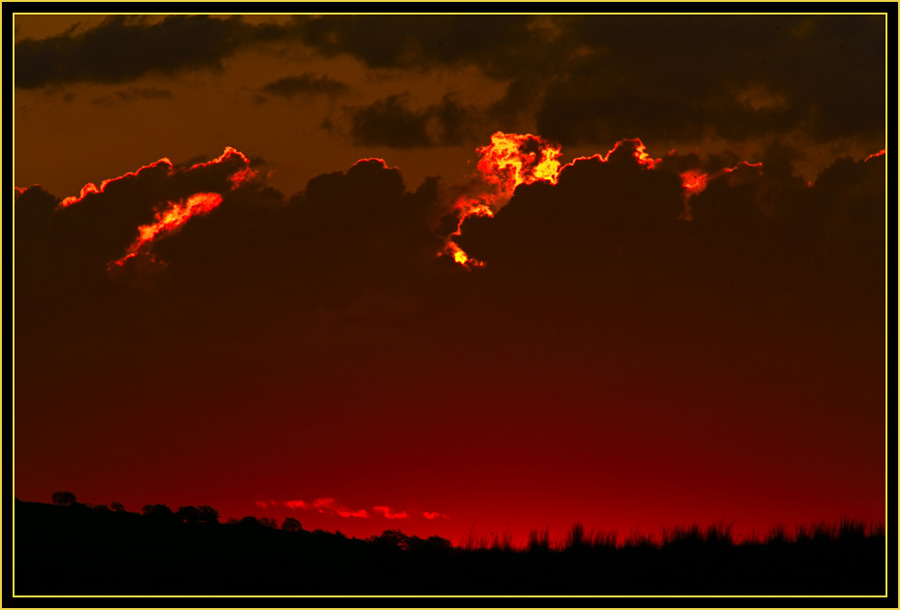
|
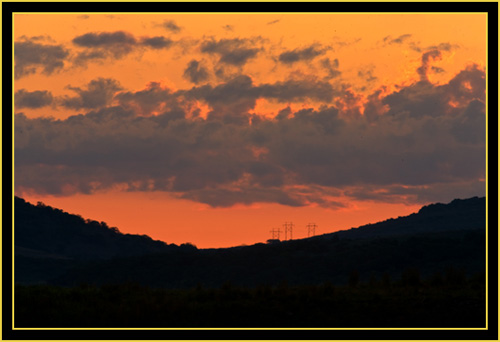
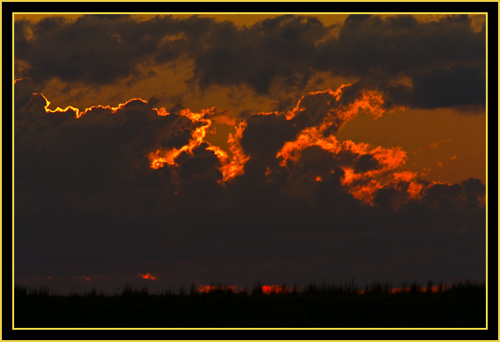
|
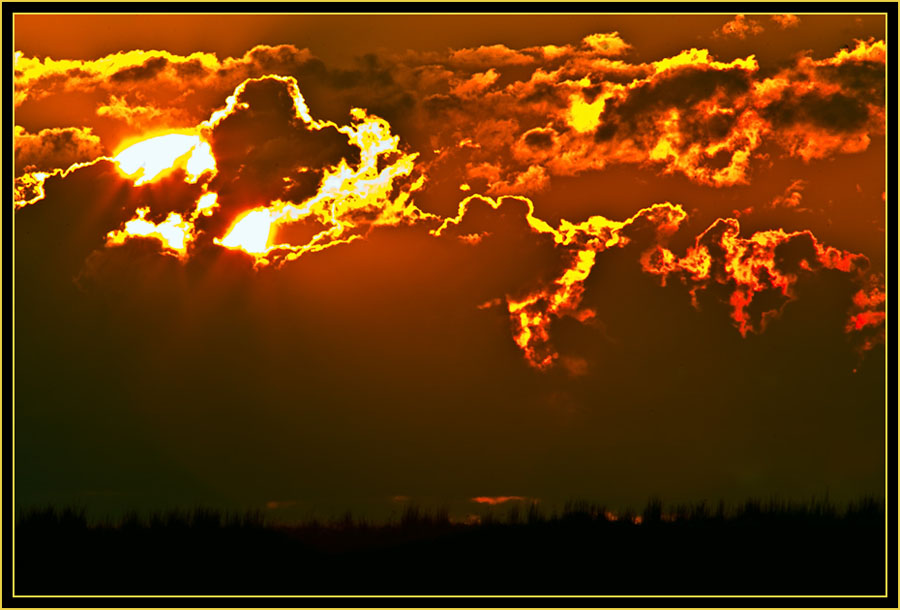
|
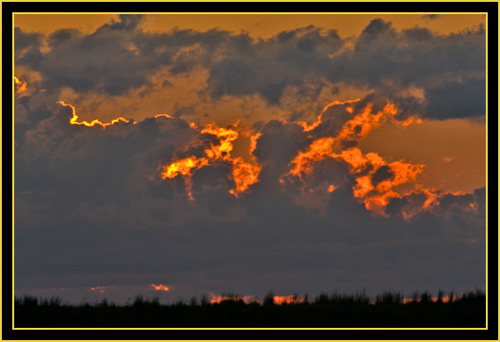
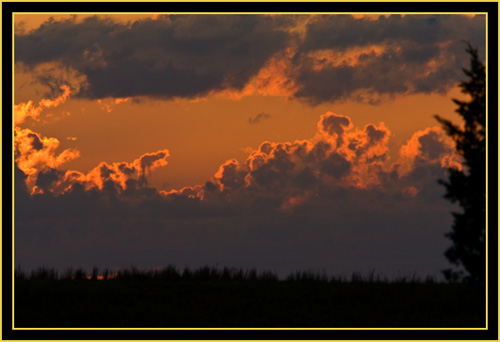
|

|
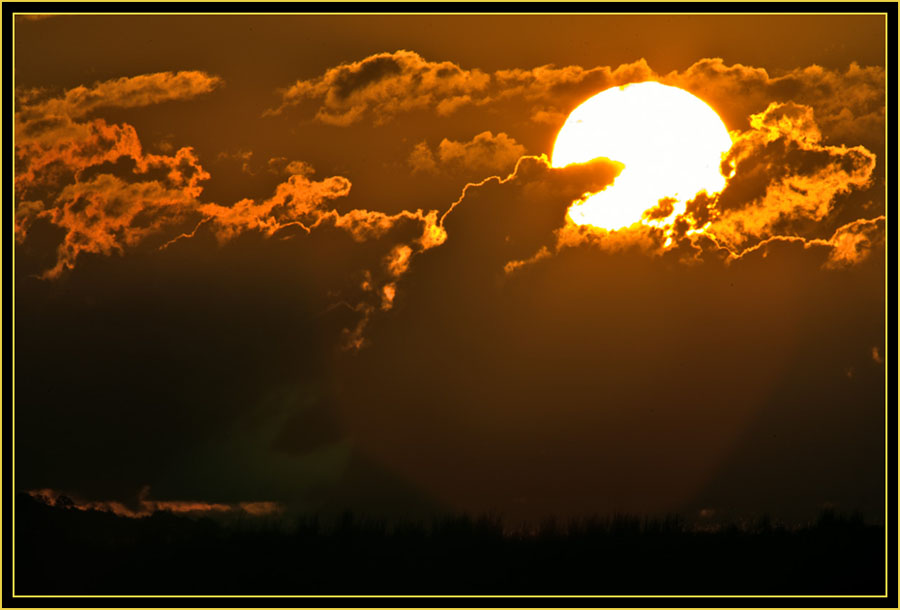
|
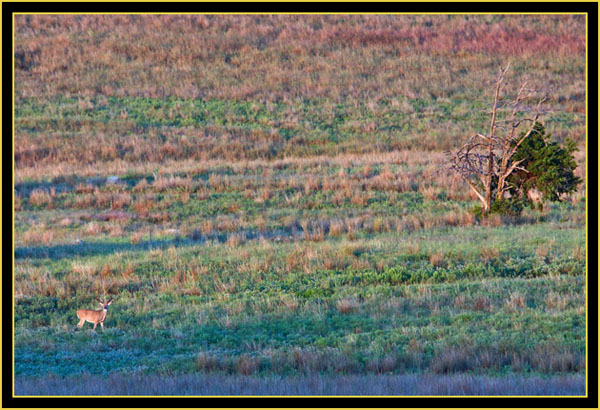
|
The sun was up and the many animals in the area were up and moving about as well as they started their day. We were in a great location to take advantage of all this activity – in the next hour or so we
had opportunities to view deer, elk, coyotes, wild hogs, wild turkeys and a few other birds.
White-tailed Deer WatchingCanon EOS Mark III 1Ds on tripod, 1/125 second at 840mm; EF600mm f/4L + 1.4X at f/8, ISO 640 |
There was little doubt that now was the time to be here I thought as I looked around. The landscape was beautiful bathed in morning light and Rob was calling out distant sightings from movement in the prairie
heading up towards higher ground. It appeared the elk and deer were heading into the tree line to start the day. Although not close by we had plenty to observe.
Pair of Rocky Mountain ElkCanon EOS Mark III 1Ds on tripod, 1/320 second at 840mm; EF600mm f/4L + 1.4X at f/8,, ISO 1000 |
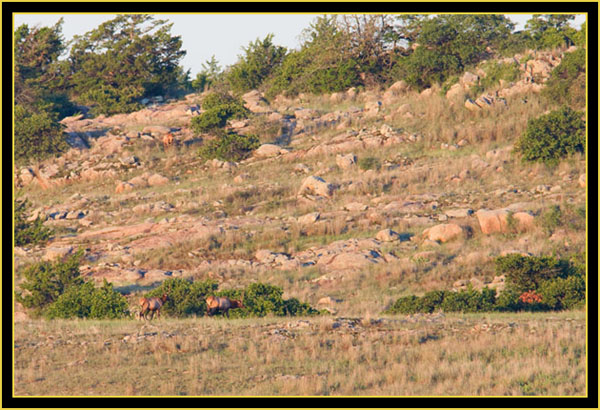
|
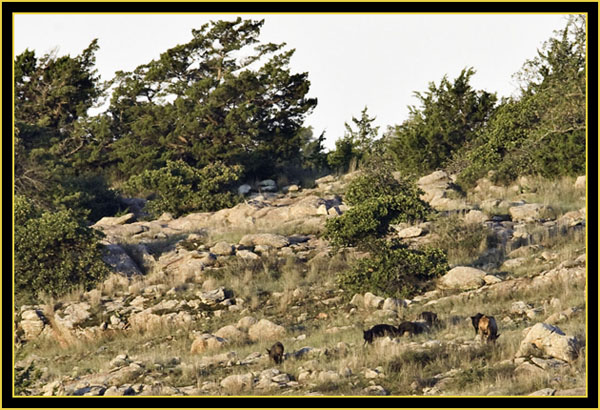
|
Wild Hogs & Elk ForagingCanon EOS Mark III 1Ds on tripod, 1/250 second at 840mm; EF600mm f/4L + 1.4X at f/8, ISO 1000 |
I learned that at one time Wild Turkeys were fairly well eradicated in the Wichita Mountains similiar to other animals. Later, with the planned re-introduction of species to the refuge, turkeys were transplanted from Missouri & Texas - now the population is thriving. And not just in Oklahoma – Wild Turkeys are
doing well all over the northeast from what I can see and I know many folks in Maine who have them as constant visitors around their homes. These Wichita Mountains turkeys appeared brighter and more colorful than their northern counterparts from what I could tell.
Wild Turkey GroupCanon EOS Mark III 1Ds on tripod, 1/320 second at 840mm; EF600mm f/4L + 1.4X at f/8, ISO 1000 |
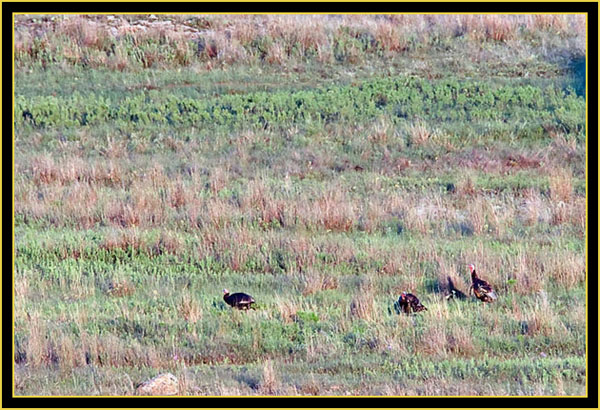
|
Morning Photography in the Refuge...

|


|


|
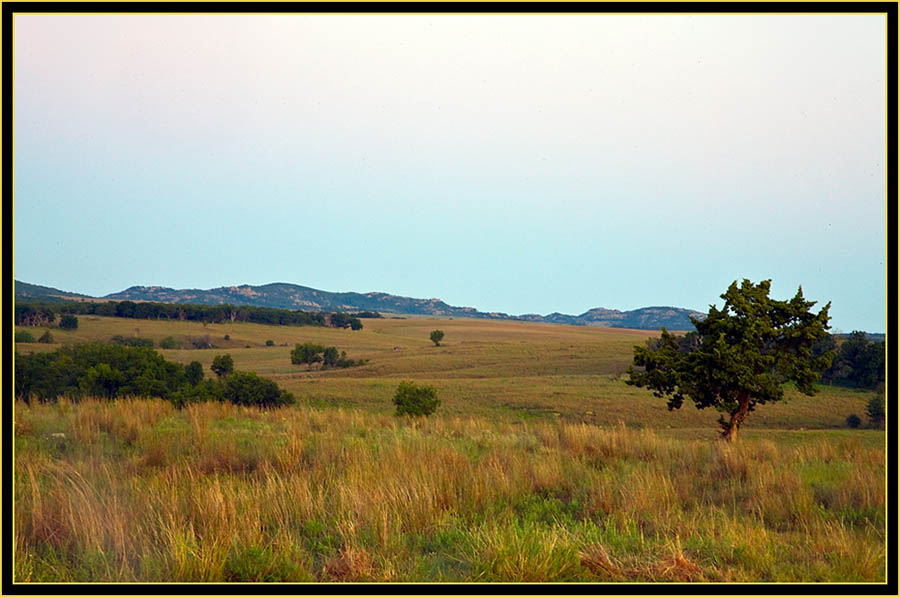
|
Open Country...
Canon EOS 5d on tripod, 1/500 second at 70mm; EF70~200 f/2.8L at f/8, ISO 640

|
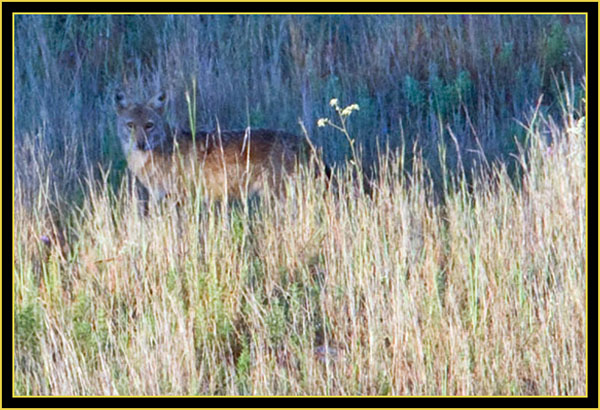
|
Rob spotted three coyotes moving through the grass and I swung the lens to see if I could locate them on the move. They were moving quickly and would soon be in tree cover but I was able to get a few shots off before they were out of view.
The one seen here turned to look us over before entering cover.
Coyote Turning to Check us OutCanon EOS Mark III 1Ds on tripod, 1/250 second at 840mm; EF600mm f/4L + 1.4X at f/8, ISO 1000 |
Rocky Mountain Elk


|
|
I wasn’t having any problem finding photographic subjects… So much around me was new and different compared to other areas I've had the pleasure to visit. We didn’t forget about ‘the list’ from headquarters and reviewed this to keep the information fresh in our planning. I never
stopped taking exposures as Rob and I talked and moved about. The experience so far this morning differed a lot from yesterday’s long day in the field. I knew there was much more to come…
I like trees as subjects… They make excellent foreground material for landscapes and there were many interesting trees in this area. Soon we’d be moving on so I took time to photograph a few. This one at right was one of my favorites… Morning Light on Prairie TreeCanon EOS 5d, 1/500 second at 200mm; EF70~200 f/2.8L at f/5, ISO 400 |

|
Morning Animals...
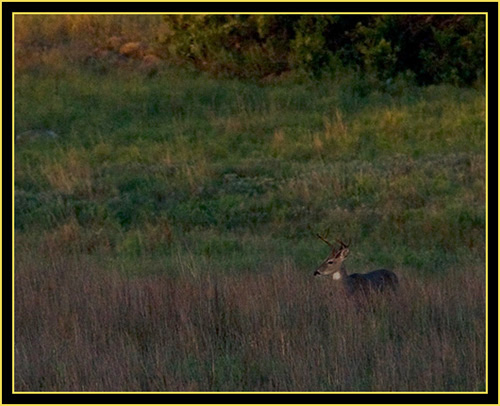
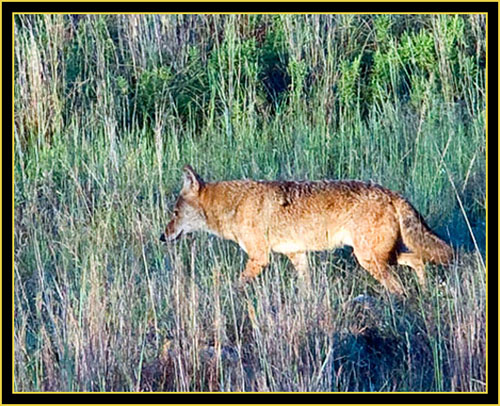
|
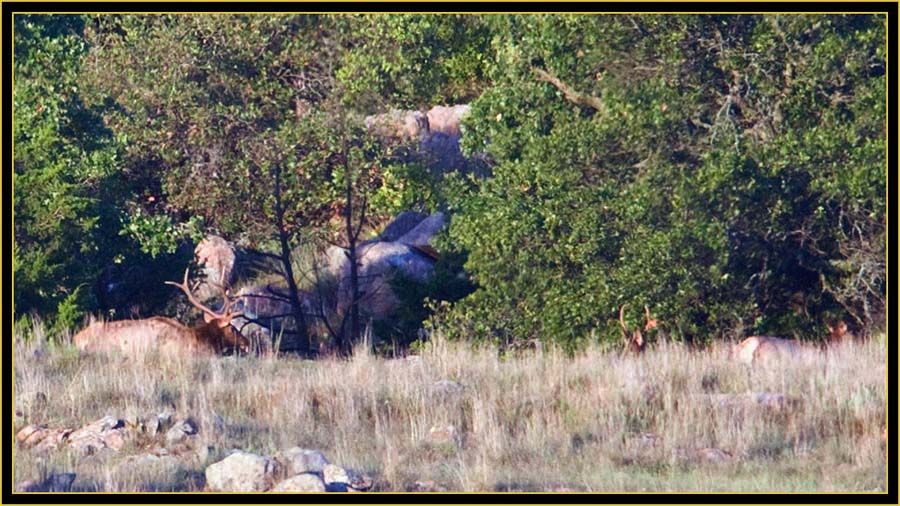
|
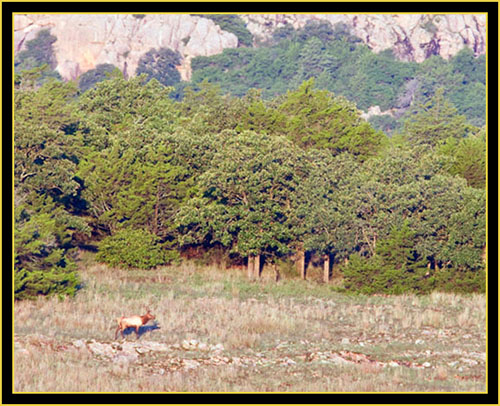
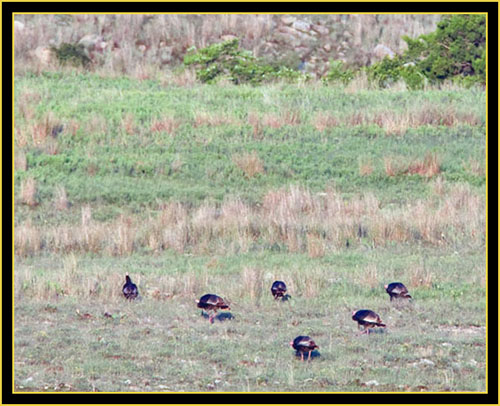
|
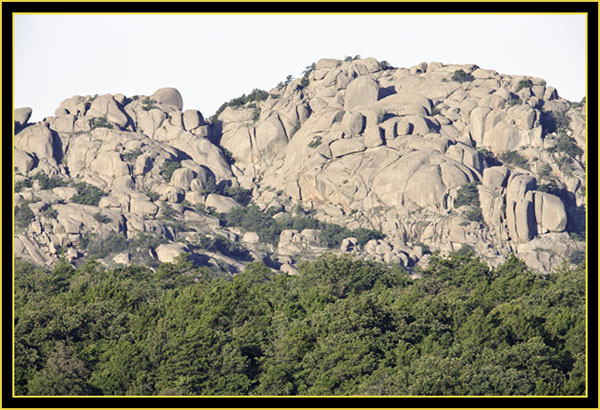
|
We’d been at Boulder Gate for more than two-hours by this time and decided to move on. We had a visitor or two before packing up the truck – I believe seeing the 600mm lens on a tripod does tend to draw interest, but at least one
pair of guys were like us, seeking out elk and other animals in the morning light.
This was Saturday and we had a few things to account for in our refuge travels where it was outside the normal workweek. Rob had been informed that a group of volunteers would be conducting a trash pick up along the road somewhere near the Visitors Center. This volunteer effort would be completed by noon and we were asked to get some photographs of the workers in action if possible. Secondly, we planned to meet Ms. KK and daughter Abigail about the same time as well so we could do some activities jointly. I was pleased about this and KK had informed me that the time of going without food and water were over; she was coming prepared – I laughed and expressed my delight with this news… Trees and LedgeCanon EOS Mark III 1Ds on tripod, 1/640 second at 840mm; EF600mm f/4L + 1.4X at f/8, ISO 640 |
We were packed and moving again. I spotted a Scissor-tailed Flycatcher sitting on a fence along the highway and mentioned this to Rob. He asked if I wanted him to turn around and go back – and this is what we did. Of course by the time
we returned the bird was long gone but we were pulled over safely – not always so a simple task I learned – so we got out to check around. On the opposite side of the road from the fence was an open area and we could see and hear a good
bit of Eastern Meadowlark activity. There were a pair frequenting a ledge probably forty-yards into the prairie and ultimately we walked out to see if we could close the distance for an exposure. I must comment – this refuge is
remarkable… We walked into the grassland at random and there were subjects of interest everywhere…
View into the PrairieCanon EOS Mark III 1Ds on tripod, 1/3200 second at 840mm; EF600mm f/4L + 1.4X at f/8, ISO 640 |
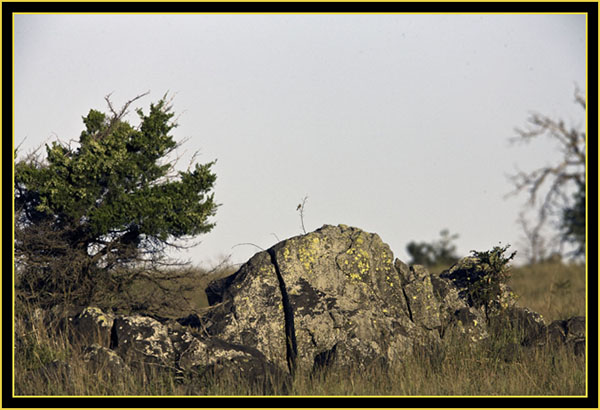
|
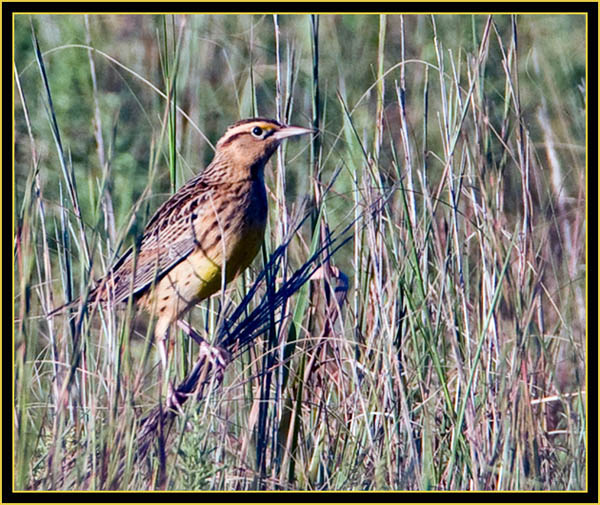
|
We spent time with the Eastern Meadowlarks as they went about their business. They would perch, sing for a bit and then move on. There wasn’t much we could do to close the distance but we hung around the ledge area and watched hoping a
bird would make an approach near the tripod. The grass here was deep enough that they could easily be close and out of sight. We knew this was the case because now and then one would flush in our path, too late for a shot of course…
I've been asked what I think is 'close' photographically on several occasions. My usual response is it depends on the size of the subject somewhat, but if it's a perching bird and I can get his/her eyeball
to fill my viewfinder and still obtain critical focus then I figure I'm close enough... If I could only obtain one exposure I'd take a detailed head shot first and foremost every time.
Eastern Meadowlark in the GrasslandCanon EOS Mark III 1Ds on tripod, 1/1000 second at 840mm; EF600mm f/4L + 1.4X at f/8, ISO 640 |
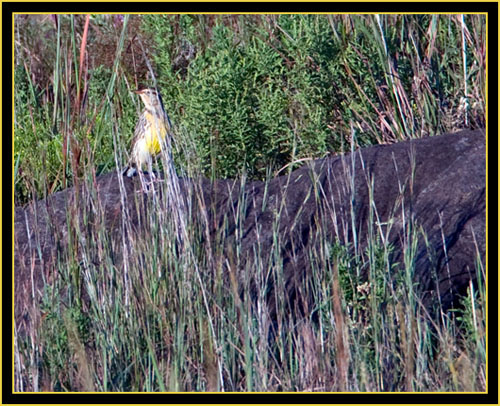
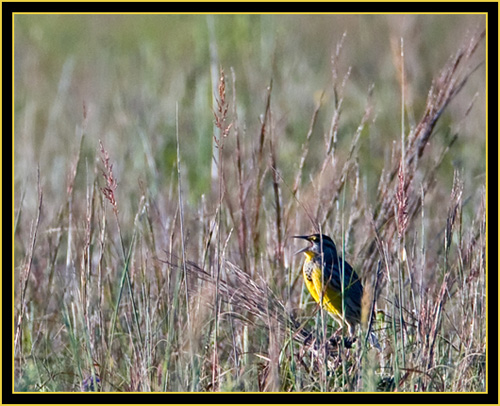
|
Trees in the Refuge
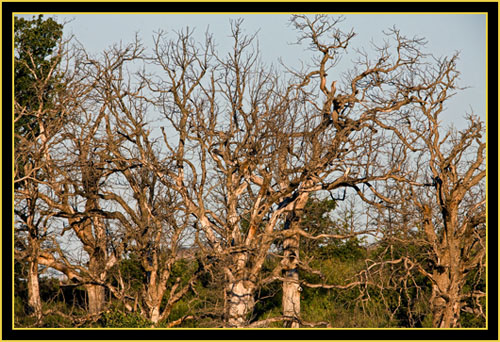
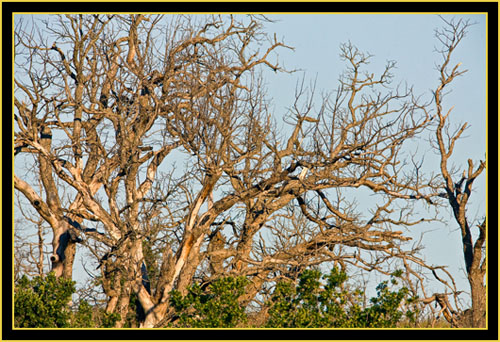
|
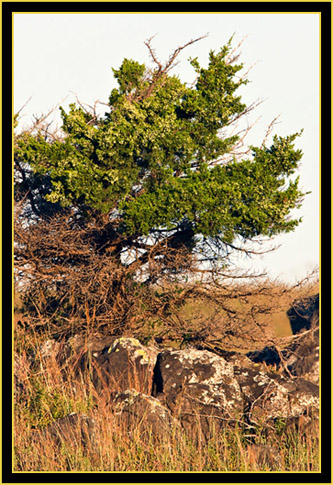
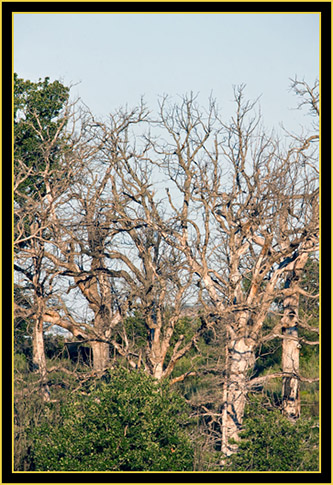
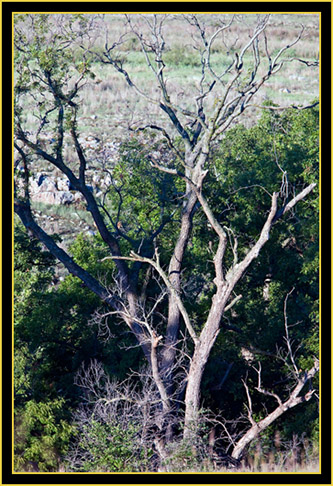
|
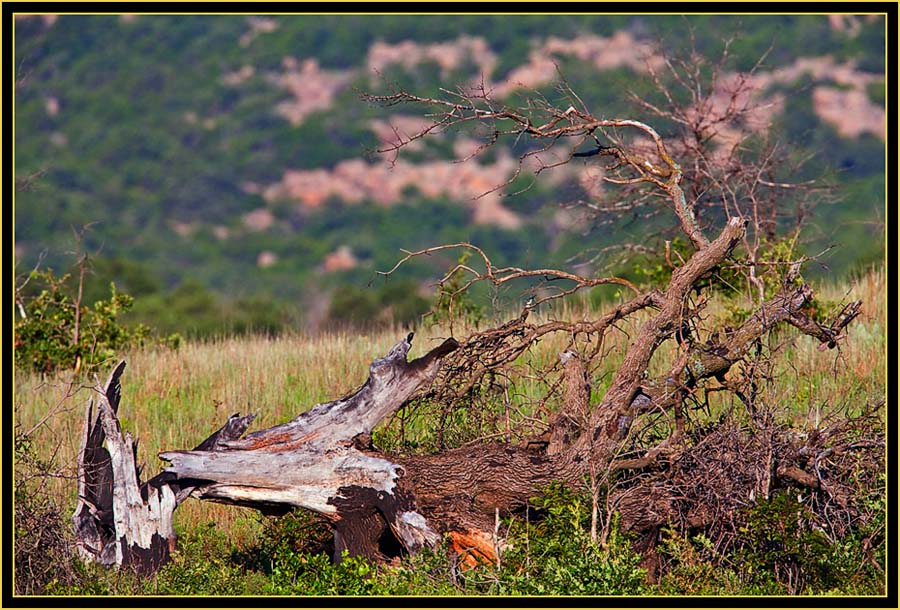
|
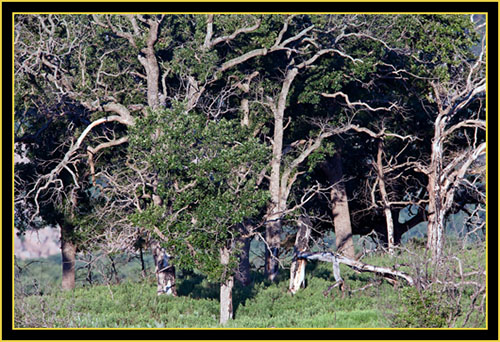
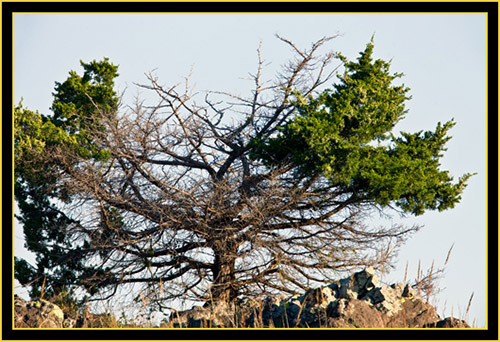
|
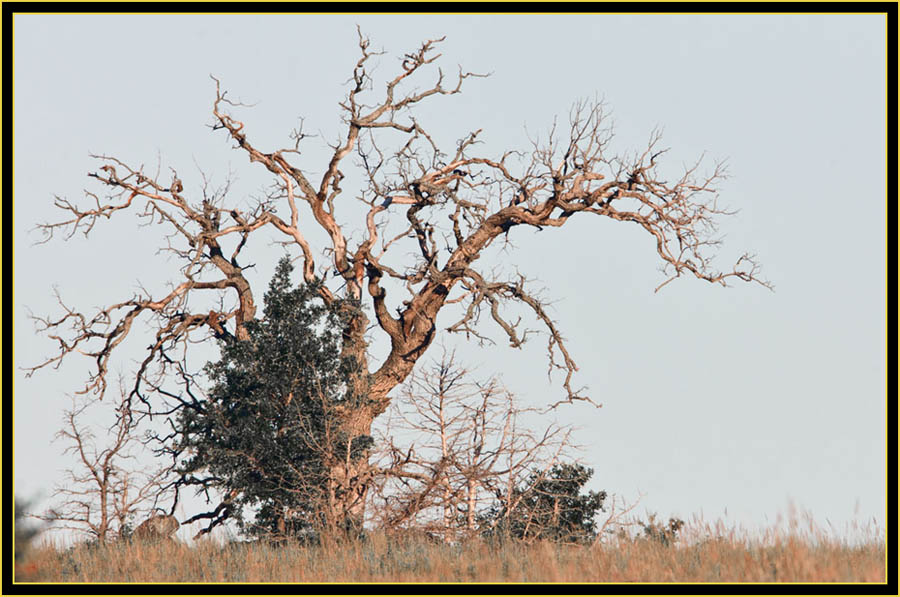
|
When Rob and I had visited the headquarters building we had an opportunity to discuss the image list with Chip and other staff. I was informed that they really didn’t need any bison, prairie dog or longhorn shots – I mean think about
it – they must have a bazillion shots of these animals common to the refuge in file… However, I didn’t have many in my archives so I didn’t miss many opportunities to photograph any animals as we traveled around. Plants and
the prairie grasses in different stages of lifecycle is something they could always use more of though. I was in the midst of the grassland with my tripod and long lens which is a real benefit in situations like this. Unless shooting
close up you require enough height to obtain an unobstructed line of sight to the subject – my heavy duty tripod was great for this. I took a series of shots just within focus range at 840 millimeters. As you view the template below
please keep in mind that these images are significantly reduced from the primary files. You can see the surrounding beauty of the place but much of the impact is lost at such a reduced scale…
Land of the Prairie DogsCanon EOS 5d, 1/640 second at 70mm; EF70~200mm f/2.8L at f/9, ISO 400 |

|
Plants in the Grassland
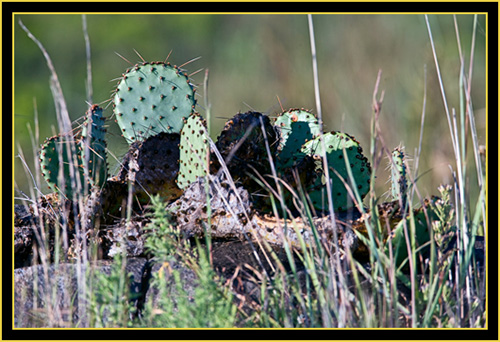
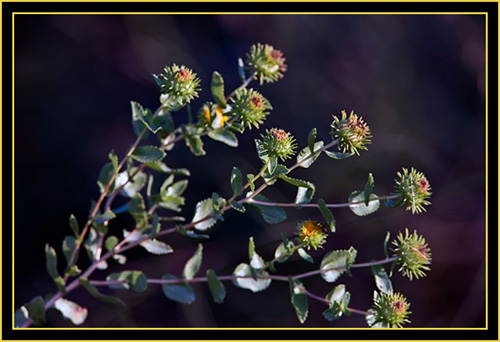
|
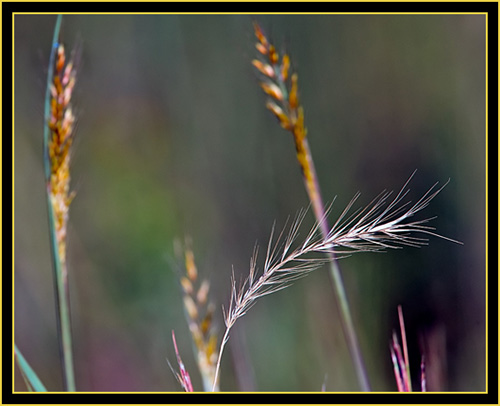
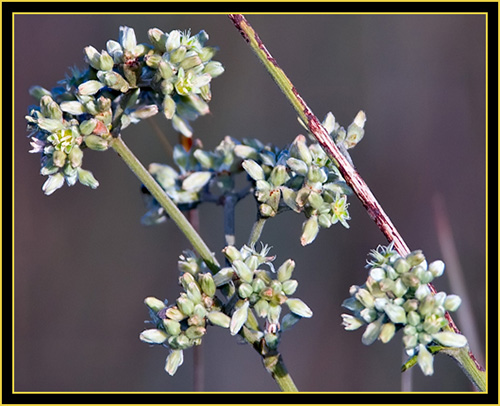
|
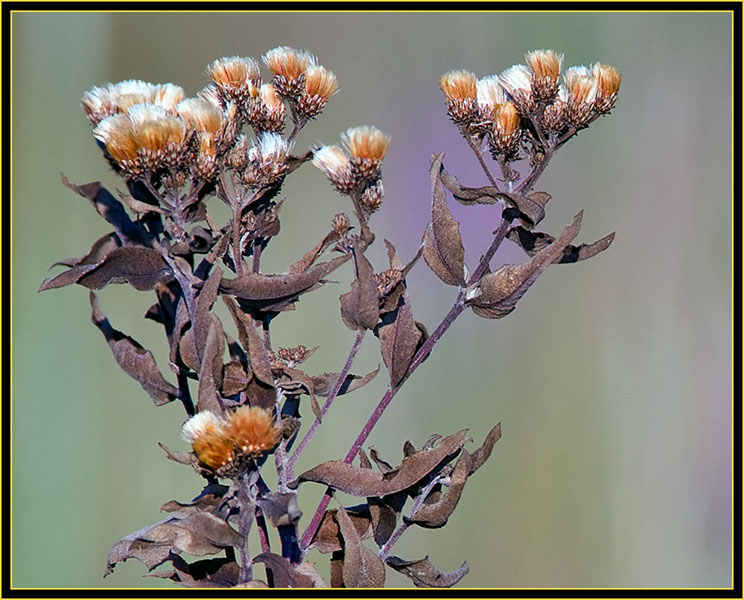
|
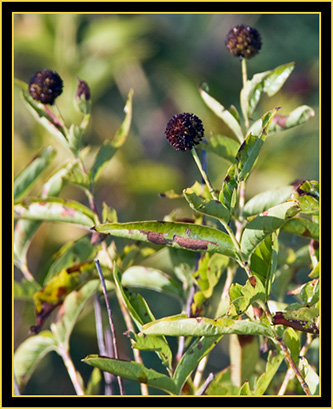
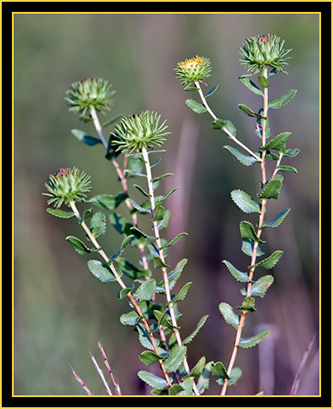
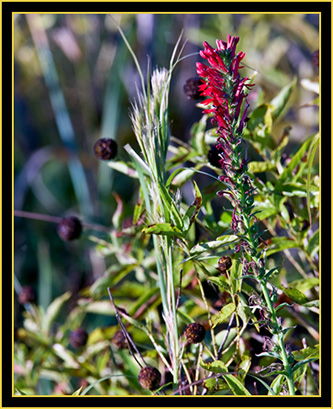
|
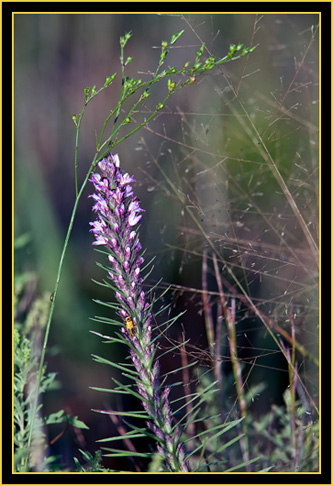
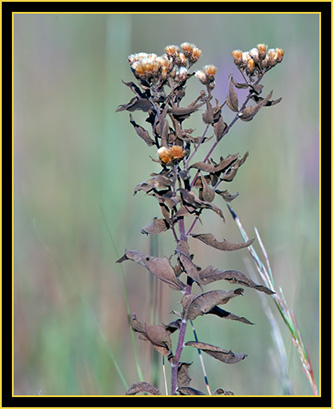
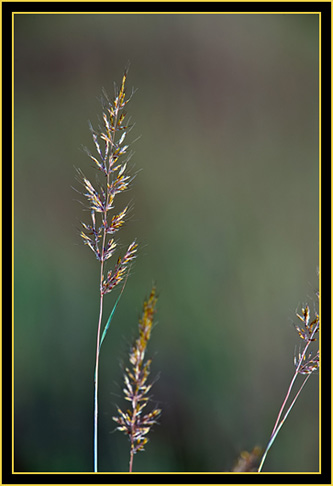
|
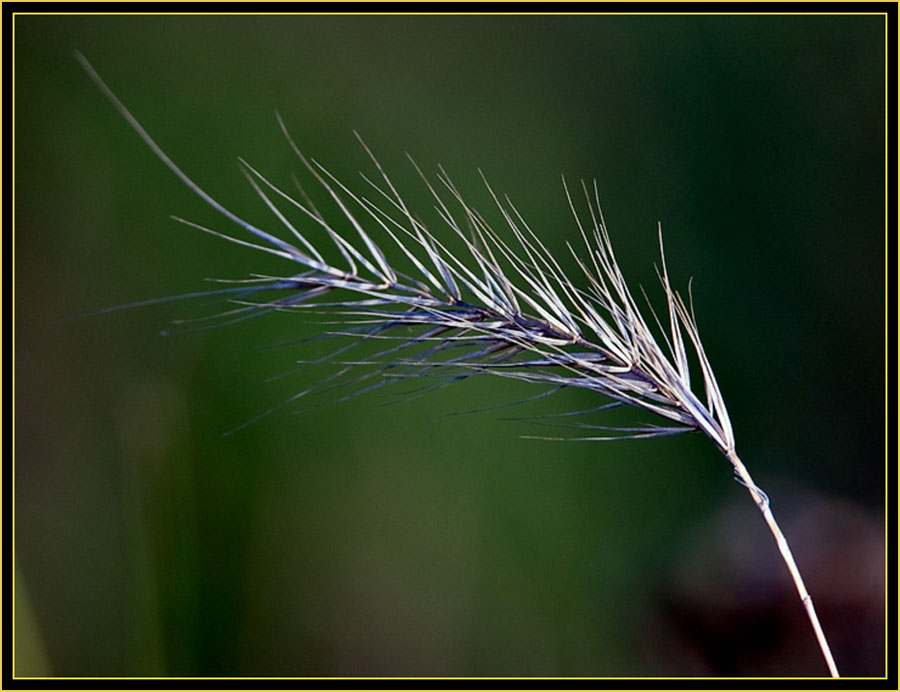
|
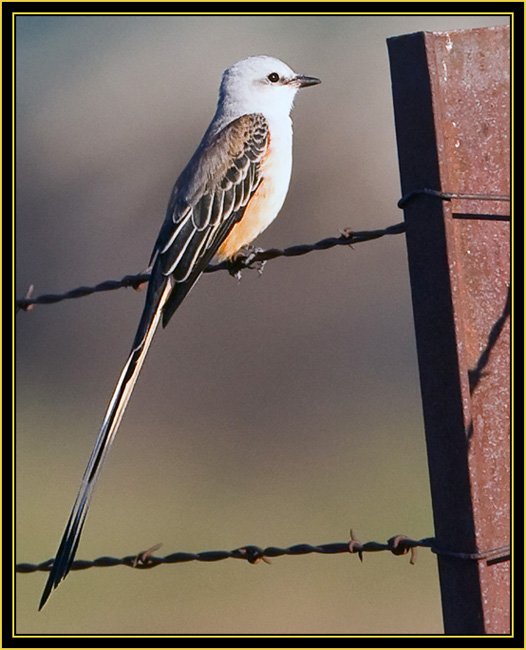
|
Packed and traveling again we discussed where we had to be and when to make certain nobody was waiting for us. It was decided we still had time available and not wanting to waste a minute we kept seeking opportunites. Driving along I again spotted some
Scissor-tailed Flycatchers perched along the fence
on one side of the road and a few more in some bushes thirty or forty yards off the roadway on the opposite side - all good news in my view except for the dilemma of which group to approach first for the best photographic
advantage. Rob pulled the truck off the road and I got out, pulled the tripod from the truck bed and went off to learn if I could make a closer approach on the birds on the fence first.
Sissor-tailed Flycatcher on the FenceCanon EOS Mark III 1Ds on tripod, 1/1000 second at 840mm; EF600mm f/4L + 1.4X at f/8, ISO 640 with flash |
After the fence-perched birds moved on I re-crossed the road and walked into the area closer to the bushes to try a few exposures.
These birds are really colorful and quite striking with their long tails. They may be considered common in these parts but I knew they would be new to my Bird Photography Index
not being found in my home location, so I
planned to approach as closely as possible taking insurance shots along the way to obtain the best exposures I could manage. I didn’t get really close as I’d hoped - like most, these birds have a wide ranging 'comfort zone'
but the distance was sufficient to achieve the goal of some acceptable shots to upload.
Scissor-tailed Flycatcher in the BushCanon EOS 5d, 1/1250 second at 840mm; EF600mm f/4L + 1.4X at f/8, ISO 640 with flash |
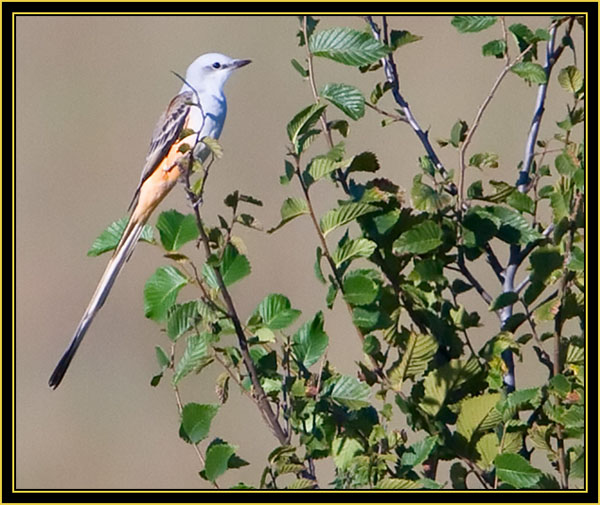
|
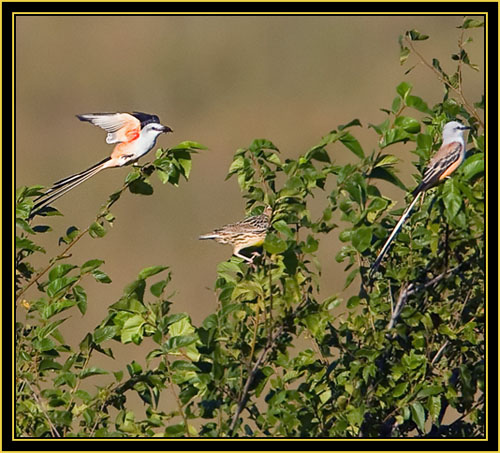
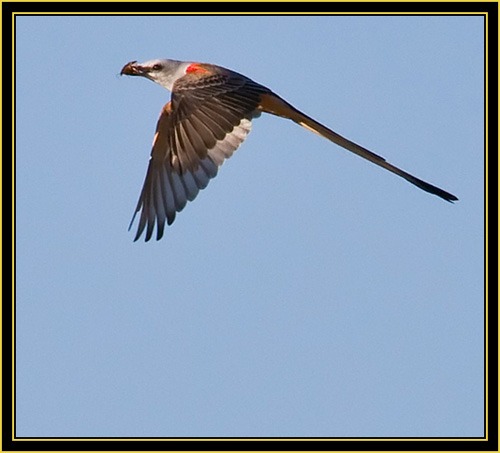
|
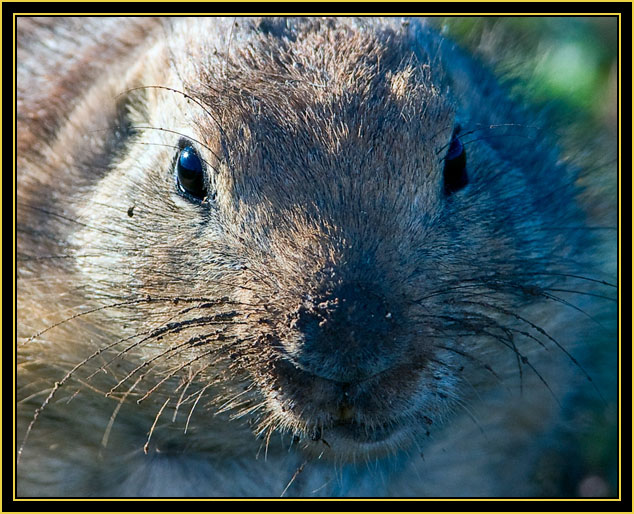
|
We’d found the birds close to Prairie Dog Town - the resident prairie dog village. This is a major draw for refuge visitors and is generally an active spot along the road through the facility with easy on/off access and parking. ‘The list’
included images of visitors to the facility doing various activities and we considered viewing the prairie dogs as one of them, so we meandered over to have a look. It was relatively early still and few people were in the
area but I took a few shots of a family group viewing over the fence. Certainly the refuge photographic archives were loaded with these critters but I wanted a few shots for mine, plus you just never know what they have
in file and if it could be improved upon - every photographer can bring a different perspective... We didn’t stay long but I enjoyed the time spent watching these animals going about their daily routine. I wanted to get ‘up close and personal’ and attempted to draw some subjects
close in to the fence…
Face View - Black-tailed Prairie DogCanon EOS Mark III 1Ds on tripod, 1/800 second at 840mm; EF600mm f/4L + 1.4X at f/8, ISO 640 with flash.If looking at the camera data you’ve most likely figured out I was shooting in Aperture Priority at f/8 most of the morning. I judged this to be the best compromise of shutter speed and depth of field at the time… |
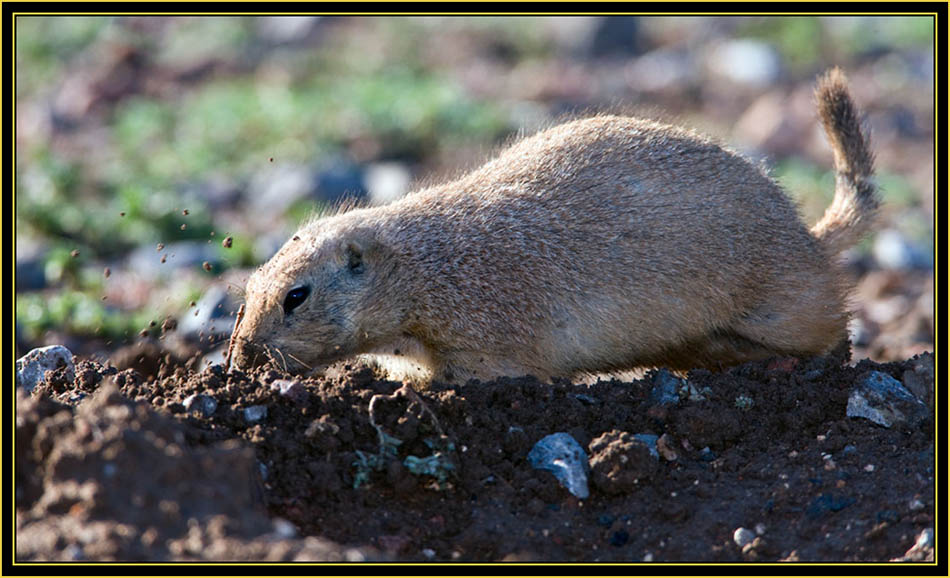
|

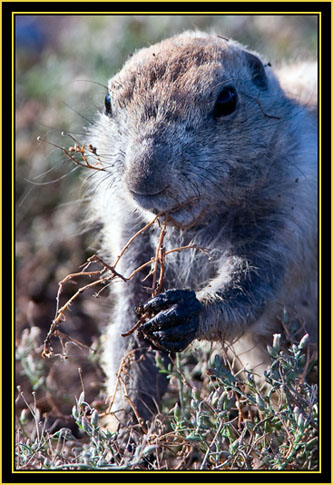
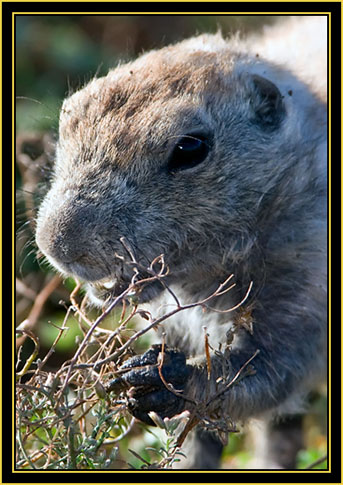
|
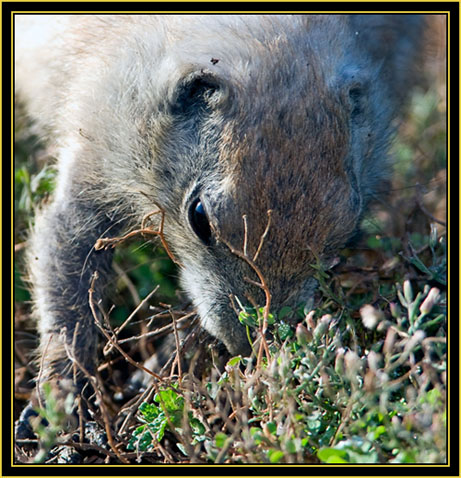
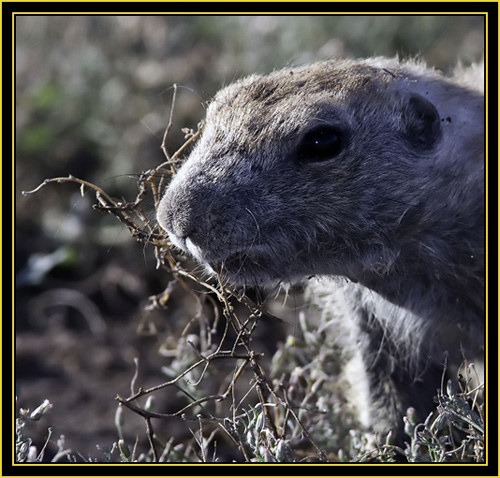
|
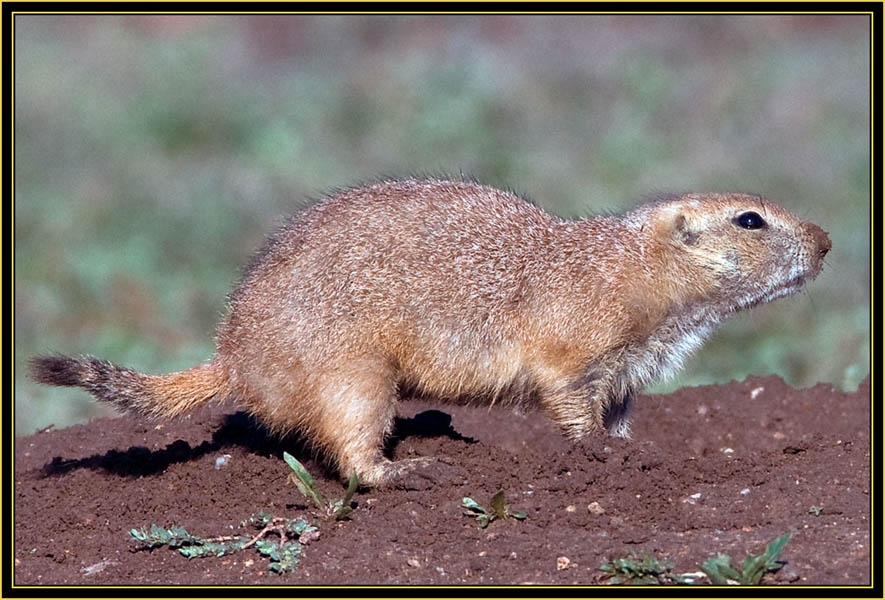
|
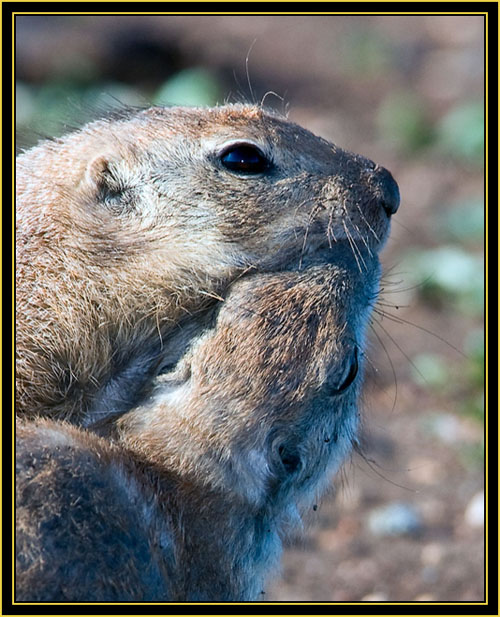
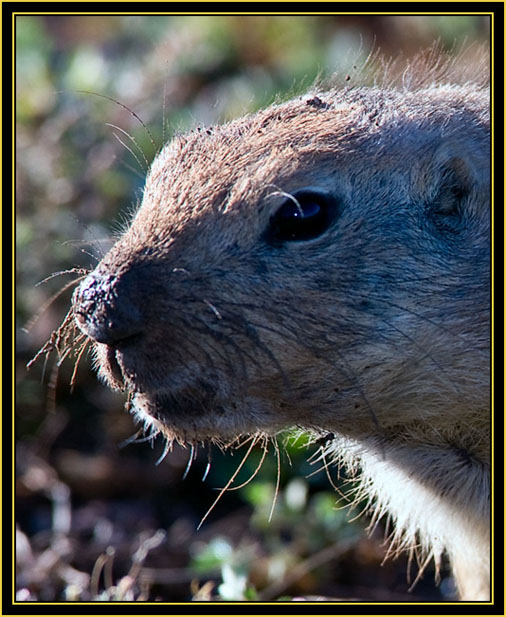
|
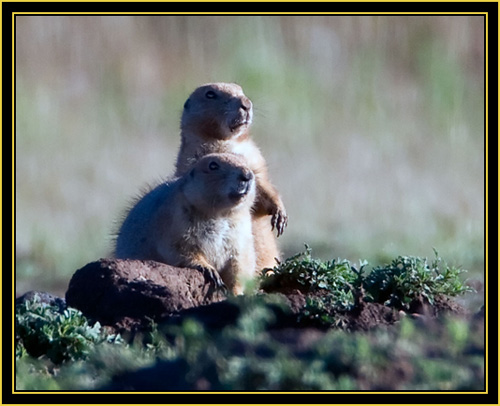
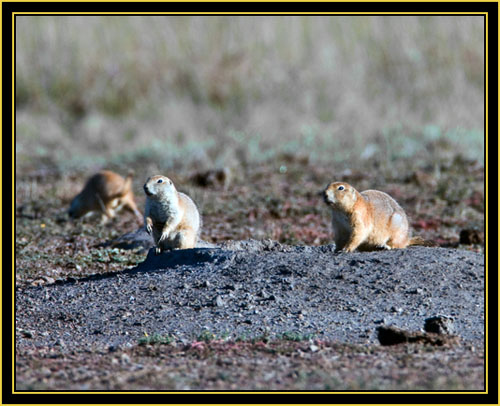
|
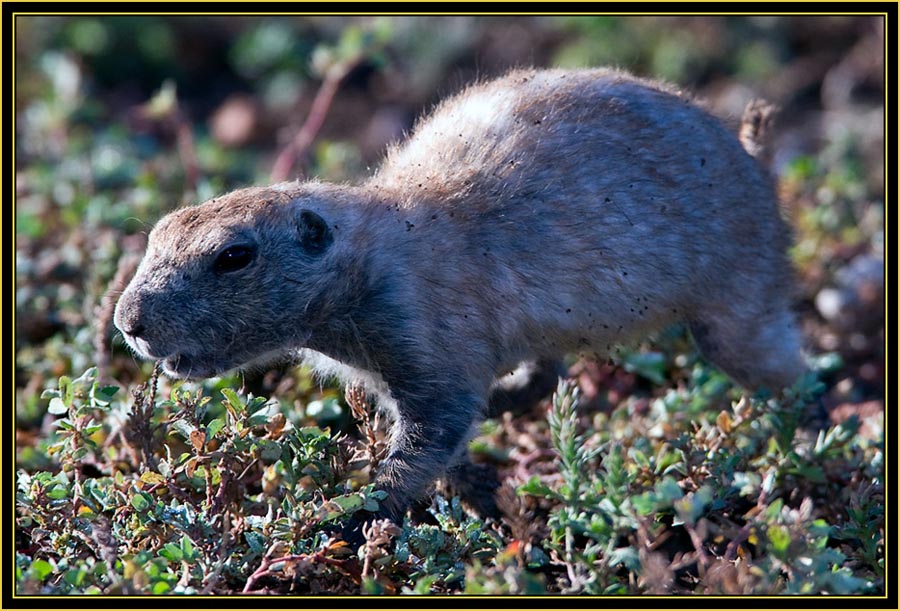
|
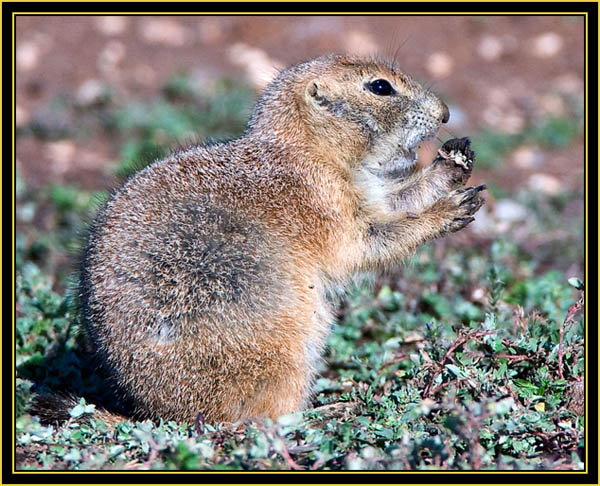
|
Rob and I discussed the effort to introduce Burrowing Owls in the refuge. These owls use the burrows of prairie dogs to establish nesting holes and are often found along with them in places in the west. He indicated this has been attempted although the results to his knowledge did not appear successful.
We discussed re-visiting French Lake at some point this morning. I’d seen the most bird activity at this location - subjects I’m always prepared to seek out –and thought we may have some luck today. So we left the prairie dogs to learn what we may find next… Black-tailed Prairie Dog ForagingCanon EOS Mark III 1Ds on tripod, 1/1250 second at 840mm; EF600mm f/4L + 1.4X at f/8, ISO 640 |
As Rob parked the truck and we walked in some avian activity was noted around the lake. We knew from yesterday’s visit where the Red-Headed Woodpeckers would be most
auspicious and headed into the trees. There was some
human activity going on as well but the place was quiet – another beautiful morning in the refuge I thought to myself – I could really learn to like this place. Of course, getting into the Wichita Mountains Wildlife
Refuge from my home location represented considerable effort and expense… The resident Belted Kingfisher was present and as we observed this bird’s activities I
was in a fine position to photograph a water strike as
viewed at right. The kingfisher wasn’t successful this time but it was a nice action shot with bird and disturbed water – if only I’d have been closer I thought…
Belted Kingfisher StrikeCanon EOS 5d, 1/1600 second at 840mm; EF600mm f/4L + 1.4X at f/8, ISO 640 with flash |
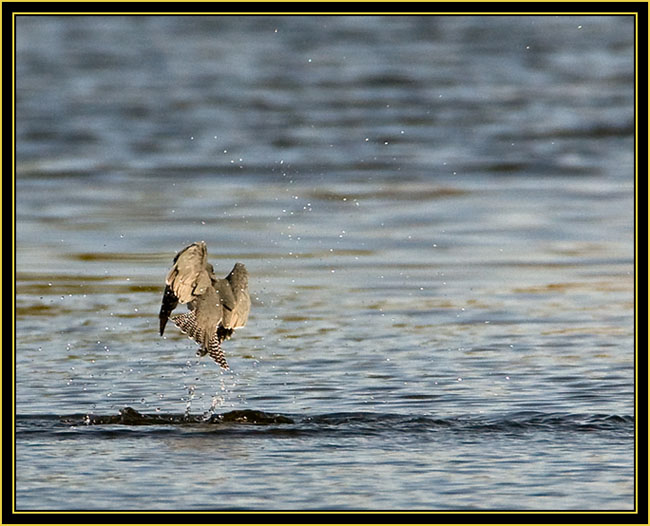
|
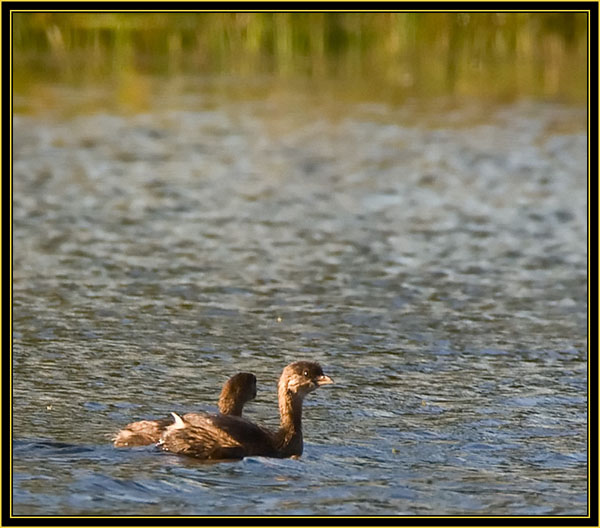
|
We also had the pleasure of observing a pair of Pied-billed Grebes moving around the lake. This wasn’t wholly surprising – I’ve photographed these birds in many locales in the east – finding them here this time of year
was great. Rob and I observed their behavior as they wandered lazily around the water not far from the opposite shore. These rather secretive birds always know when you’re around and if spooked or sensing danger
will immediately dive. I’ve learned they can stay under for a considerable time and swim great distances under water – especially if you’re waiting for a shot.
I remembered spending a good deal of frustrating time and effort in Virginia attempting to photograph Pied-billed Grebes as they went about their daily routine. Trying to get close to them is no simple task. Since that
time I’ve had far more successful opportunities...
Pied-billed Grebes at French LakeCanon EOS Mark III 1Ds on tripod, 1/1250 second at 840mm; EF600mm f/4L + 1.4X at f/8, ISO 640 |
And we did find some Red-headed Woodpeckers… I wasn’t able to get a shot on any of the striking adults flitting about, but I did manage a few respectable shots on a juvenile with a bit of red visible and prominent white secondaries.
I liked that this bird was high in a tree with a blue sky background – this can make for a nice shot. At first I thought I was seeing something new and unexpected and mentioned this to Rob. He wasn’t
absolutely certain but suspected it was a juvenile of this species and later when I checked this out found he was correct. I’d never viewed a young Red-head in this coloration previously. My opportunities are limited - this species isn't found in Maine although
I've seen/photographed them in South Carolina and Georgia.
Juvenile Red-headed WoodpeckerCanon EOS 5d, 1/2000 second at 840mm; EF600mm f/4L + 1.4X at f/8, ISO 640 |
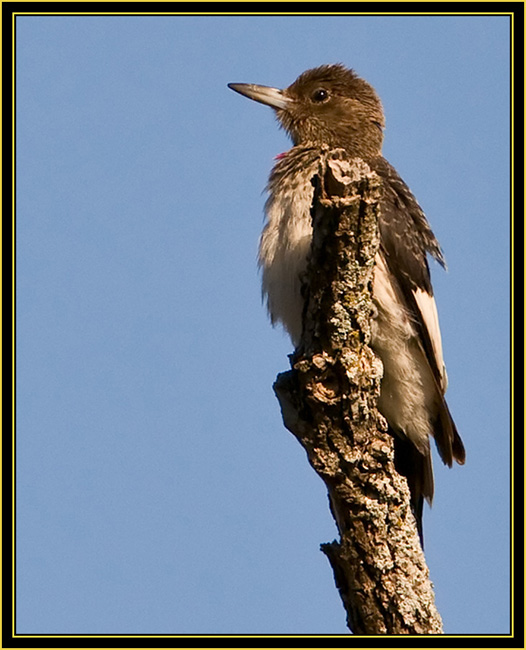
|
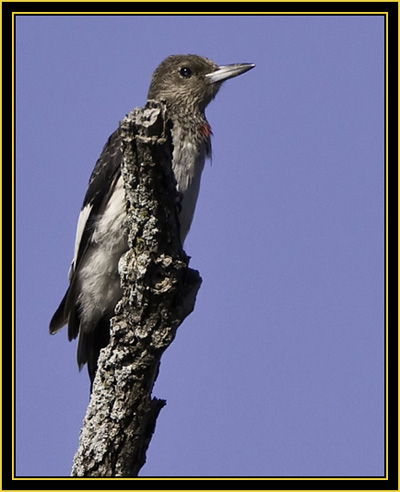
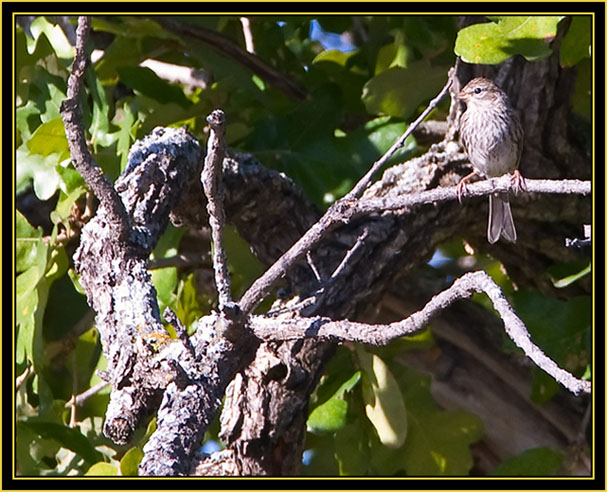
|
More Views Around the Lake
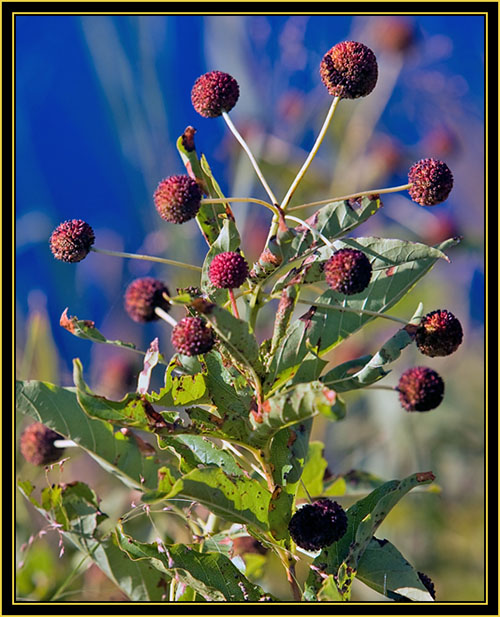

|


|
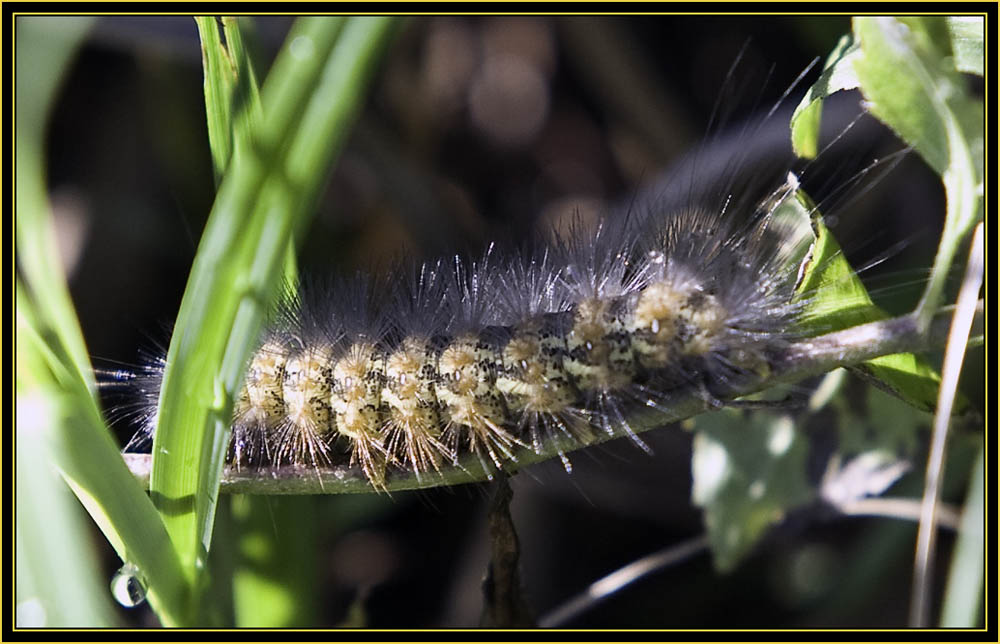
|


|
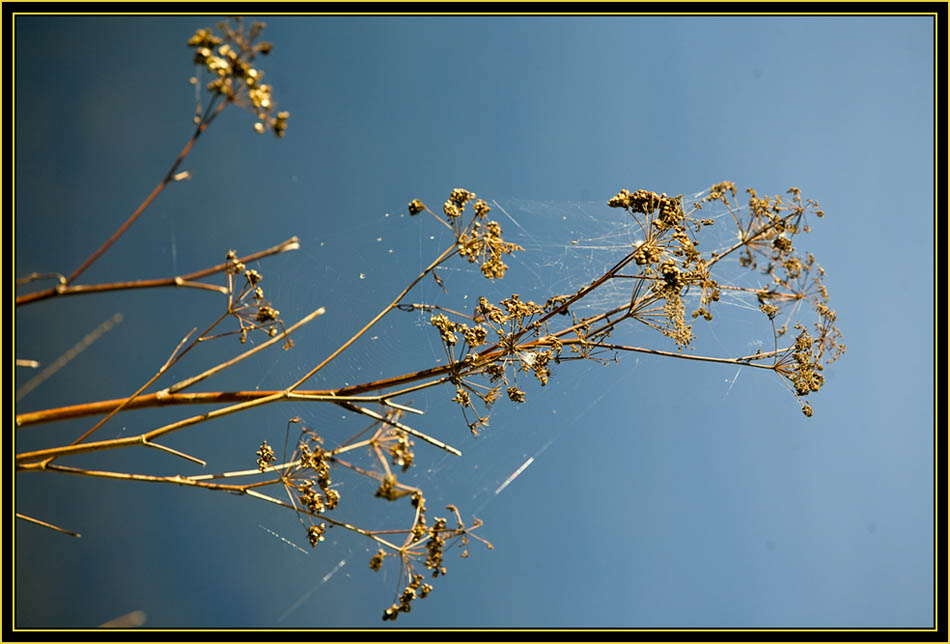
|


|

|

|
After walking the grounds and speaking to some other visitors at French Lake it was time to seek new venues. I talked with another photographer seeking birds with a 100~400 Canon lens and we learned he was from
Texas. There were some folks out on the water in small boats fishing. It was a beautiful day in the refuge…
French Lake - Wichita Mountains Wildlife RefugeCanon EOS 5d, 1/640 second at 700mm; EF70~200 f/2.8L at f/9, ISO 400 |
Rob suggested we stop at the dam at Quanah Parker Lake. He indicated Canyon Wrens are often found there and not that I really had an opinion either way, this decided it for me as a potential new bird to photograph.
Probably everyone interested in history has heard of Quanah
Parker – at least I had. Quanah was the offspring of a Comanche Chief, Peta Nocona and Cynthia Ann Parker, a Caucasian woman taken captive during a Texas raid in 1836. Cynthia lived among the Comanche for twenty-four years and was re-captured along with her daughter, Prairie Flower, in 1860
during a raid on the Pease River in Texas and so was returned to the whites. Like many before her after such a far-reaching & extreme change in lifestyle, Cynthia never
re-adjusted to white culture and lived only four more years. Quanah became the last chief of the Comanche and they went to war with white civilization after refusing to accept the provisions of the 1867 Treaty of
Medicine Lodge, which would have had his band reservation bound. It was stated he never lost a battle and was never captured. He surrendered to the U.S. Army only when there was no recourse remaining for his people - worn
out, hungry and heartsick from the brutal, endless campaign in a war of attrition the Comanche could not win. Quanah and his band surrendered at Fort Sill in Oklahoma on June 2, 1875. Although a captive of a conquered nation, Quanah remained a leader to his people, learned
English and became a statesman never tiring of promoting their rights. He died in February 1911 and is buried in the Fort Sill Military Cemetery.
At the Dam - Quanah Parker LakeCanon EOS 5d, 1/800 second at 70mm; EF70~200 f/2.8L at f/10, ISO 400 |

|
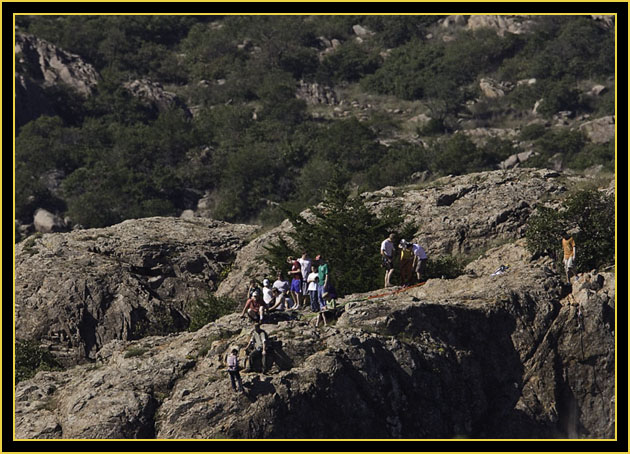
|
This place was interesting; it was also a destination for all kinds of people doing various recreational activities in the refuge. The cliffs above the dam are one of the premier hiking spots for many – not as difficult as climbing vertical faces with
tackle although I viewed people outfitted in this fashion, but difficult enough that the average person could ascend free climbing if in a state of reasonable conditioning with enough time. There were people fishing off the dam and at water's edge, sitting about in lawn
chairs enjoying the day, hiking all around, families with young children on foot and in backpacks, etc. It was a nice Saturday and many were taking advantage of it.
Hikers Above Quanah Parker LakeCanon EOS Mark III 1Ds on tripod, 1/800 second at 840mm; EF600mm f/4L + 1.4X at f/8, ISO 640 |
At the Dam - Lake Quanah Parker


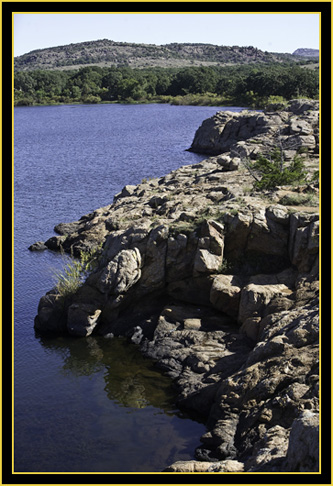
|


|
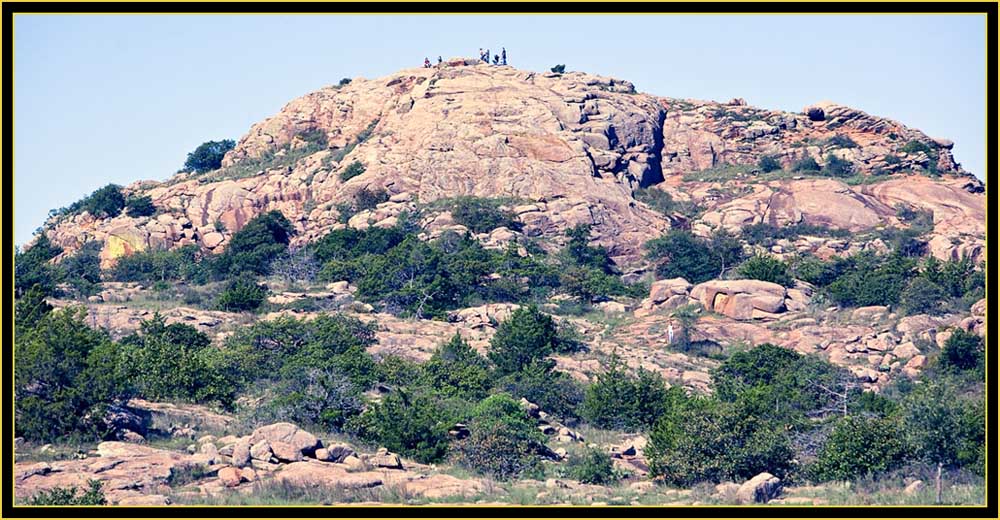
|

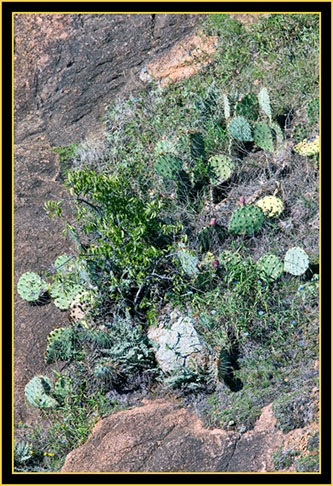
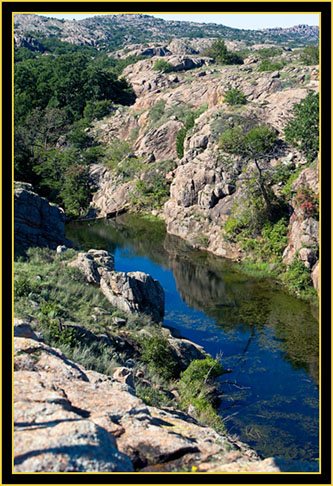
|
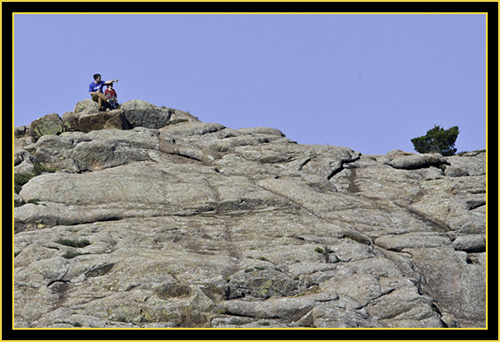
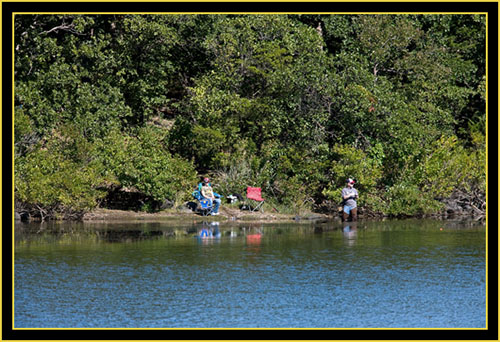
|

|
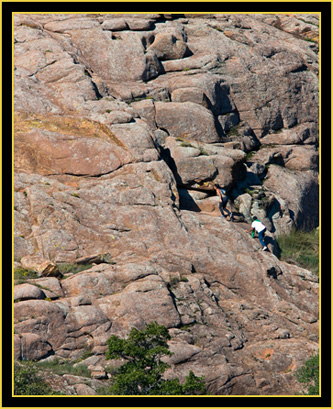
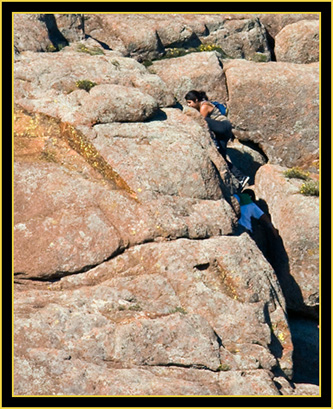
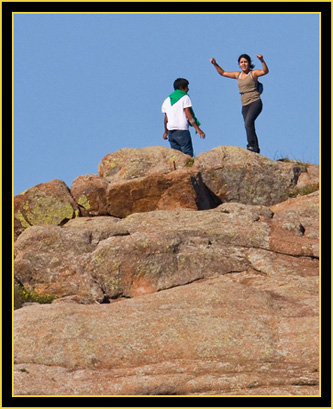
|
We could hear the Canyon Wrens across the ravine from our location but try as he may, Rob couldn’t obtain a visual on what we suspected were two birds. We were on top of a ledge looking down into the ravine with water at the bottom. It was
quite a ways down as we looked over the edge… The tripod and long lens was on the high point on our side and we had an excellent view all around. Many of the images of people in the template above were taken at this time. I shot both with
the tripod and handheld systems while Rob looked for the wrens. He did spot this Northern Flicker to our left and I swung the lens around to capture this image.
Northern FlickerCanon EOS Mark III 1Ds on tripod, 1/400 second at 840mm; EF600mm f/4L + 1.4X at f/8, ISO 640 |
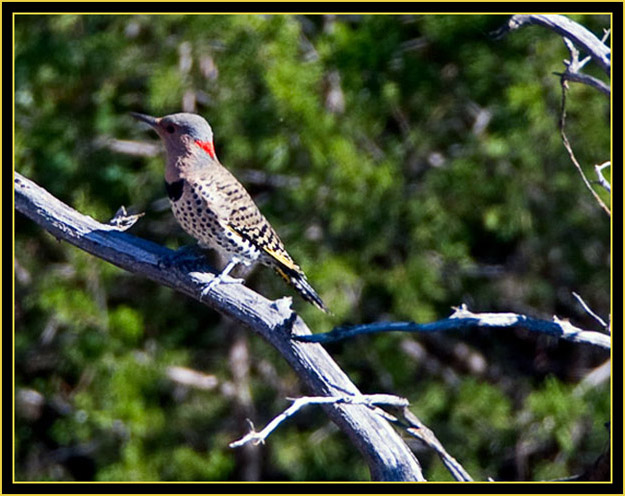
|

|
Standing up high with the 600mm lens definitely drew a few people over to talk with us. One fellow photographer with excellent gear and I engaged in an interesting discussion… He used Canon bodies and lenses and was well equipped. Our
gear was comparable but our accessories differed by manufacturer while serving the same needs. He was interested in checking out the 600mm lens and when he told me he had a legendary 300mm f/2.8L lens in his vehicle we exchanged glass
for a few minutes to see what we thought. The image at left was taken with my 5d and his 300mm mounted with a 1.4X extender. Everything about this lens is superb but I never seriously considered buying one because bird photography is better
served with more reach in my view – I went the 500mm route followed by the present 600mm f/4L lens. Some of the other comments we exchanged were helpful and he provided some insight on using Photoshop CS4. I wanted to know his opinion on the photomerge
function because I was experiencing difficulty stitching vertical composites in CS3. Before my trip west ended I ordered CS4 so it would be waiting for me when I got home. All the vertical composites in the article were stitched in
CS4 – it worked splendidly…
As one can gather from this image Rob was comfortable using my primary system after the intense photographic immersion of the past two days. He could transport, set it up and be ready to shoot as quickly as I could – he’s an impressive individual all around I found... I think he’d make an excellent photographer and was picking up the techniques we discussed readily enough. On the other hand, I wouldn’t want to be present if he decided to tell Ms. KK he was thinking about funding this as a new avocation… Rob Scoping out the Area - Wichita Mountains Wildlife RefugeCanon EOS 5d, 1/1000 second at 420mm; EF300mm + 1.4X f/2.8L at f/8, ISO 400 |
We talked with several hikers who planned to climb to a particular spot but learned there was a large group there already – some type of church organization outing they indicated. They thought using the 600mm lens would be a fine way to scan the area
for a ‘Plan B’ scenario, so they took turns checking things out as we talked. The image at right has my Chicago friend looking through the lens as Rob talks with the hikers.
Company on the Ledge... Wichita Mountains Wildlife RefugeCanon EOS 5d, 1/1000 second at 70mm; EF70~200 f/2.8L at f/11, ISO 400 |

|

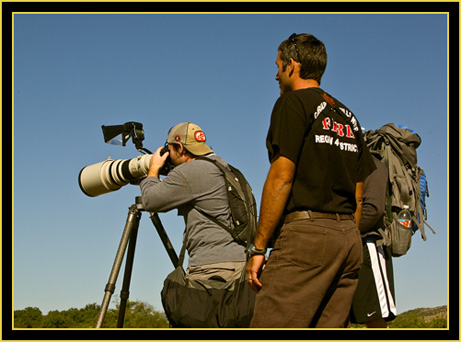
|
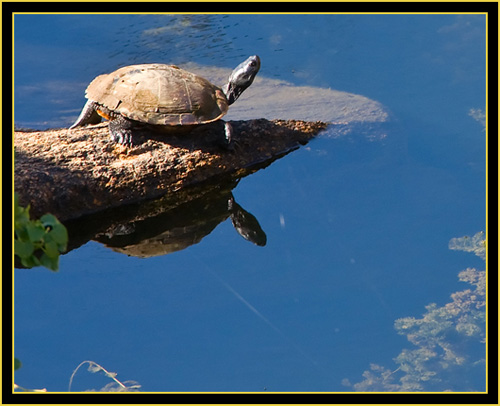
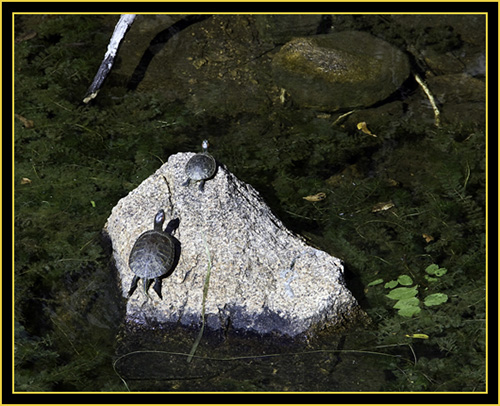
|
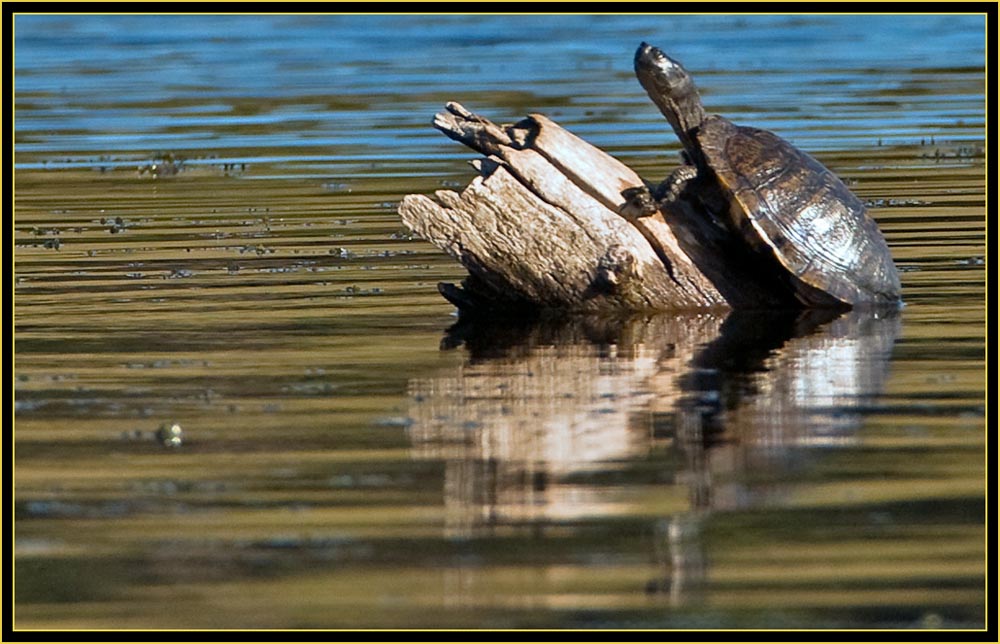
|
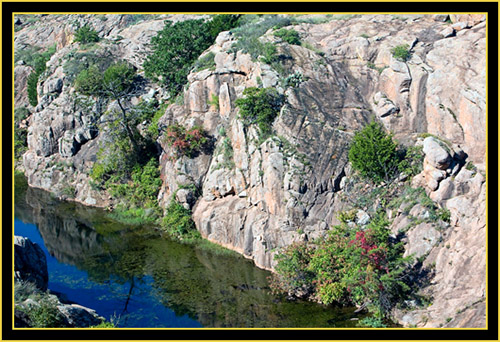

|

|
It was time to move on… The volunteer trash detail crews wouldn’t be working much longer so if we were to get a few shots we needed to locate where they were. It was approaching noon, the sun was high and it was getting
hot, but it had been a great morning so far...
Butterfly in the RefugeCanon EOS 5d, 1/1600 second at 200mm; EF70~200mm f/2.8L at f/8, ISO 400 |
Locating the Volunteers on Trash Detail...



|


|


|
|
The volunteer detail was close to the Visitors Center and this is where we headed next to hook up with the girls for the balance of the day. Ms. KK and Abigail had just arrived and were waiting as we pulled into the parking lot. We’d driven by the building
several times but this was my first opportunity to actually go inside and have a look around. It was also when we - Rob, Ms. KK, Abigail and I, took time to view the introductory film of the refuge mentioned previously, – I found this an interesting overview and certainly worthwhile. The
Visitors Center was really quite nice and the interpretive displays, dioramas & exhibits were informative - I found them helpful in many respects as this area was new to me and far different in my experience. I was particularly interested in how things were set up as I looked around because
many of my images are being used in this fashion at the Savannah National Wildlife Refuge when their new facility opens in the coming months.
Rob, always the gentlemen, introduced me to Susan Howell, who runs the Visitors Center. We talked for a bit and she thanked me for taking the time to come to the refuge to take photographs. As I looked around I noticed several walls that could use some sprucing up, so viewed some possibilities if I returned home with anything they may find acceptable. This refuge, the oldest managed wildlife preserve in the United States, gets many visitors in the course a year, a surprising number actually, over 1.5 million… One can well imagine how many tour the Visitors Center annually. I’m glad we stopped here when we did because our activities allowed little time otherwise. Cactus on the PrairieCanon EOS Mark III 1Ds, 1/800 second at 840mm; EF600mm f/4L + 1.4X at f/8, ISO 640 |
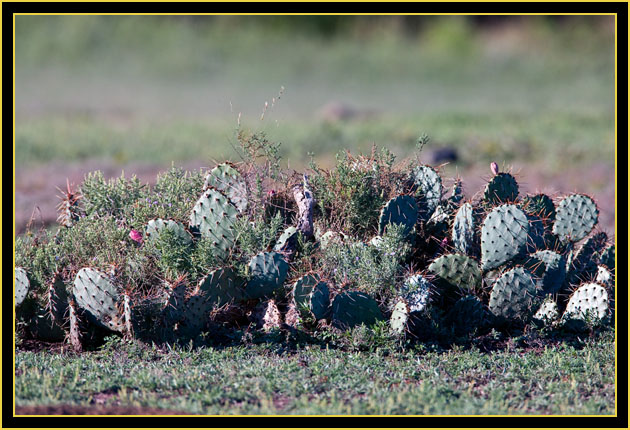
|
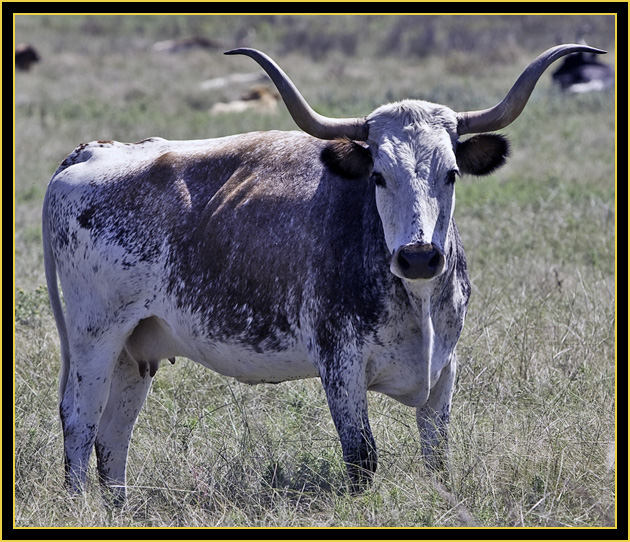
|
The four of us were off to seek new adventures in the refuge. It was downright hot outside by my standards and we were traveling in open country for the most part. We drove by some longhorns close to the road – what intrigued me about this group was the fact the cattle were
lying down in the grass – I wished to get some shots in this attitude. I asked Rob to pull over and jumped out with the handheld camera. Of course, as soon as the longhorns viewed me walking their way they stood up to check me out. I didn’t approach too close as they were now
in an alert posture so I took a few exposures and started back. I also noticed that the refuge was active with visitors representing a good deal of traffic on the roads.
Texas LonghornCanon EOS 5d, 1/800 second at 200mm; EF70~200mm f/2.8L at f/6.3, ISO 400 |
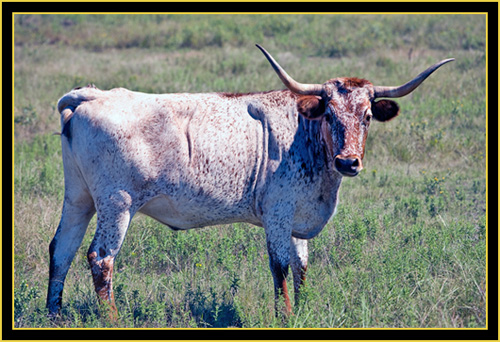
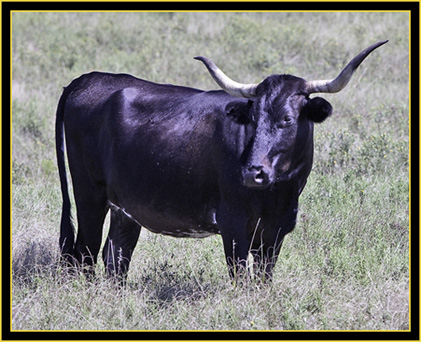
|
Our next stop was Jed Johnson Lake where we got out to investigate the area. It was nice having the girls around as this changed the pace a bit and I enjoyed their company. It didn’t take long to figure out Abigail was a true ‘refuge girl’ and her curiosity about everything was
enlightening to me. I believe seeing the world as a young person does would go far in a photographic application… As adults with work, family and the plethora of other obligations in everyday life I think we get jaded to the wonder of it all. I’d first met Abigail
when she participated in banding Wood Ducks in Savannah – she really appeared to enjoy all these activities and participated with interest.
View of Jed Johnson LakeCanon EOS 5d, 1/640 second at 120mm; EF70~200mm f/2.8L at f/7.1, ISO 400 |
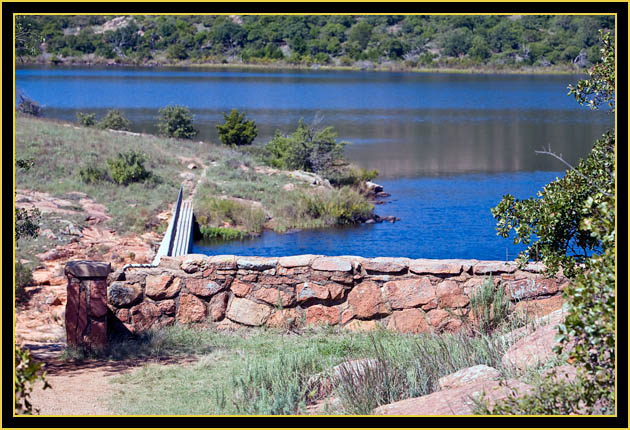
|
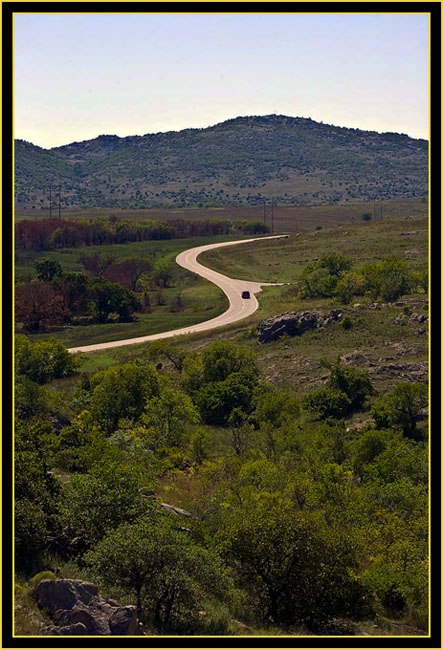

|
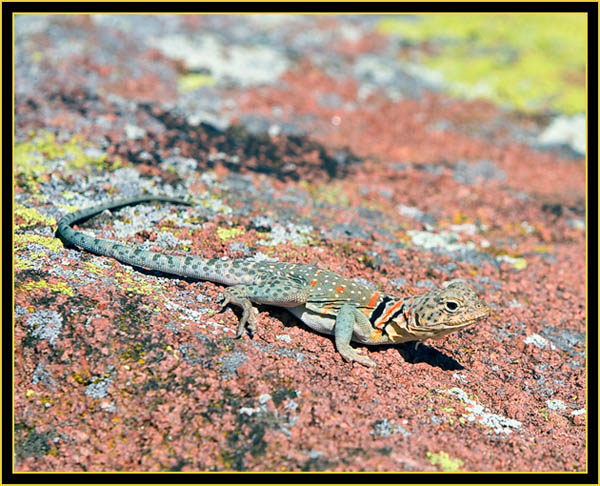
|
We’d only been walking the area a few minutes when the lizard at left was spotted on top of a rock. Yikes – pretty cool I thought, a subject on high ground with more than ample light – so much so that overexposure was a consideration. I stalked the lizard handheld but
when the creature, although leery of my presence didn’t evacuate the area, I pulled the tripod system out to attempt some detailed views.
Collared Lizard...Canon EOS 5d, 1/1250 second at 200mm; EF70~200mm f/2.8L at f/8, ISO 400 |
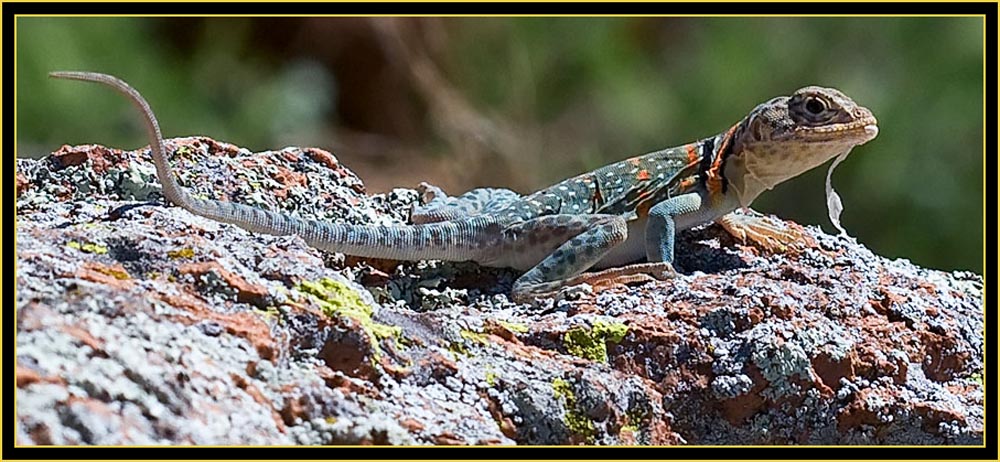
|
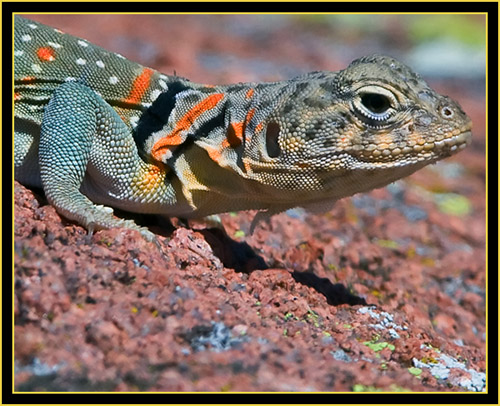
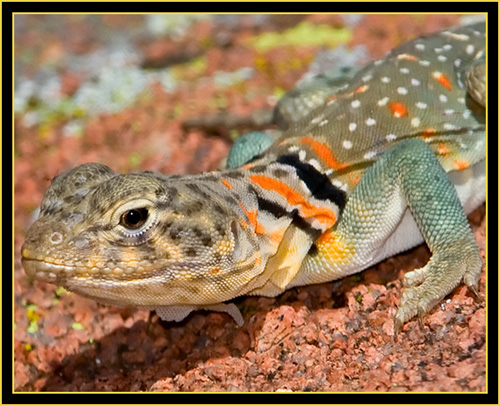
|
I also noticed this beetle moving along the parking area and walked over after changing to a macro lens to see if I could get a good exposure handheld. Critical shooting for sharp focus is best done tripod mounted… I recognized this of course but I wasn’t certain
if I had time to get set up so took several shots just in case the subject left the scene. There was much going on here just like every other place I’d visited in the refuge and everyone spread out looking for subjects and enjoying the view. If you consider
photographing all subjects large and small the possibilities around the refuge would be endless. I’ve got this beetle identified as an Elder Borer (aka Cloaked Knotty Horn) which I believe it is but cannot say with absolute certainty.
Elder Borer in the Parking LotCanon EOS 5d, 1/1250 second at 100mm; EF100mm f/2.8 Macro at f/11, ISO 400 |

|


|
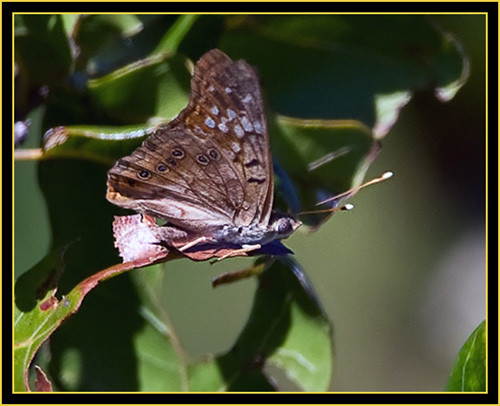
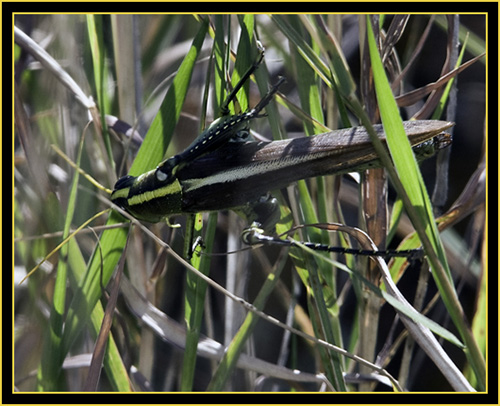
|
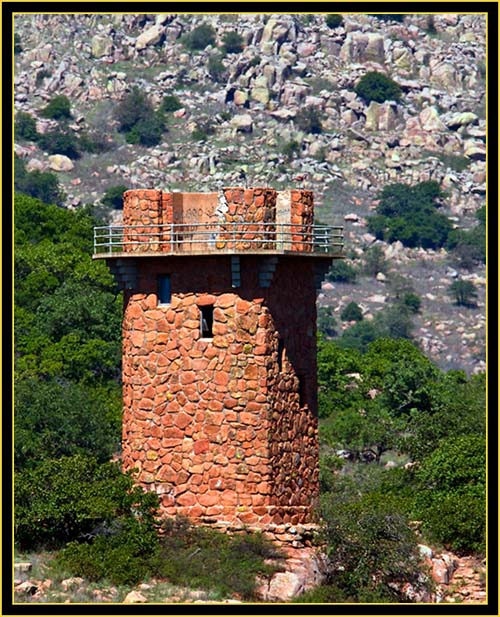
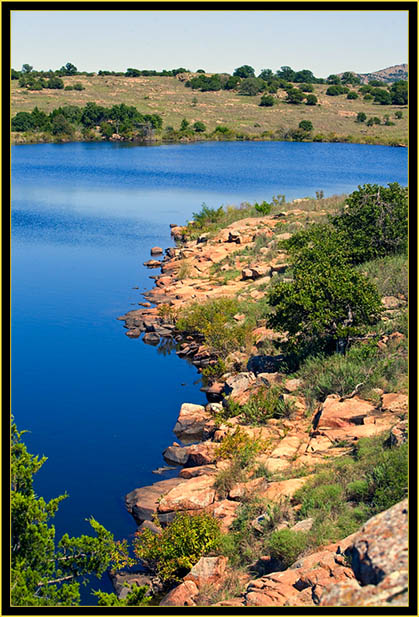
|
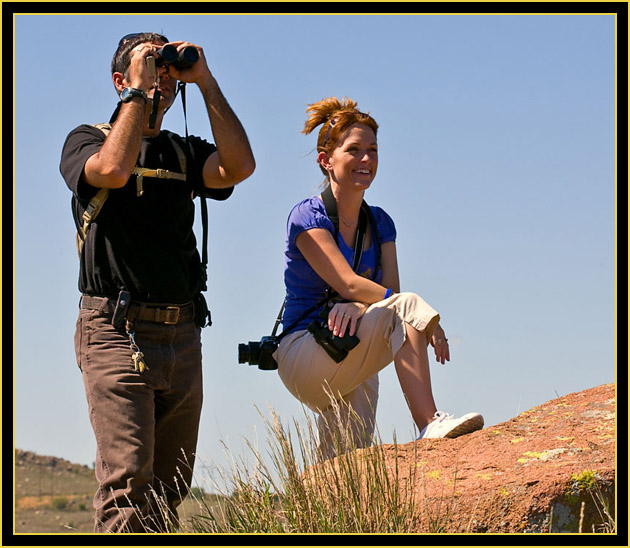
|
A few vehicles pulled in briefly and soon left the parking area - we had the place almost to ourselves. This refuge is large and with so many places and different pursuits available for visitors to enjoy there could be countless thousands conducting
activities and you can still feel much like the it’s a personal experience designed solely for your benefit.
I took the image at left of Rob and Ms. KK as they viewed the expansive environment... And no, as much as it may appear so, this photograph was not staged to look like 'visitors to the refuge enjoying the facility'. I believe KK was genuinely happy to be here enjoying the day… Rob & KK - Wichita Mountains Wildlife RefugeCanon EOS Mark III 1Ds, 1/640 second at 100mm; EF100mm f/2.8 Macro at f/10, ISO 640 |
KK Locates a New Bird...
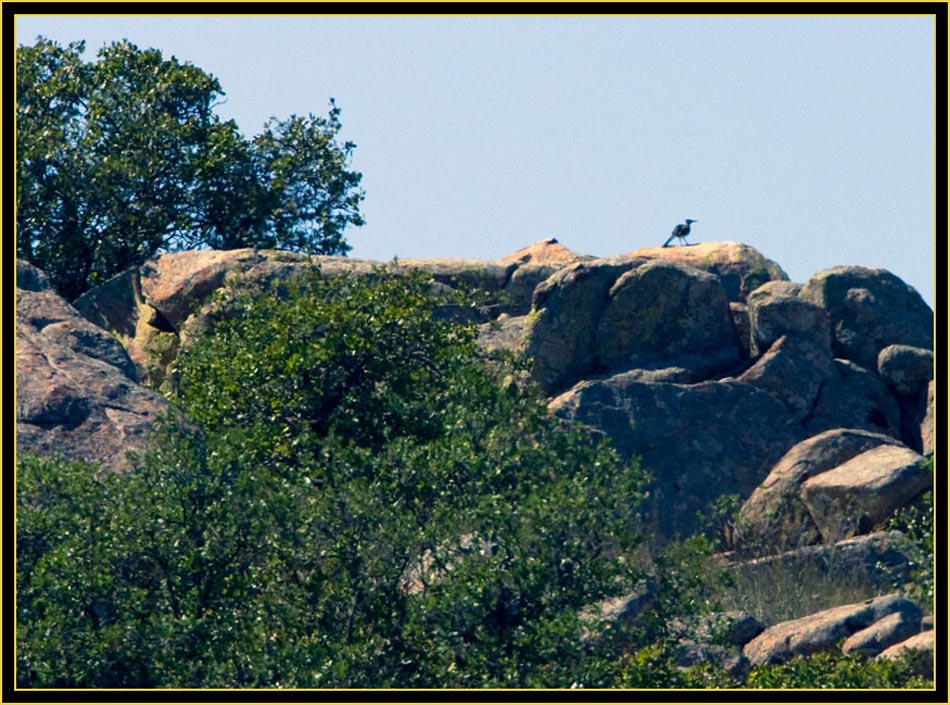
|
And Abigail Finds a Spider...
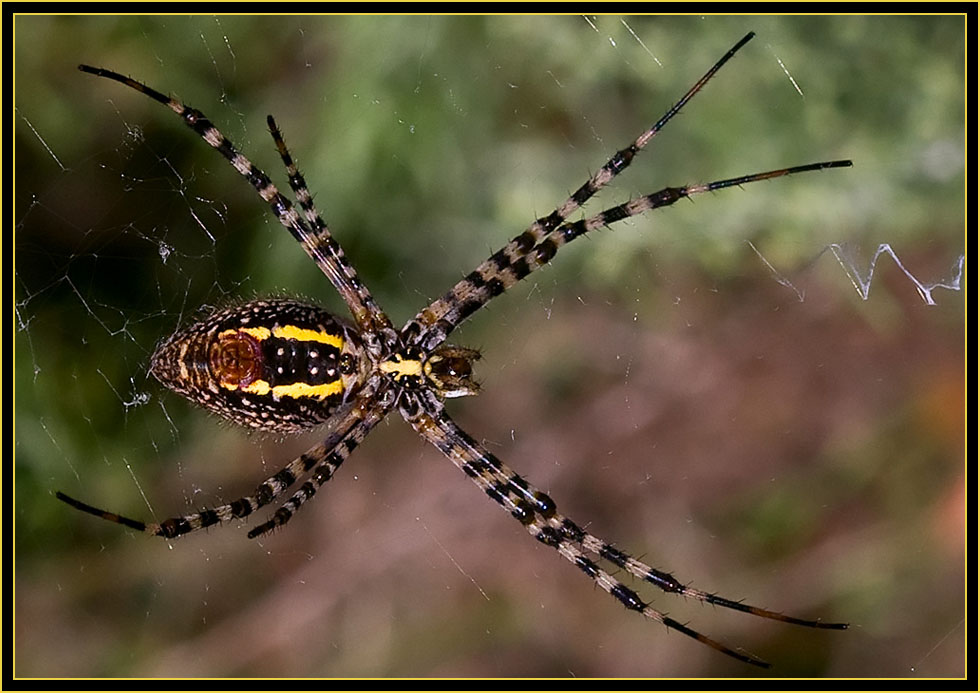
|
At right is Rob’s photograph of me photographing the spider with a 100mm macro lens handheld... Abigail was going back and forth by the water, viewed this spider and told her father about it. Rob asked if I wished to look it over and I quickly saw it was colorful and interesting. I
had the camera tripod mounted but the spider’s web and the subject were at such an angle and height it would have been a difficult placement for the tripod and far too time consuming. In the end result, I dismounted the camera and crawled into the shoot zone. I believe Rob
thought it amusing to see me creeping around and squirming to get the angle correct, so he ran off to get his camera to capture his own ‘Kodak moment’… The spider shots are actually of two subjects located fairly close to each other. This was fortuitous because one
was top view exposed, the second a belly view – two sides of the same species on different subjects.
Photographing the SpiderCanon EOS 5d, 1/1250 second at 100mm; EF100mm f/2.8 Macro at f/11, ISO 400 |
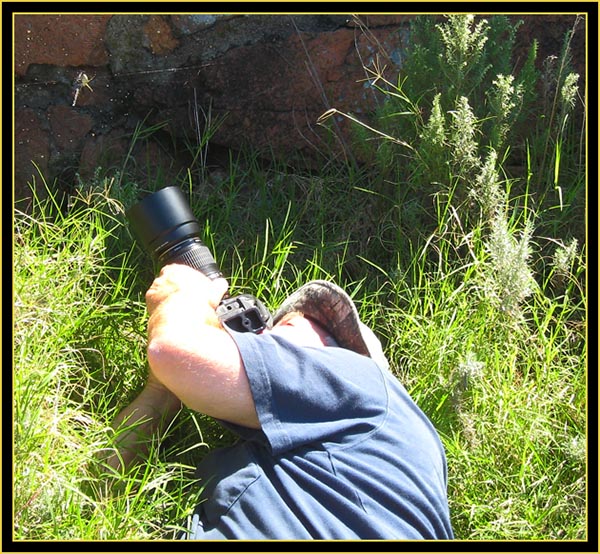
|
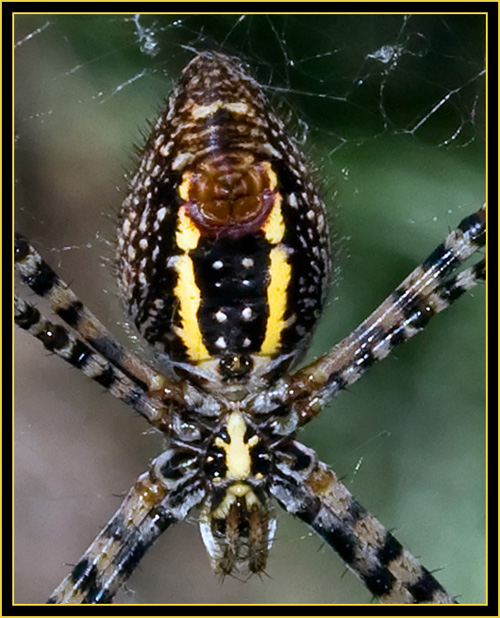
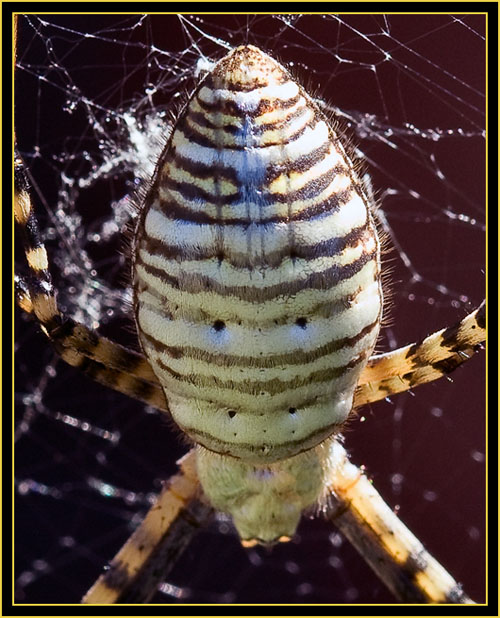
|
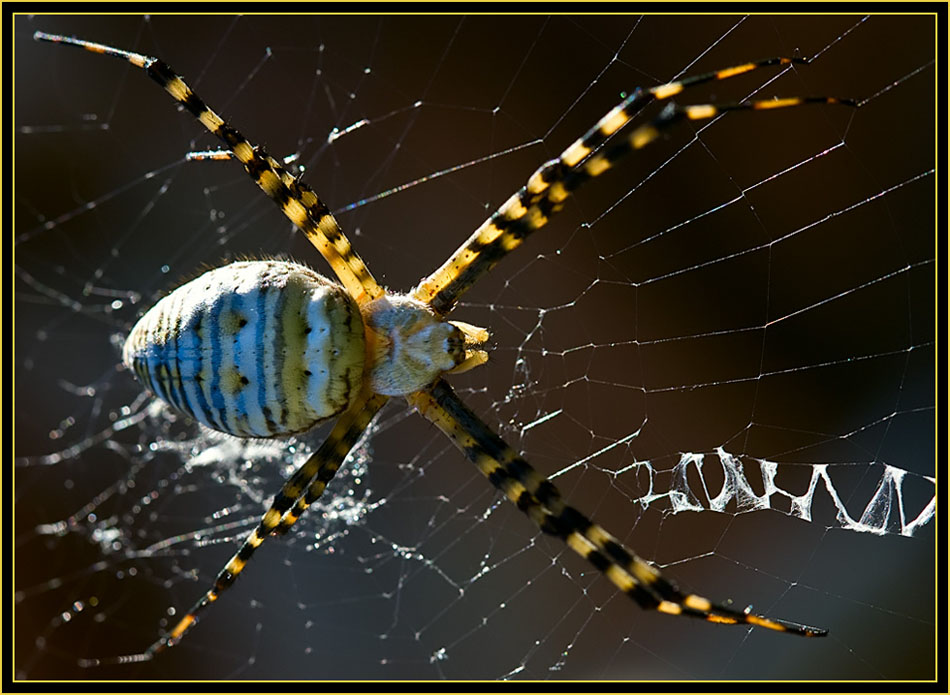
|
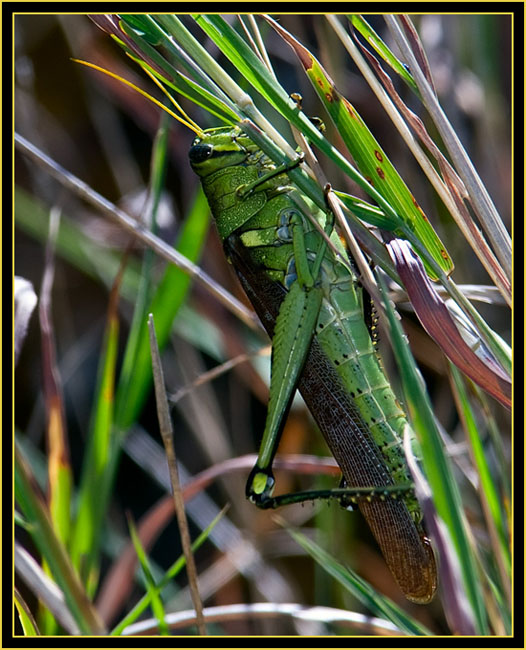
|
Remember how I’d mentioned yesterday about wishing to get close up on some grasshoppers? Well, it was a new day and it brought with it several opportunities to get it done… With help from my friends we found several specimens that would tolerate a close enough approach to obtain
some respectable shots. The following images are of two grasshoppers – at left is one as is obvious, clinging to the grass. The second landed on a rock in the same area where I photographed the lizard – out in the open. This one was a bit more skittish but I was pleased with the end result.
These were taken both with the tripod system and handheld...
The Grasshopper Files - Wichita Mountains Wildlife RefugeCanon EOS Mark III 1Ds, 1/800 second at 840mm; EF600mm f/4L + 1.4X at f/8, ISO 640 with flash |

|
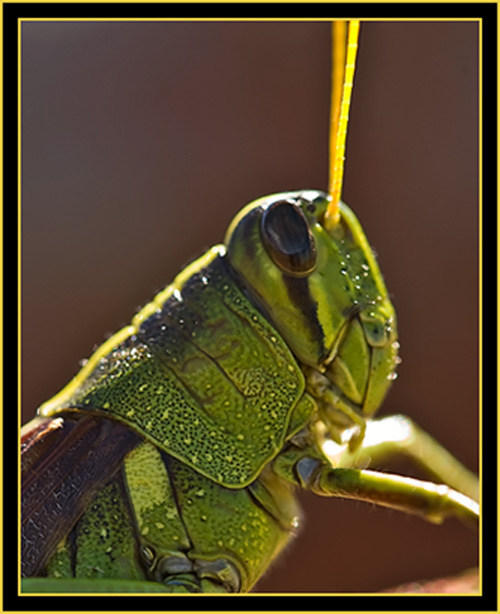
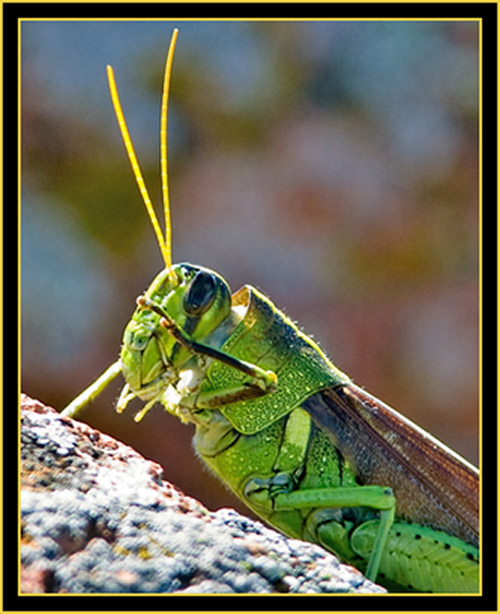
|

|
One significant difference from yesterday was that with Ms. KK along we were going to take a few minutes for lunch. We did some sightseeing as we traveled about ending up at the Sunset Picnic Area that had seating for just that purpose. This was a nice spot and appeared to be a
favorite destination for many doing any number of pursuits. There was a creek, footpaths for walkers and of course ample places to hike and climb all over the area - it only went up from the table area.
I think we made two or more stops before arriving here including an area called the Holy City, an historic site that had so many visitors around we didn't dally long and across from the church I went into a field to photograph some mushrooms and prairie dogs. Ms. KK commented about the versatility of my tripod after she saw me photographing the mushrooms. I’d released the stops and spread the legs to get close to the ground for these shots – you can see the tese images were taken at a low angle. The following images are representative of these stops...
WildflowersCanon EOS Mark III 1Ds, 1/1000 second at 840mm; EF600mm f/4L + 1.4X at f/11, ISO 640 with flash |
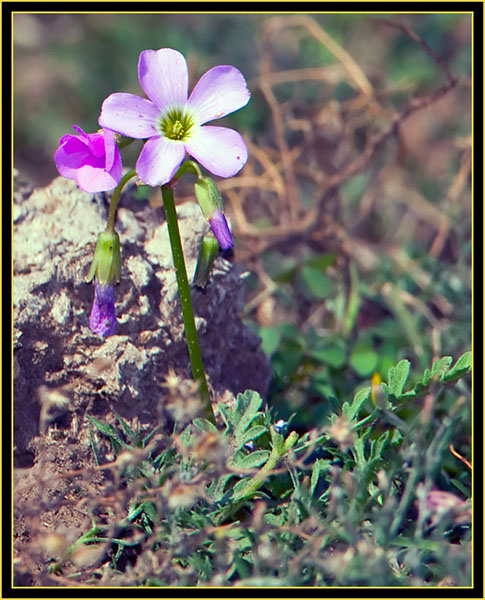
|
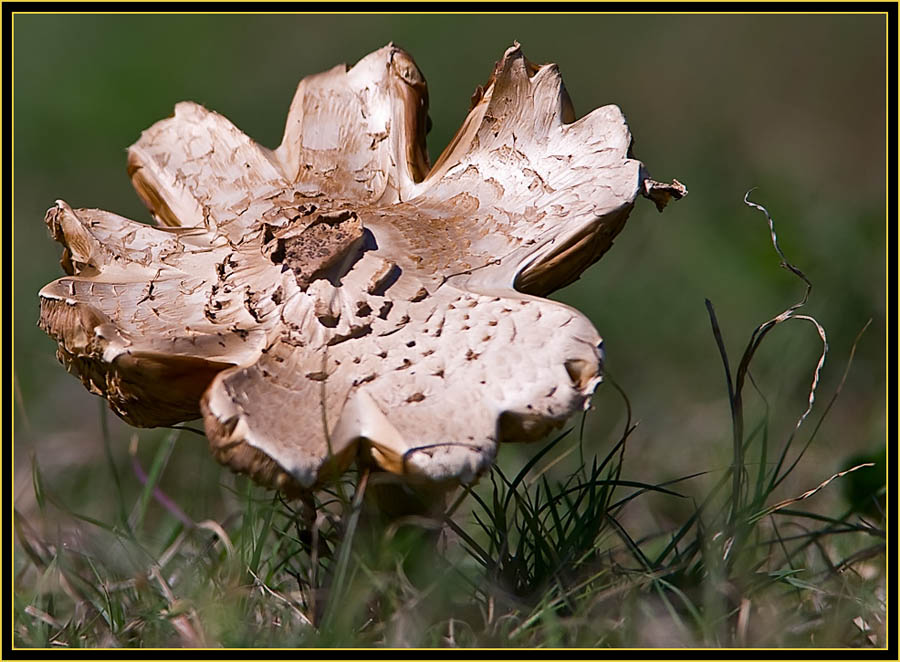
|
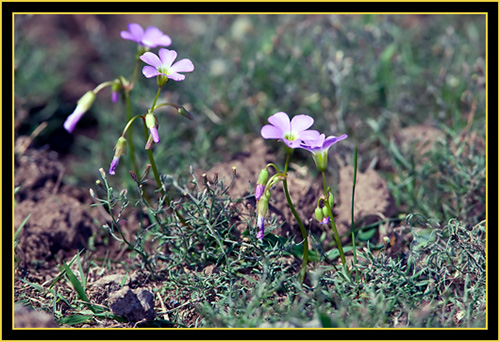
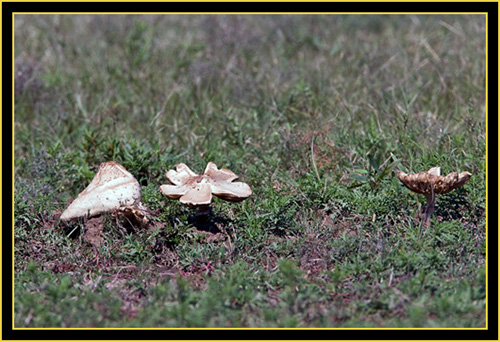
|
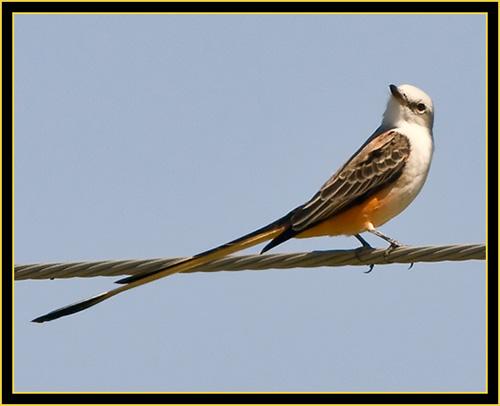

|
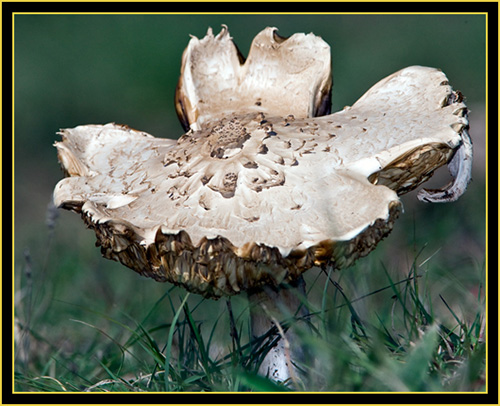
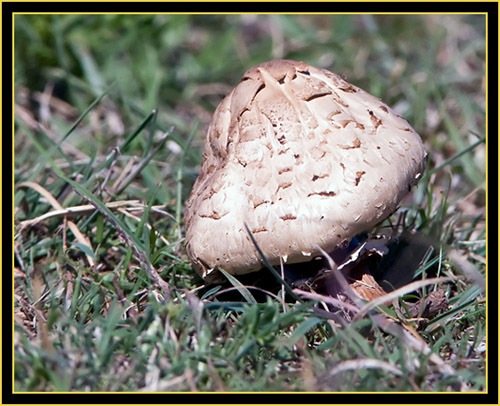
|

|
Our lunch was perfect – we ate our sandwiches out of the sun in the shade of the trees and in pleasant surroundings. In short order we were through, everything packed and re-loaded leaving plenty of time to explore the immediate area. Rob
indicated this is a prominent hiking locale and we viewed parties both ascending and descending the granite stairs not far up the hill. I must comment that those returning looked far worse for wear than the people starting
the trek up. One lady I spoke with indicated you could reach the top in about an hour. Rob stated he’d done this many times and it wasn’t all that bad… Knowing what I did by now, I realized he probably did it in fifteen
minutes without breaking a sweat… He asked if I had an interest in climbing up. I replied in the negative, I was okay where we were for now and in truth, there were some interesting subjects in the immediate area.
Start to the Summit - Wichita Mountains Wildlife RefugeCanon EOS 5d, 1/200 second at 130mm; EF70~200mm f/2.8L at f/3.5, ISO 400 |
Rob was searching for a male Collared Lizard he knew frequented this area. The male is significantly more striking than the female of the species and is nearly turquoise in
color. I’d viewed photographs of these but never seen one in this coloration and I too hoped the hunt would prove successful… I learned later these lizards are the state reptile of Oklahoma and is often referred to locally as a
'Mountain Boomer’. Although we did not locate a male we were successful in a getting a few images of the female as can be viewed at right and below. I read these lizards are also known as the Common Collared or Oklahoma Collared Lizard.
Collared LizardCanon EOS Mark III 1Ds, 1/2500 second at 840mm; EF600mm f/4L + 1.4X at f/8, ISO 800 |
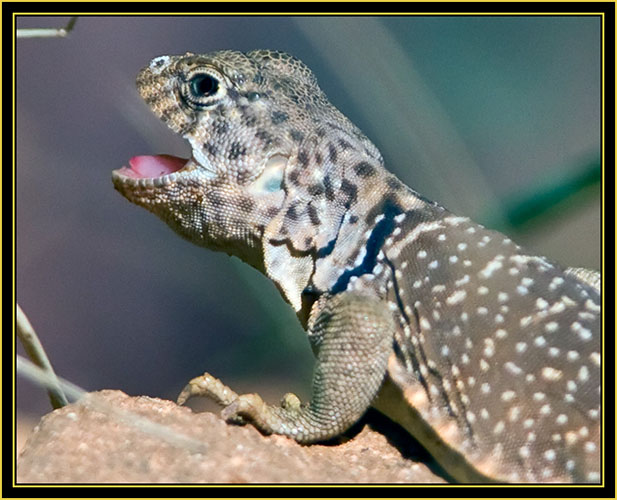
|
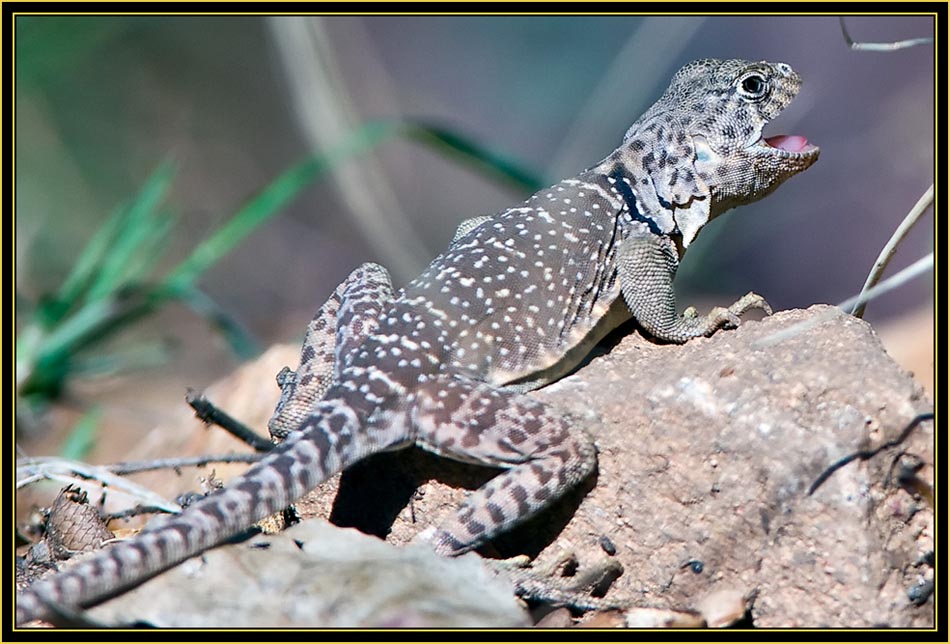
|

|
We noticed this dragonfly flitting about between several twigs over a small body of water – more like a drainage channel near the ledge than anything. These creatures are territorial and I knew the dragonfly would keep
returning so I found the favored perch and set the tripod system up to take some shots. The image seen here was shot handheld because although the specimen was quite cooperative, the composition of the shot series was
nearly all head on. This is difficult to get much of a dragonfly in focus - take a look at the larger images below shot at 840mm. However, I was just over twenty-feet from the subject in order to obtain the focus range with the
Wimberley head tightened down, so as people came by - and nearly all asked what we were doing - I had them look through the lens at the dragonfly – most were fairly amazed and tried to locate the subject naked eye as I pointed out where to look.
Dragonfly - Wichita Mountains Wildlife RefugeCanon EOS 5d, 1/400 second at 200mm; EF70~200mm f/2.8L at f/4.5, ISO 400 |
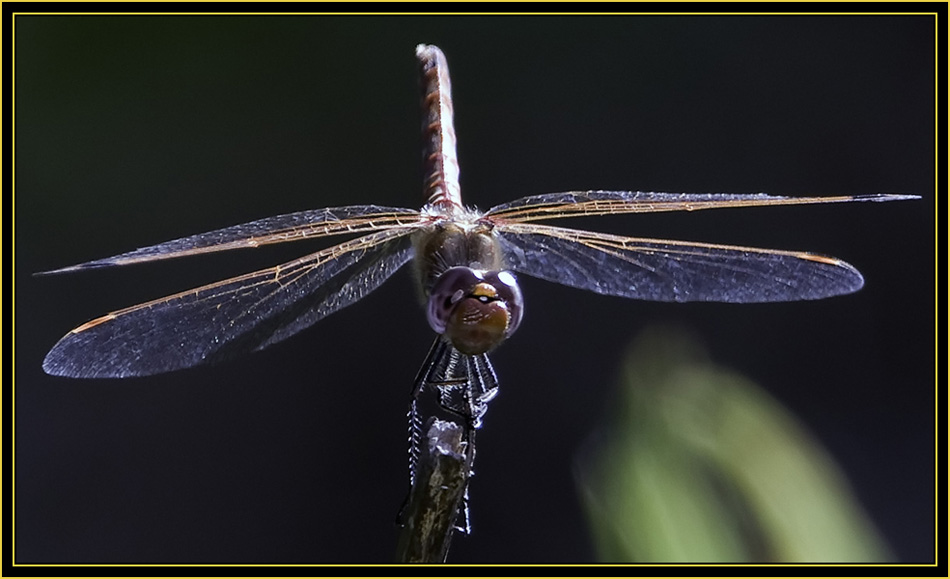
|
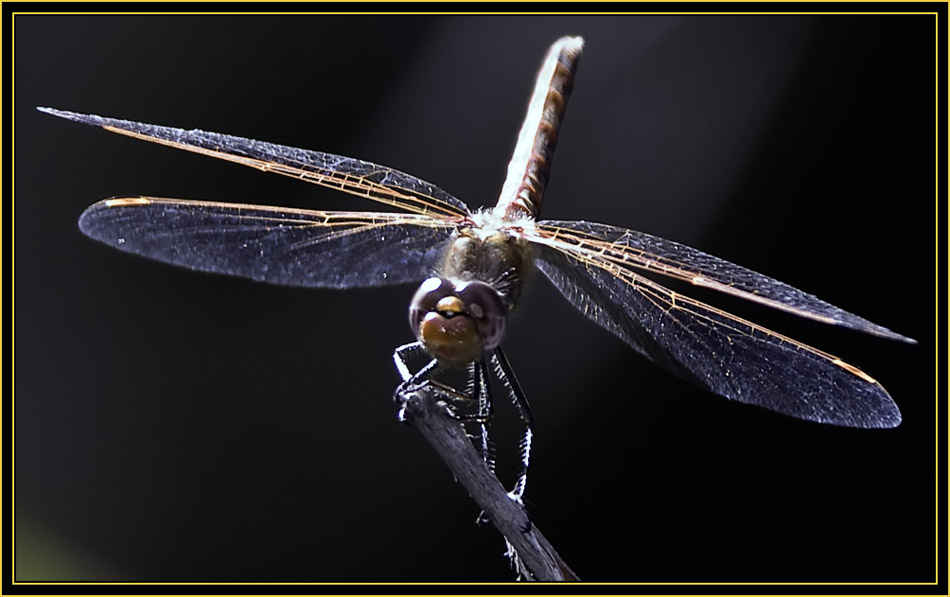
|
We spent more time unsuccessfully seeking the male lizard as I took exposures of things around us. We’d talked about ‘going behind the fence’ with the girls so decided to pack up and do this shortly as
the afternoon was going by rapidly. If we didn’t act soon we took the chance of losing the light before getting to our ‘photograph the sunset’ destination…
Fruit of the SumacCanon EOS Mark III 1Ds, 1/400 second at 840mm; EF600mm f/4L + 1.4X at f/8, ISO 640 |
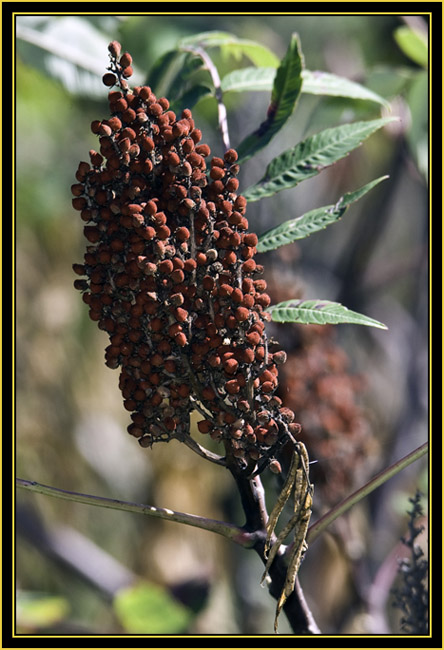
|
Parting Shots...
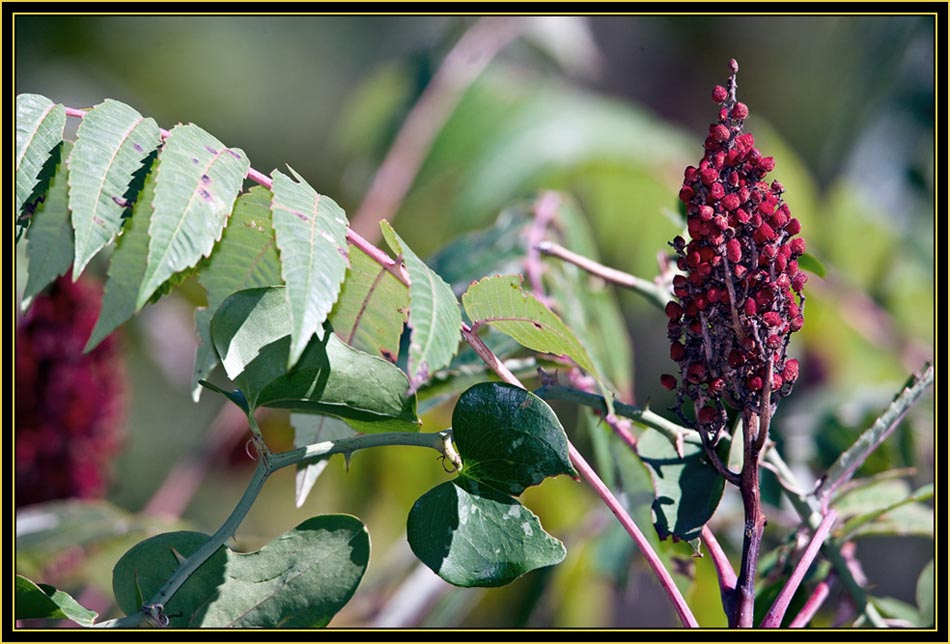
|

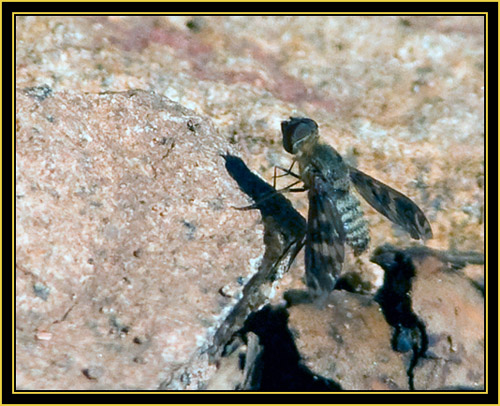
|
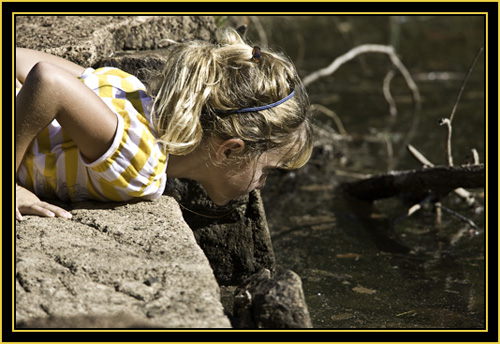
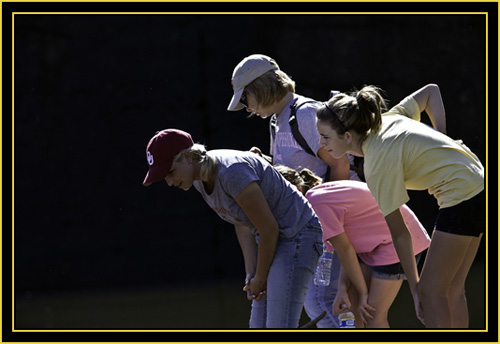
|
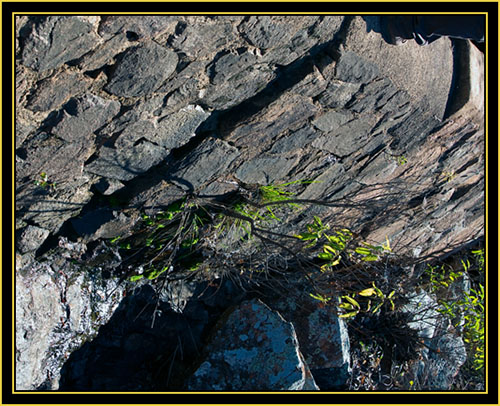
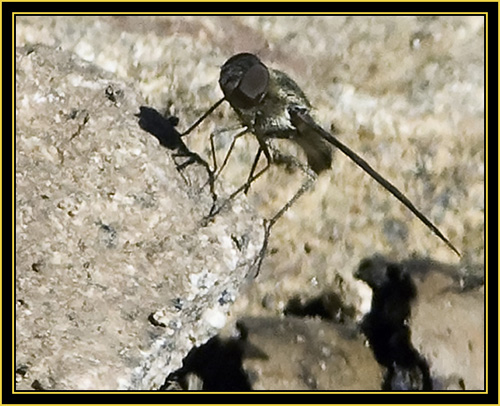
|
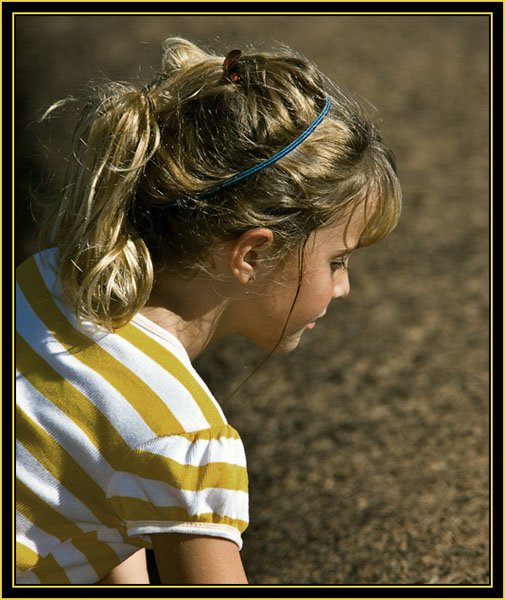
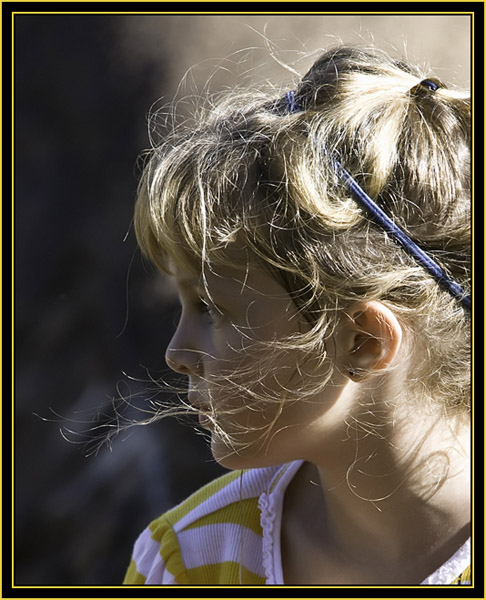
|

|
We weren’t far from the vehicle compound, our next destination. Once there we exchanged vehicles and placed everything in a heavy duty truck for the next portion of the day. It was just after 4:00 PM and we didn’t
have a great deal of time remaining so we stepped it up a bit. Rob pointed out some camping areas stating the RV’s parked here were volunteers working in the refuge. Near this site we heard a Wild Turkey voicing and then
saw a group of birds heading towards the woods. Not that turkeys are uncommon or difficult to find, but I wished to photograph them as they were much closer than others we’d seen. Rob maneuvered the truck and I took some
handheld exposures from the passengers seat. Getting out would only have pushed the birds quickly into the woods.
Wild Turkey VocalizingCanon EOS 5d, 1/250 second at 195mm; EF70~200mm f/2.8L at f/3.5, ISO 640 |


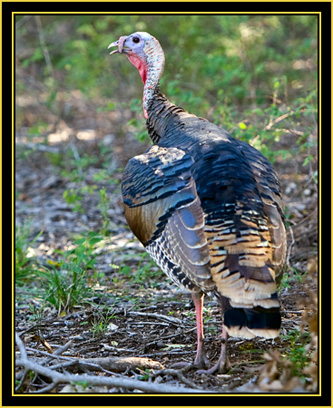
|

|
Soon enough we were through the gate, locked it up and were ‘behind the fence’… We drove about on the gravel roads looking for nothing in particular, just enjoying the stark landscape of the Wichita Mountains. After a
time we crossed a low-lying section of road with water on either side. The refuge staff added a concrete section of road to cross this swampy lowland at Panther Creek and soon after crossing it we parked and walked back. I’m glad we
did because this turned out to be an extremely interesting stop with much activity…
Goatweed LeafwingCanon EOS 5d, 1/500 second at 195mm; EF70~200mm f/2.8L at f/5, ISO 640 |

|
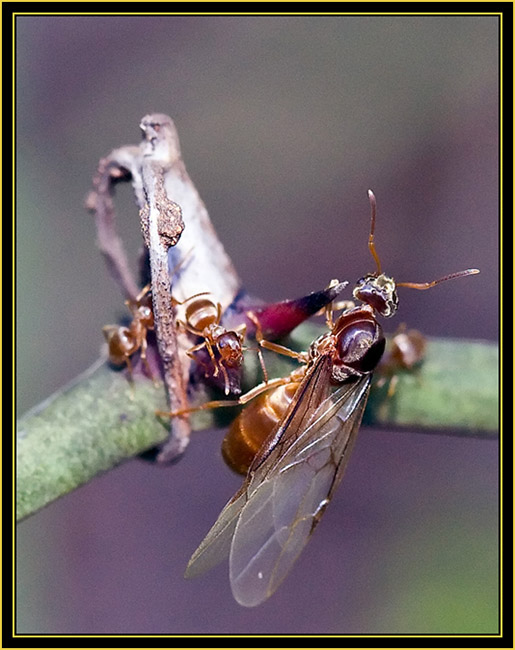
|
The sunlight was curtailed by the many trees and the lateness of the day. There was a good deal of insect activity all around us but I was having trouble with shutter speed. Much of what I viewed would
have been best shot handheld because we were in a confined area and without treading into the water it was difficult to get into focus range for the primary camera system. On the other hand a flash was absolutely required to obtain an acceptable image at that distance due
to lowlight conditions, so we worked together to shoot some at 840mm using a flash extender and some with the 1Ds on my second tripod with the macro lens and flash close up.
When employing the 600mm lens I backed away from the subject as Rob served as a pointer to help reacquire the subject. By now, after two long days of this he was quite expert… Try this some time for a hands on demonstration. Find
a subject; let’s say an ant or beetle – it can be on the ground, on a limb or in the grass – make a detailed observation to orientate where the subject is in relationship to the surroundings and then walk twenty-three feet away and look for it again naked eye or with
binoculars. Of course looking with magnification is really helpful but it also offers a tiny field of view compared to your eyes. This is just like looking into the night sky with a telescope – you see very little through the optics.
Ants Moving on a TwigCanon EOS Mark III 1Ds, 1/160 second at 100mm; EF100mm f/2.8 Macro at f/5.6, ISO 3200 with Flash |
Rob called me over to look at some unusual activity as tiny insects were pouring out of the top of a broken stem. He thought it must be a hatching of some kind and he was certainly correct about one thing – these tiny
critters - hundreds of them - were all over this stem like a sea of life. I took multiple shots of this scene and unfortunately few from the period of greatest commotion turned out well because I didn’t have a good
line of sight with the lens or the shutter speed wasn’t quick enough to prevent movement in the images. I made adjustments to enhance the effort – manipulated the ISO to increase shutter speed, reduced the f stop, etc. - and continued shooting while keeping an eye on the camera’s histogram.
Insect Activity...Canon EOS Mark III 1Ds, 1/100 second at 840mm; EF600mm f/4L + 1.4X at f/5.6, ISO 800 with Flash |
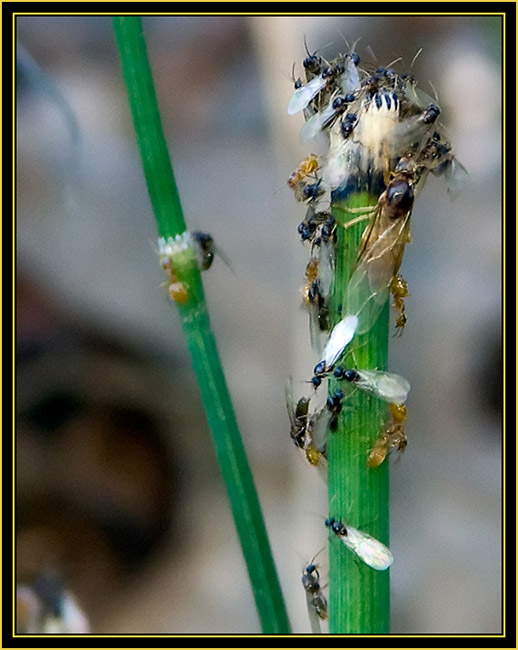
|
More Views of the Insect Activty
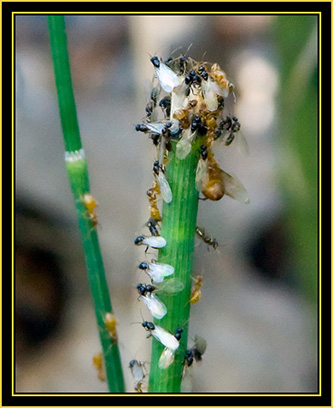
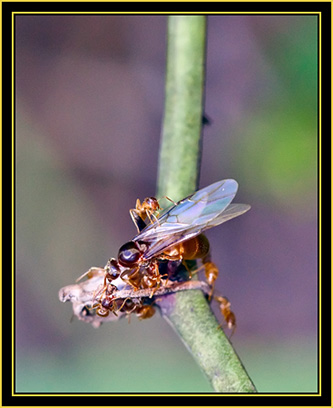
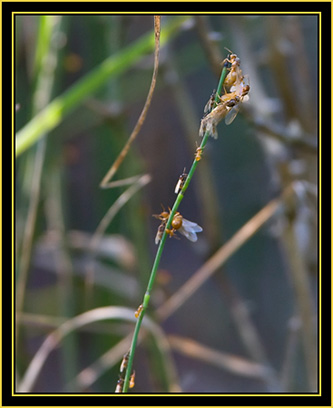
|
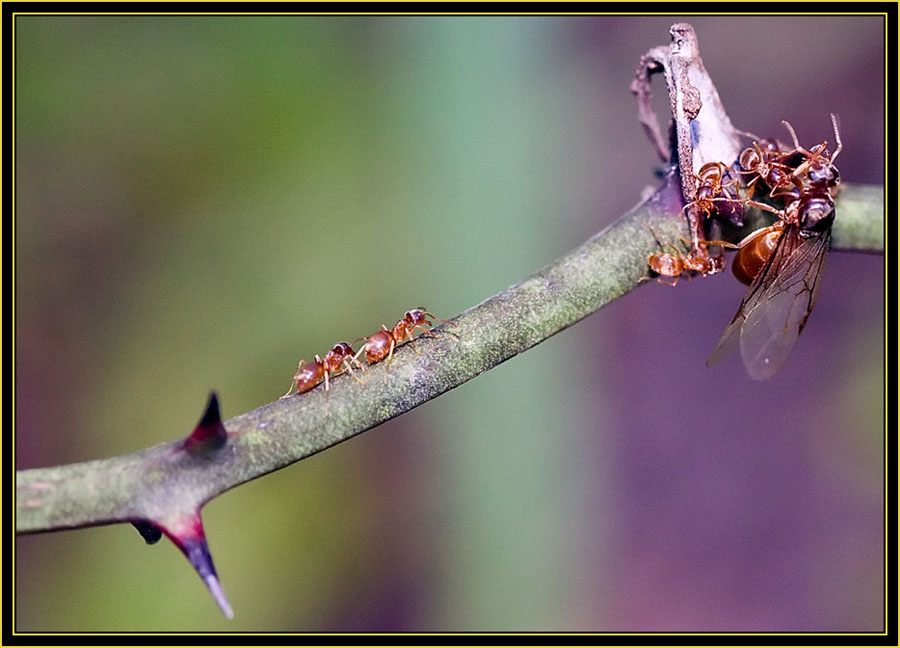
|
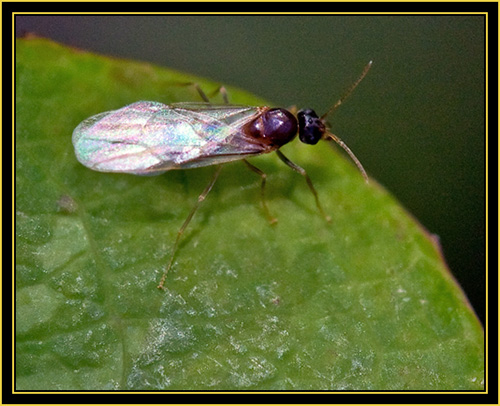
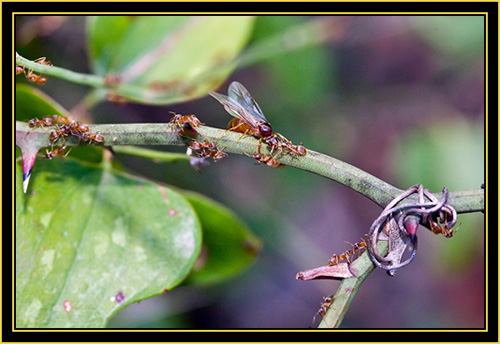
|
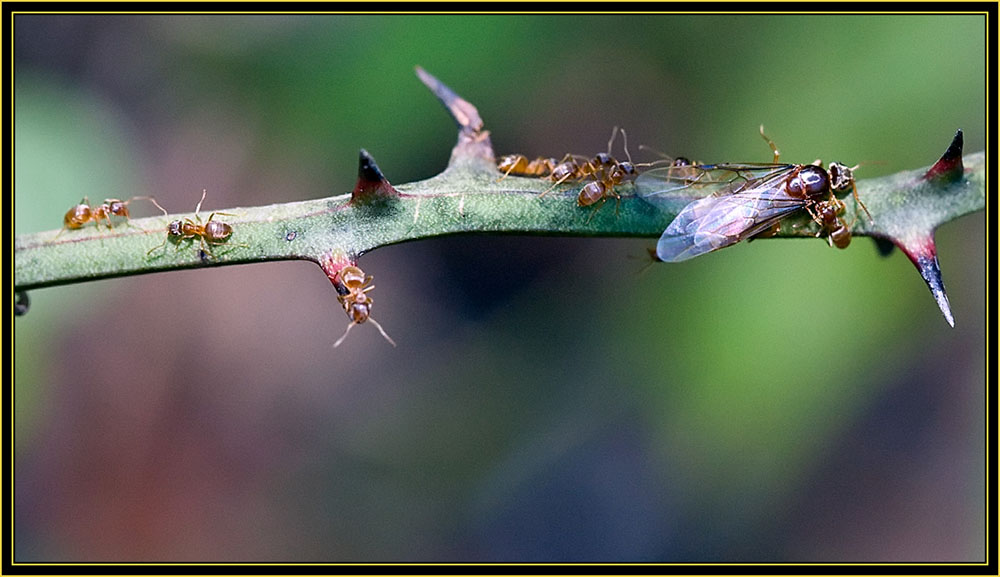
|
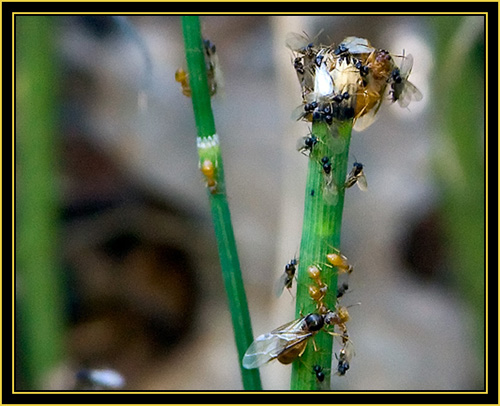
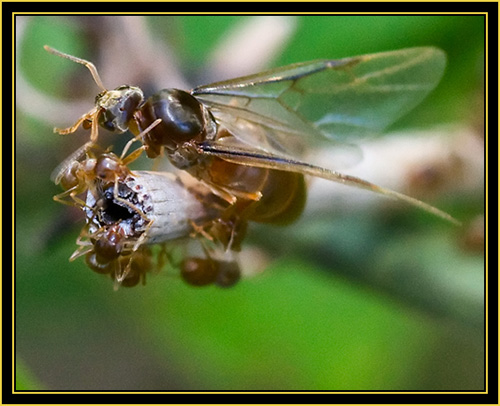
|
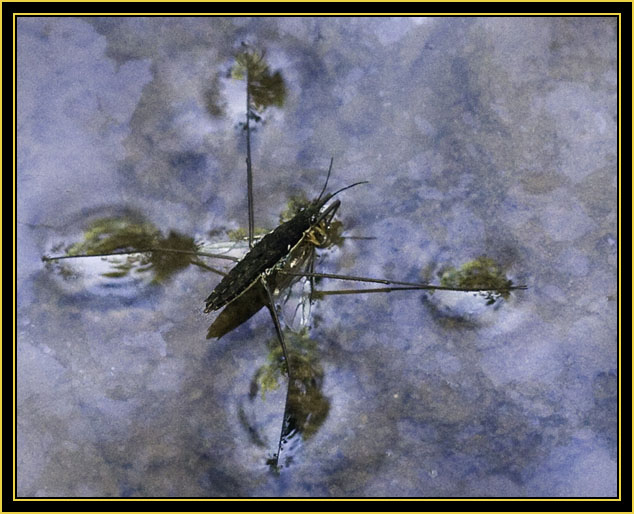
|
Other insects that caught our eye were the Common Water Striders moving about in the water not far off the concrete skirt. Using the same process as before I tried to photograph these at 840mm with the long lens and
flash extender. With Rob’s help calling out location and movement on the striders I was able to obtain some images on a group on one side of the road. Afterwards I moved to the opposite side, pulled the camera and
mounted it on the ballhead tripod and got close with a macro lens. By now the lighting was extremely dim so I either had to crank the ISO or give it up – I maxed out the ISO and kept shooting although this generates
a lot of image noise… None of this was especially easy to accomplish as the insects moved around quite a bit and the shutter speed was slow. I could get reasonably close on the macro shots but didn’t go into the
water as the subjects weren’t about to have me walk up to them.
Common Water StriderCanon EOS Mark III 1Ds, 1/250 second at 100mm; EF100mm f/2.8 Macro at f/5.6, ISO 3200 with FlashWater Striders have long legs that spread out their body weight allowing them to sit on the surface using the water’s surface tension. They are extremely quick and agile and can move rapidly on land as well. |
The Water Strider Files...
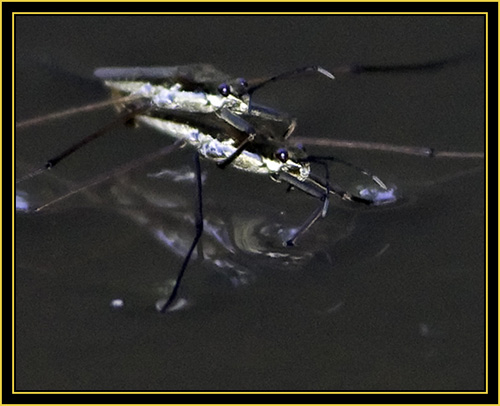
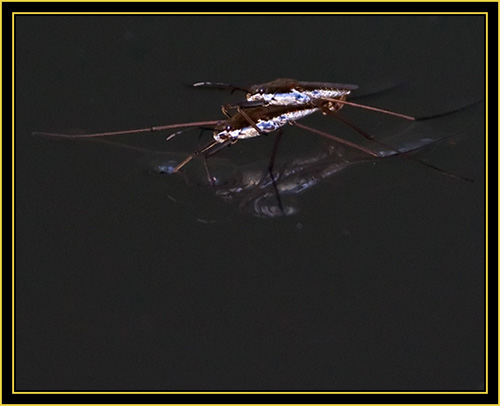
|
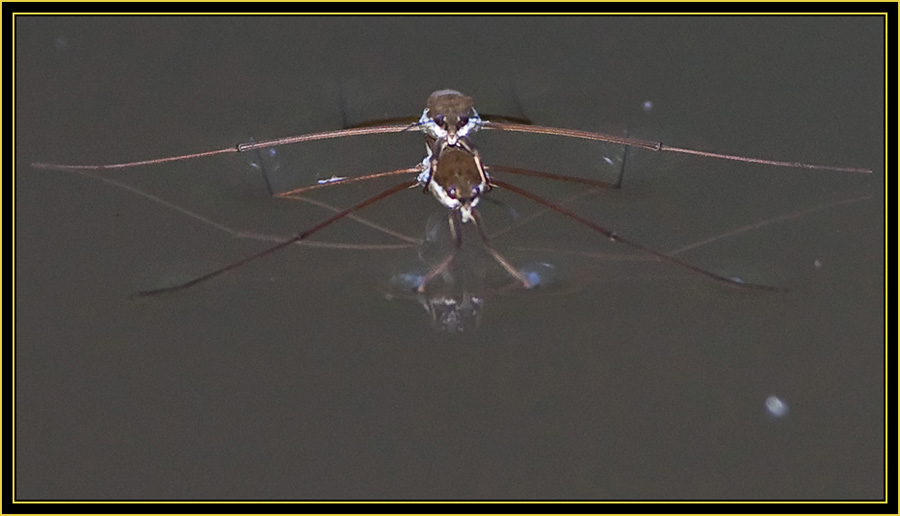
|
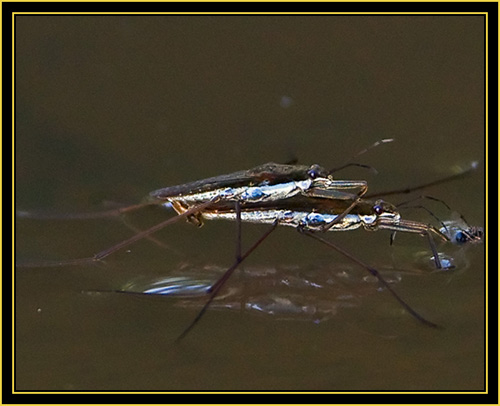
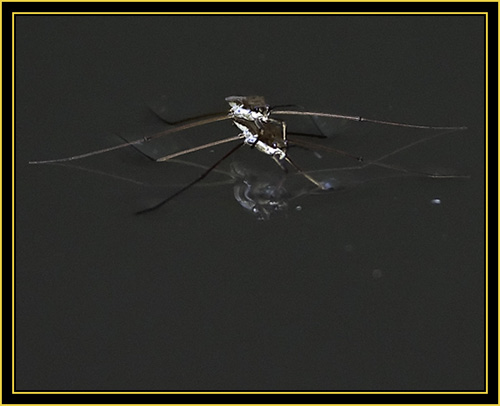
|
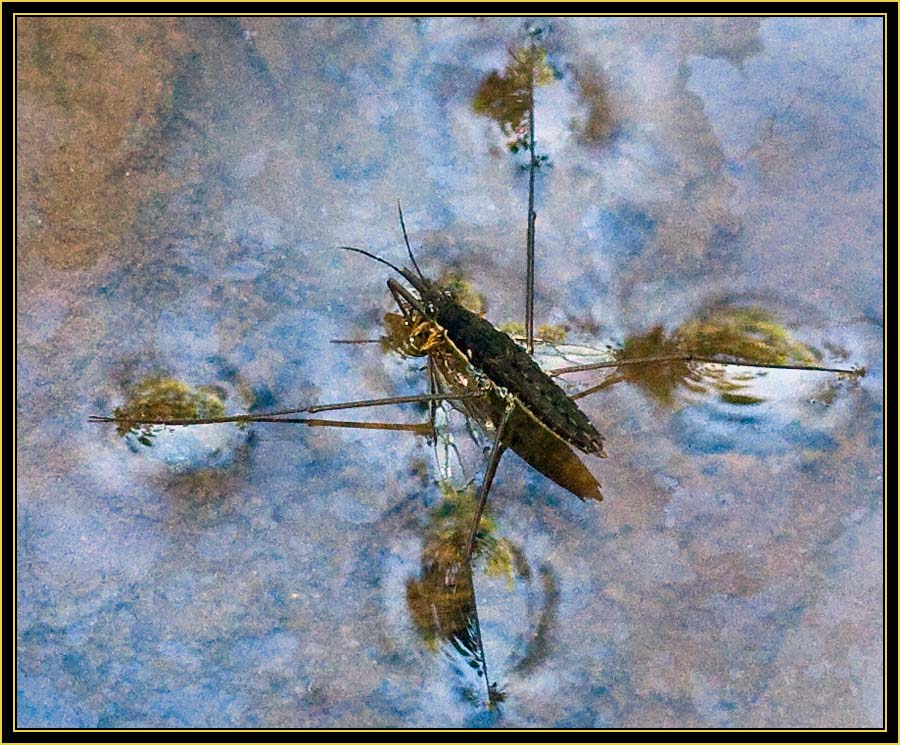
|
Before leaving this interesting location there is one more set of images I’d like to display… Ms. KK called me over to take a look at a Dung Beetle, who along with a group of smaller beetles was on the concrete
skirt going about their business. She asked me to get some photographs of these insects which I set up to do. I’m not real familiar with insect hierarchy and how things are done but as we
observed these critters we chuckled because it was pretty clear the large beetle had all the others working diligently. KK indicated this all seemed vaguely familiar and asked who I thought the large dung beetle
was in our group… I never did comment – hey, I’m just here to take photographs - but we had a good laugh about all this and it instigated a discussion that went on for some time with lots of good humor…
Ms. KK's 'Big Dung Beetle'...Canon EOS Mark III 1Ds, 1/250 second at 100mm; EF100mm f/2.8 Macro at f/5.6, ISO 3200 with Flash |
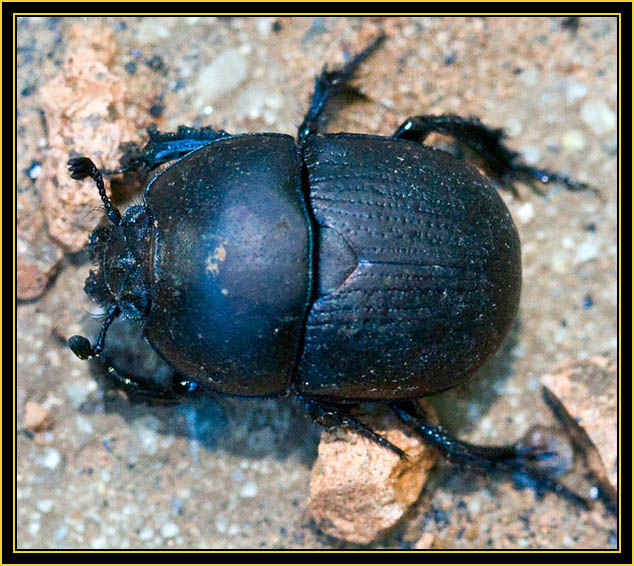
|
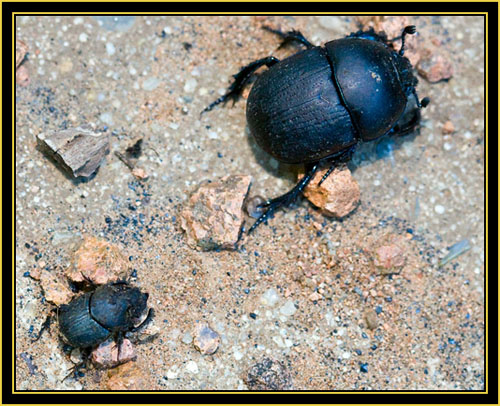
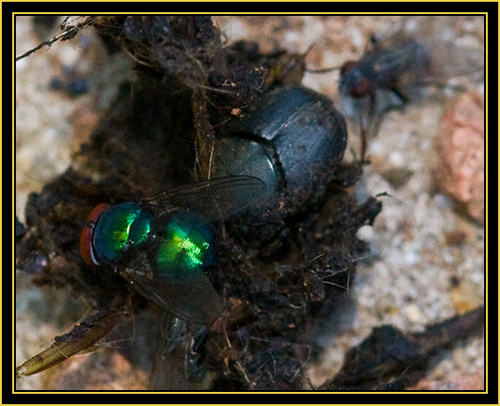
|
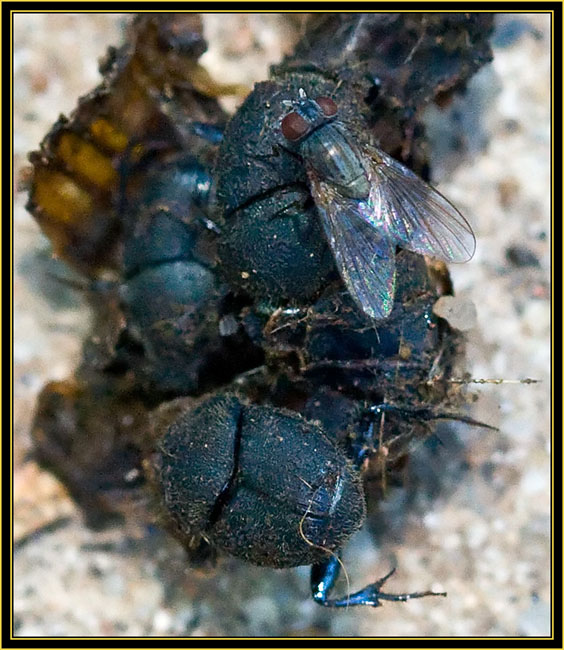
|
We packed up to move on… It was getting late so we determined it would be best to get to the last site of the day. Having an opportunity to get set up and reconnoiter the area before dusk is always a
good idea and this was the plan.... Nothing too pretty about the image at left but you must admit it is interesting - every picture tells a story...
Dung Beetles and FlyCanon EOS Mark III 1Ds, 1/250 second at 100mm; EF100mm f/2.8 Macro at f/5.6, ISO 3200 with Flash |
Apache Lake - Sunset & End of Day...
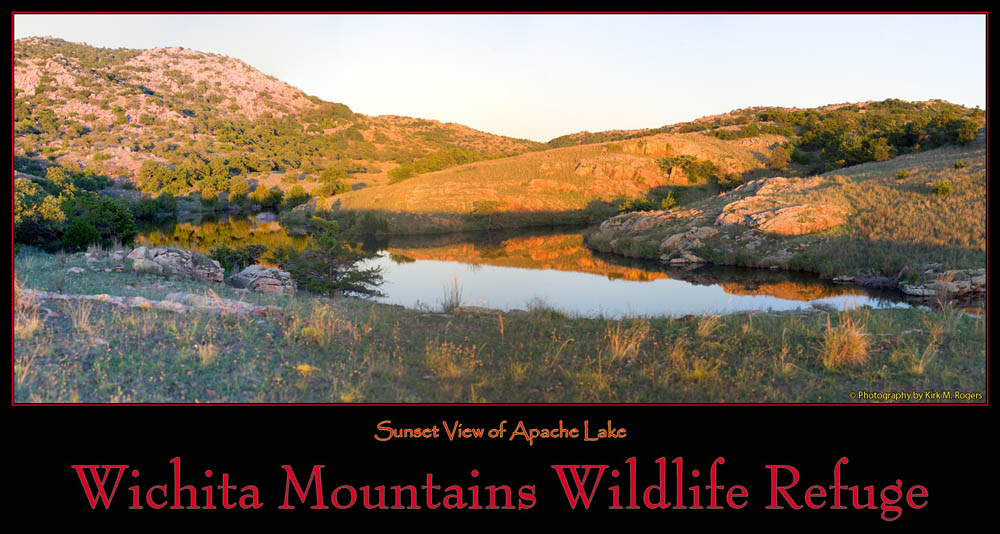
|
|
I believe it was approaching 7:00 PM when we climbed up the knoll at Apache Lake and checked out the westerly view. After we ascertained some idea about where the premier spot to set up the tripods may
be we decided to investigate the area. Just like everywhere else we’d visited in this beautiful refuge the photographic opportunities were all around us, but by now the light was starting to fail somewhat.
The moon was rising in the southeast. It was about a day beyond first quarter and I stopped to take few exposures. The moon is a beautiful telescopic object when in phase – if you’ve never viewed our moon through a telescope with good optics I urge you to find a way to accomplish this - I told Rob and Ms. KK that as an astrophotographer you learn think of the moon with disdain because when it’s up it washes out all the deep sky objects and serves as more of a nuisance than anything. Moonrise Over the Wichita MountainsCanon EOS 5d, 1/800 second at 70mm; EF70~200mm f/2.8L at f/10, ISO 640 |

|
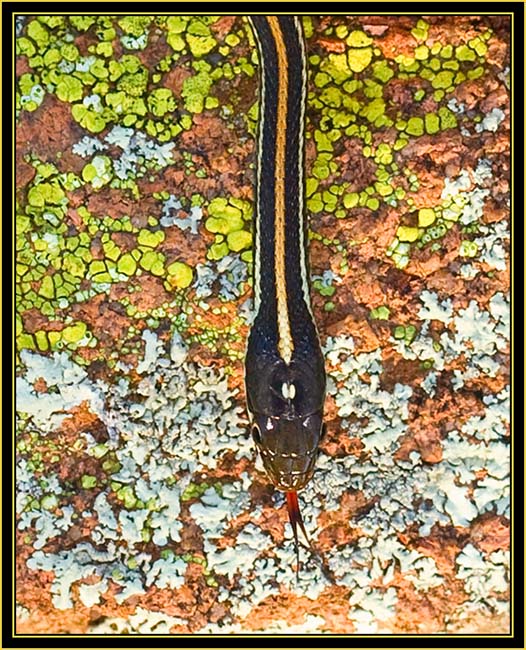
|
I changed over to the 100mm macro lens on the 1Ds camera, alternating with the 600mm on the tripod, and we went to see what we could find around the site. Rob viewed a small Garter Snake scurrying about. The snake was only interested in being left
alone and I asked Rob to walk by its path of retreat so it would turn and provide a possible imaging opportunity….
Garter SnakeCanon EOS Mark III 1Ds, 1/200 second at 100mm; EF100mm f/2.8 macro at f/5.6, ISO 1000 |
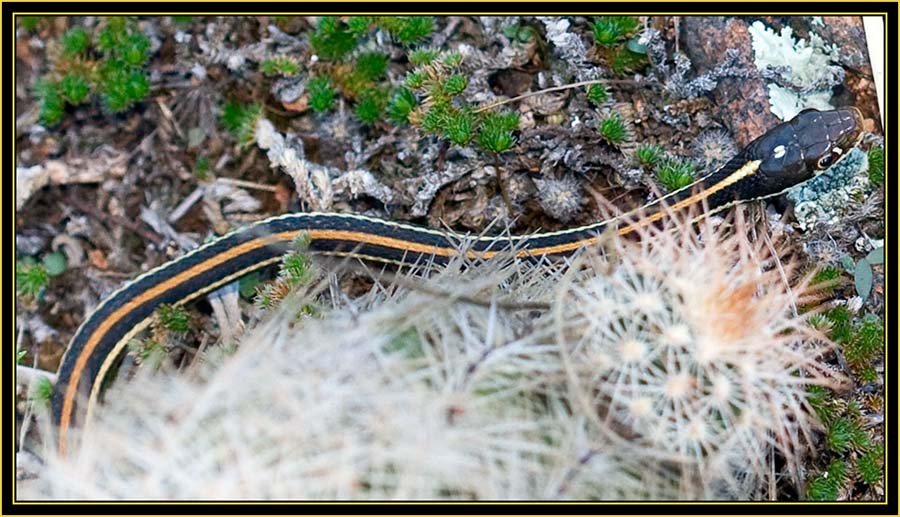
|
Looking up towards Mount Marcy and Wild Horse Canyon we viewed quite a bit of elk activity. We observed a group working their way down from the high ground and KK got Rob to do his famous elk call. in
the last few days I had learned these animals are vocal creatures and when Rob bellowed they generally answered. I told him I hoped he knew what the message he was conveying may be…
Elk on the HillsideCanon EOS Mark III 1Ds, 1/200 second at 840mm; EF600mm f/4L at f/8, ISO 1000 |
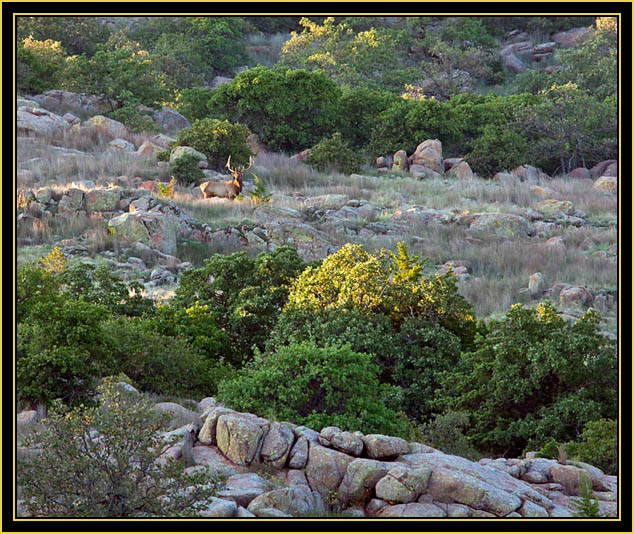
|
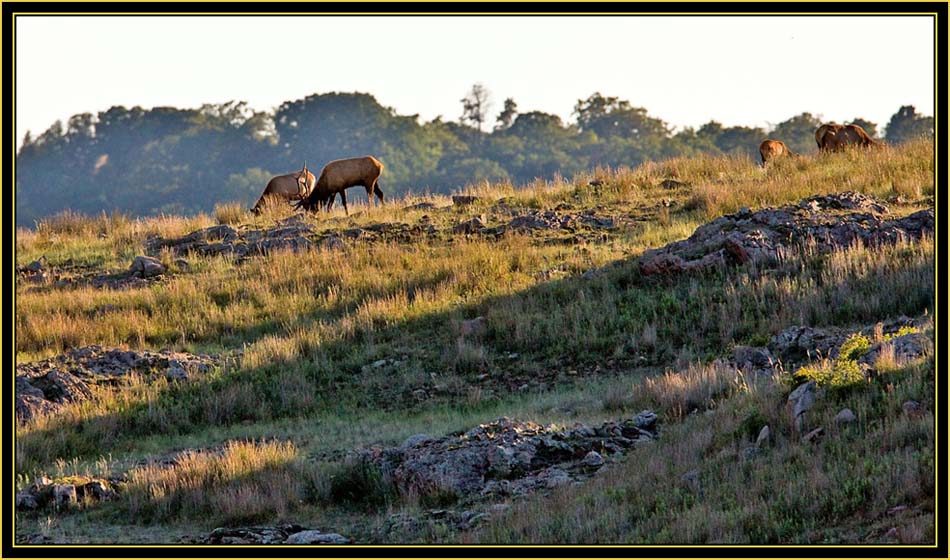
|
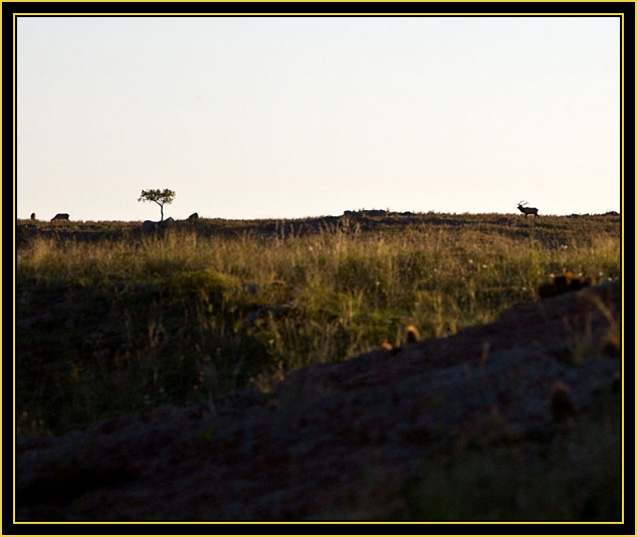
|
Apache Lake is a beautiful spot and we were enjoying the isolation – it was almost surreal as I looked around. With the sun dropping quickly, the shadow started to march down on the lake and I wished to capture
the reflections in the changing light. The image at the head of this section is a five shot vertical composite I shot as the sun was sinking. You can’t tell viewing the image but the print version of this is
about 16 inches by four feet ink size in the presentation print. I could be produced larger of course if desired…
Elk Bull on the SkylineCanon EOS 5d, 1/1600 second at 200mm; EF70~200mm f/2.8L at f/8, ISO 640 |
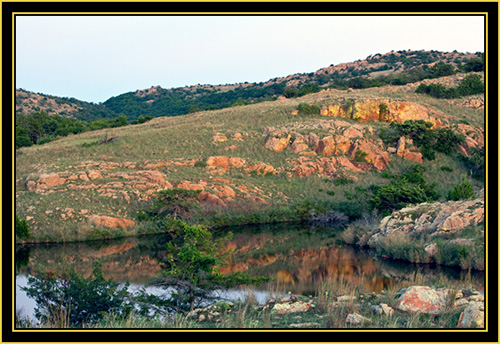
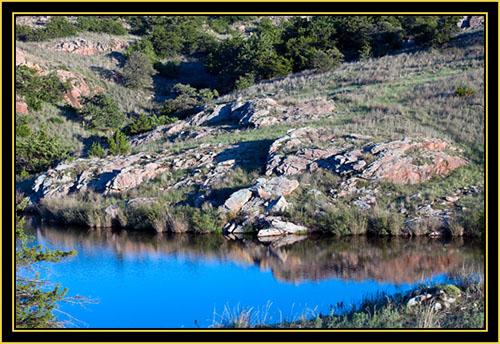
|
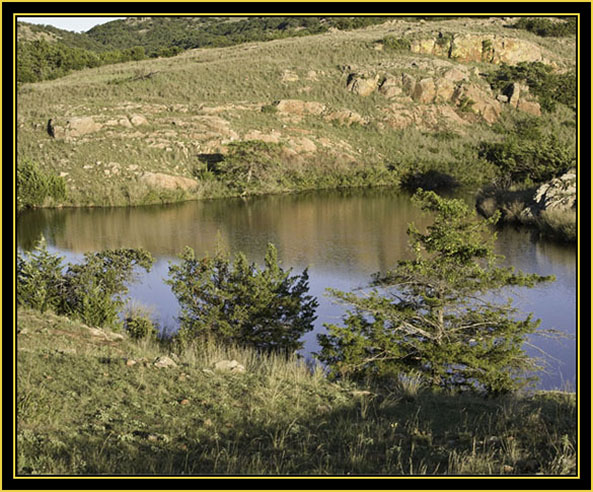

|
While I had the macro lens mounted I decided to take advantage of the available light and did some close up work with the cactus all around. The Barrel and Prickly-pear Cactus provided
opportunities while we watched and waiting for the sunset.
Barrel Cactus SpinesCanon EOS mark III 1Ds, 1/320 second; EF100mm f/2.8 Macro at f/5.6, ISO 1000 with Flash |
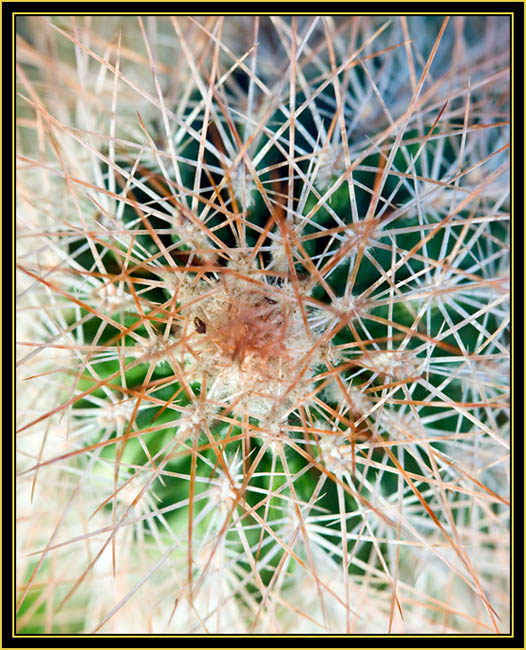
|
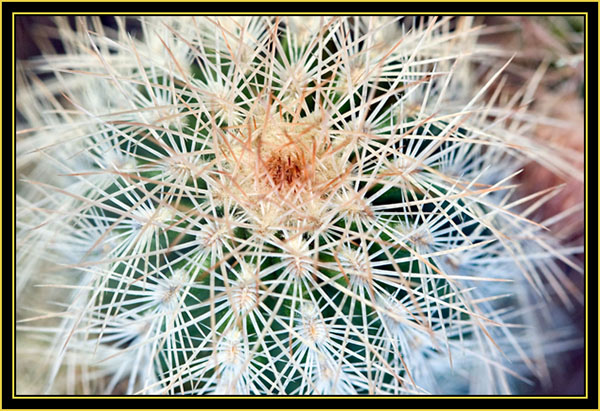
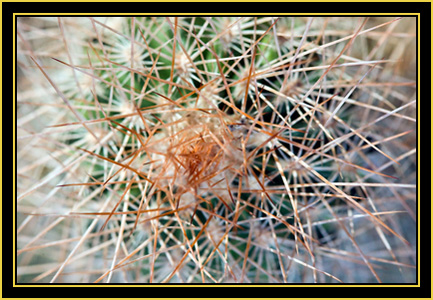
|

|
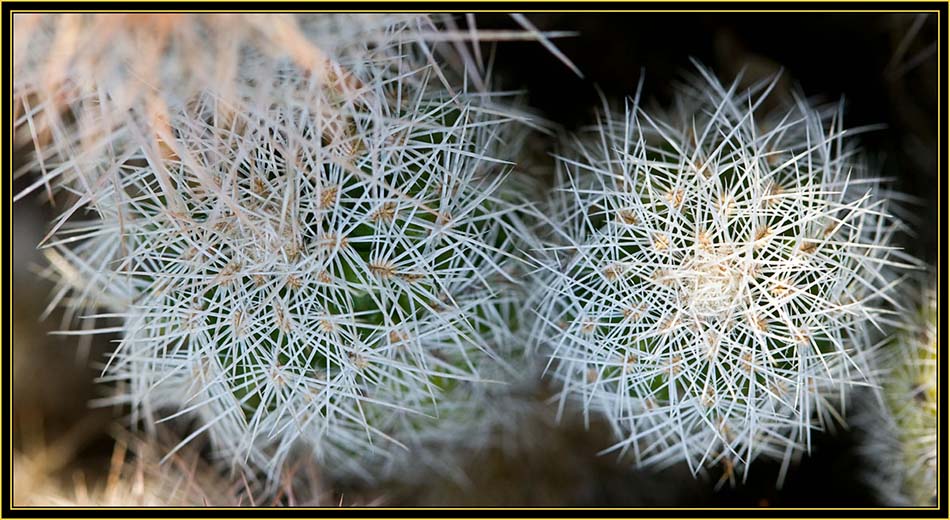
|
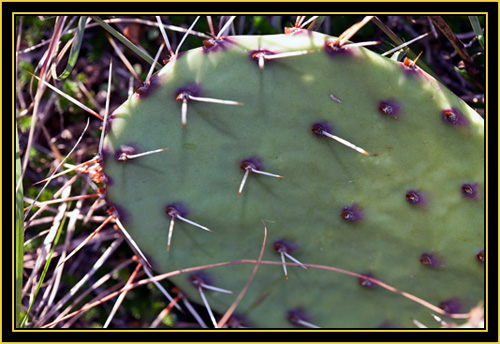
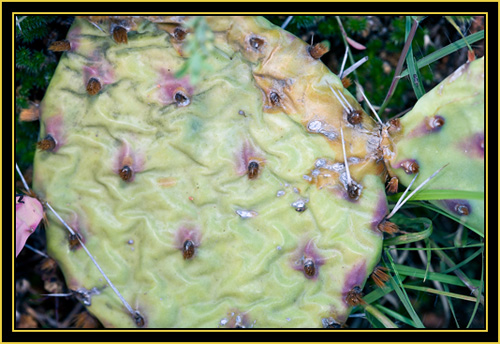
|

|
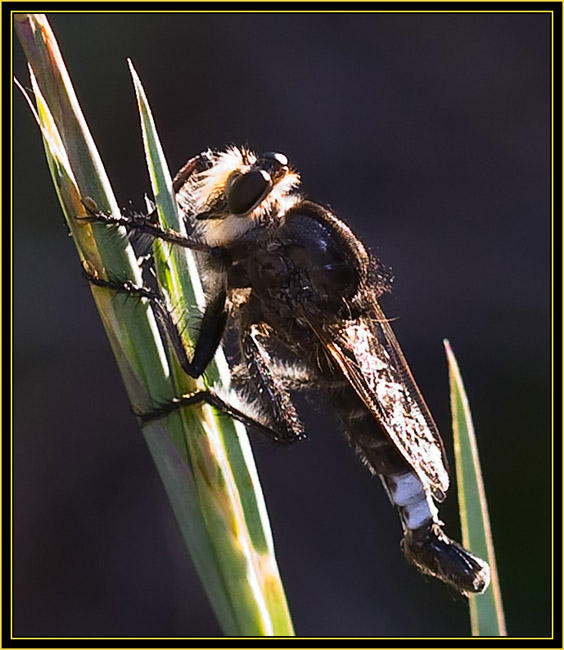
|
We were always on the lookout for insects and found a few interesting examples as we walked the grounds. I’ll post a few more macro shots here before we decided to camp out & wait for the sunset as the sun drops
quickly with little time to photograph the event. It pays to be ready…
Assassin BugCanon EOS mark III 1Ds, 1/200 second; EF100mm f/2.8 Macro at f/5.6, ISO 1000 with Flash |
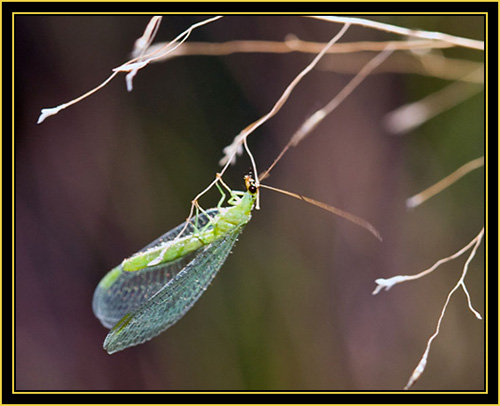
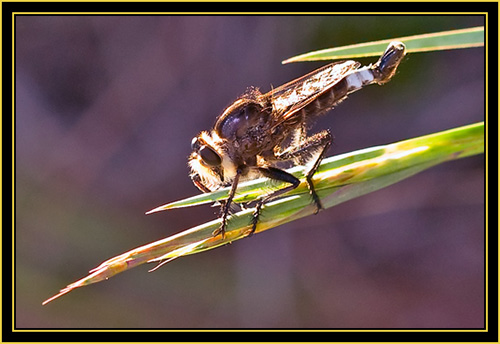
|
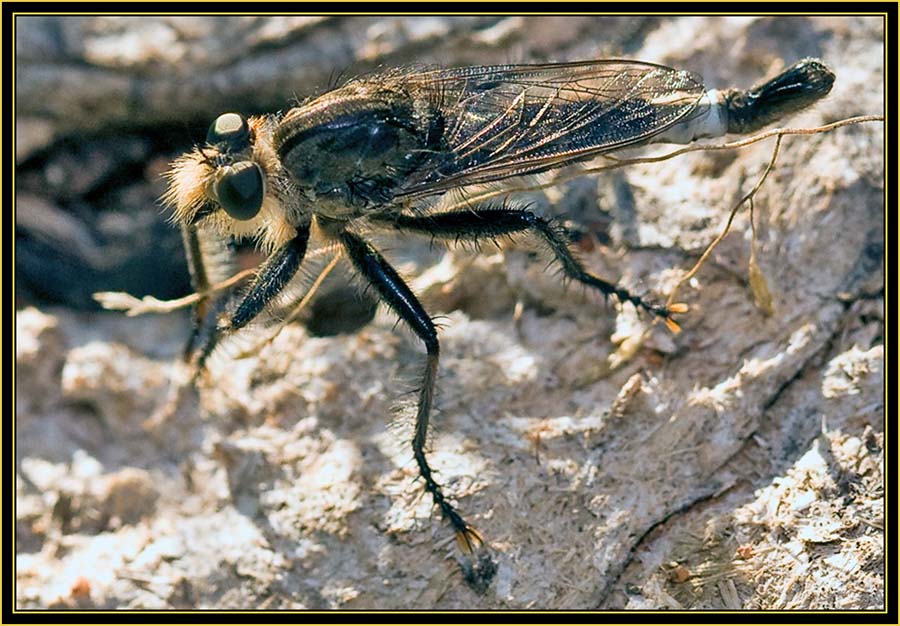
|
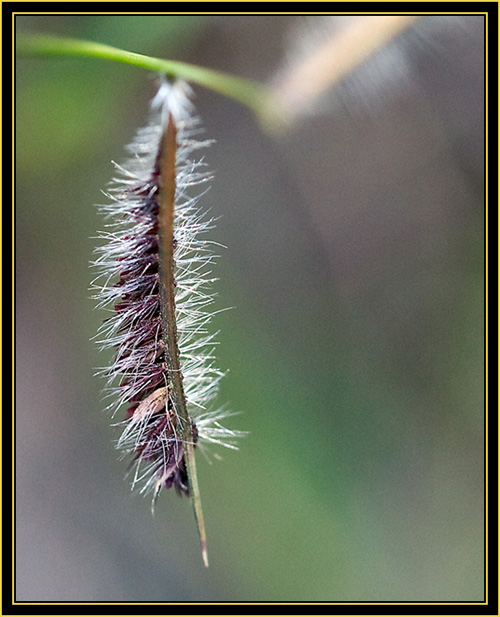
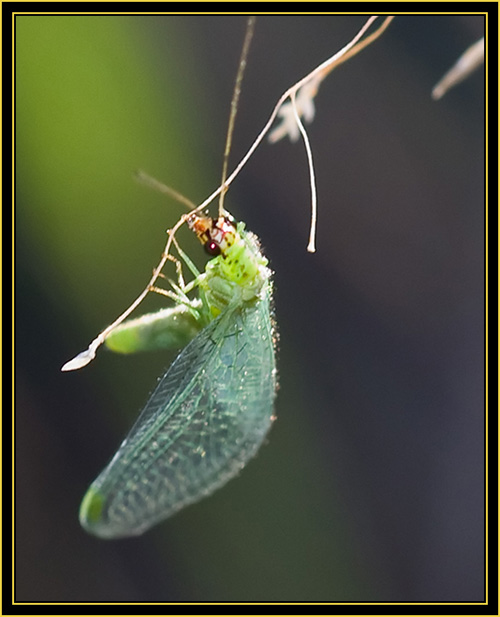
|
At right and below are images Rob took as we waited for the sun to drop below the mountains. In the shot at right Ms. KK and I are talking next to the ballhead tripod. The 600mm lens system is in the foreground
while Abigail sits on a blanket waiting. I have a knee pad on my right leg. I often wear one or both knee pads in the field if shooting low because it accommodates kneeling or crawling over rough ground. Bending
down on a rock or on ledge can be an unpleasant experience on your kneecap and this way you can maneuver wherever is best to take the exposure without that consideration.
Waiting for Sunset... |
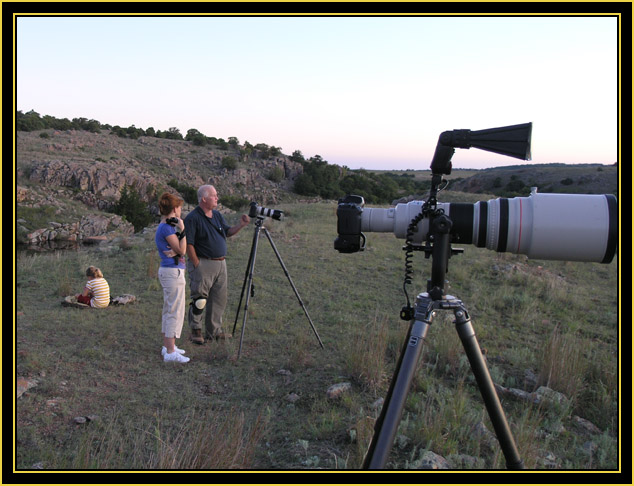
|

|
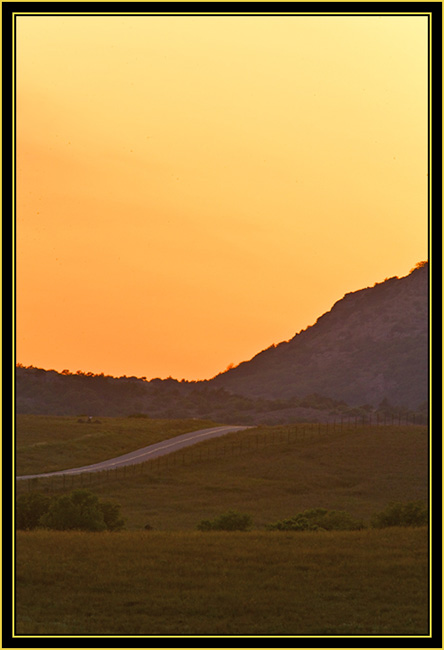
|
We watched for the few minutes when the disk dropped below the horizon and enjoyed the beauty of the mountains. As stated earlier, the actual event happens quickly and the margin between the sun being so bright it
will blow out a shot and losing it completely behind the horizon can be brief.
Mountain SunsetCanon EOS mark III 1Ds, 1/125 second at 840mm; EF600mm f/4L at f/16, ISO 1000 |
Wichita Mountains Sunset...

|

|

|
I took a series of shots post-sunset as the light changed and the sky darkened. After the disk of the sun was no longer in view I mounted the 1Ds camera on the ballhead tripod and the 70~200 lens to shoot wider
views. I’ll post some of these images to end our time in the field for this day…
Post Sunset...Canon EOS Mark III 1Ds, 1/200 second at 70mm; EF70~200mm f/2.8L at f/16, ISO 400 |
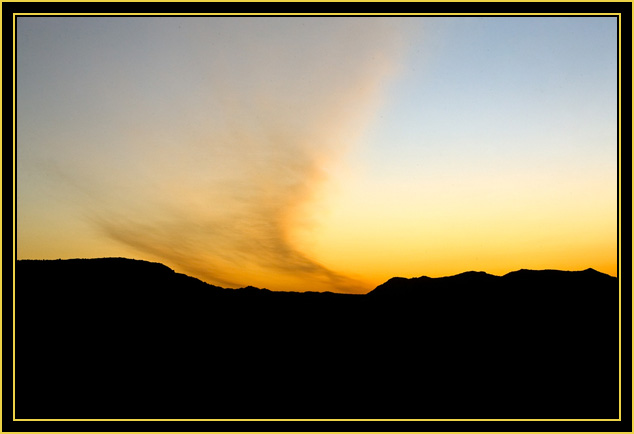
|
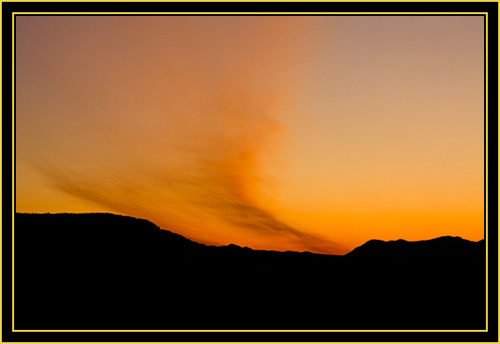
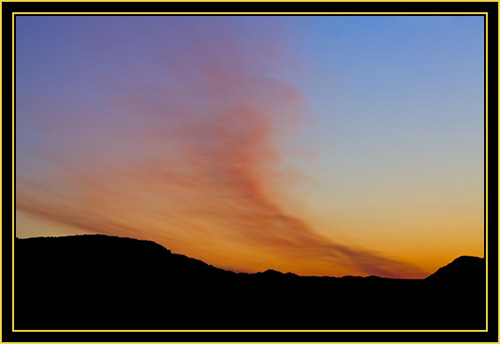
|
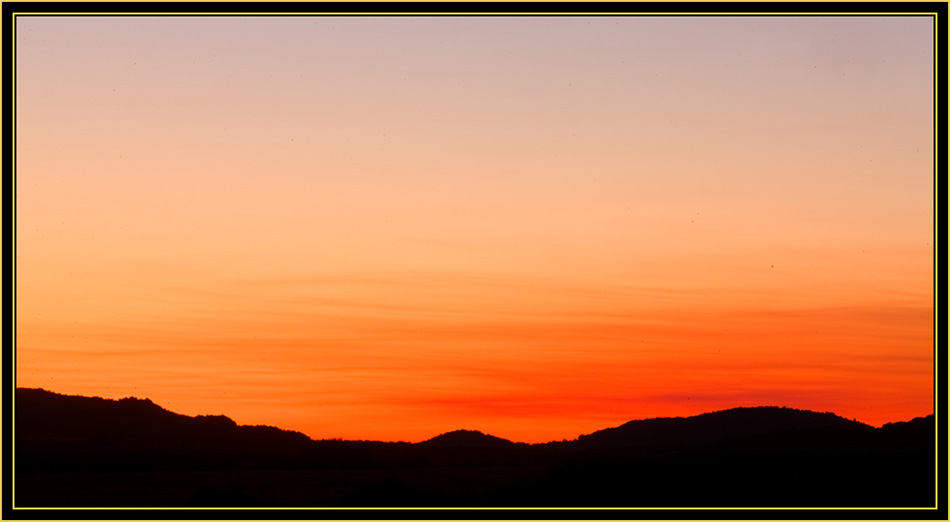
|

|
